Cecil’s Mission
If you try to go back into Baron Castle, the guards will stop you. Here’s a look at what they say in each version of the game:
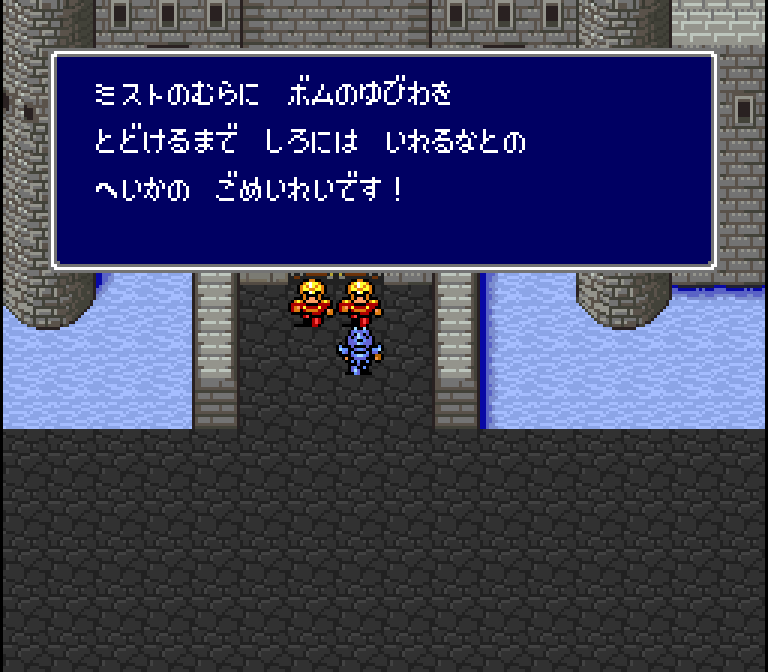 |  | 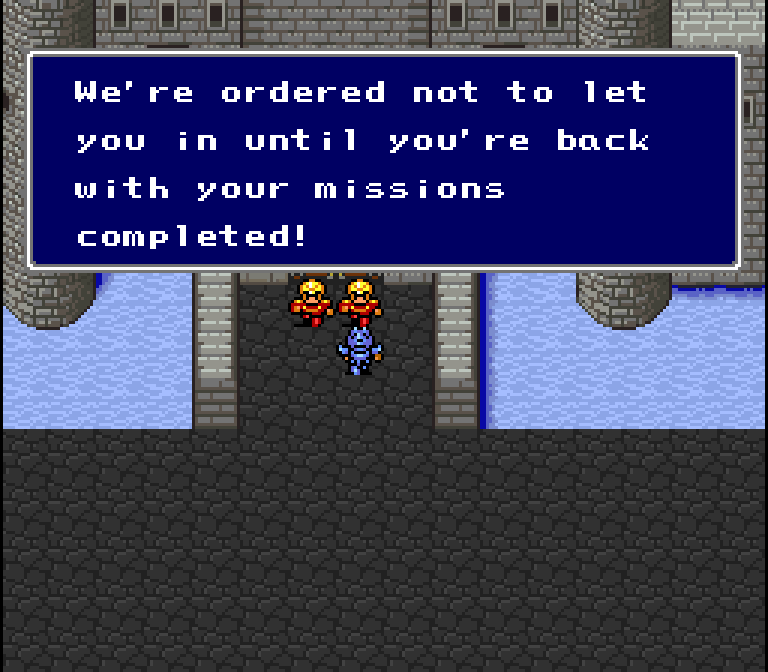 |
| Final Fantasy IV (Super Famicom) | Final Fantasy IV Easy Type (Super Famicom) | Final Fantasy II (Super NES) |
| Final Fantasy IV (basic translation) | Final Fantasy IV Easy Type (basic translation) | Final Fantasy II (Super NES) |
| His Majesty has ordered us not to let you enter the castle until you have delivered the Bomb Ring to the village of Mist! | His Majesty has ordered you not to return to the castle until you have delivered the Bomb Ring to the village of Mist! | We’re ordered not to let you in until you’re back with your missions completed! |
First, we see that the general scope of the message has changed in the translation – they simply say something akin to, “until your mission’s completed”. We saw this sort of change a few times already, so this change was likely a script-wise choice. The English translation also leaves out whose order it was, although that’s not terribly important.
Second, upon closer examination, we see that the two Japanese lines are a bit different. The original text means that the king gave these guards a specific order, but in Final Fantasy IV Easy Type it was changed so that the king has given Cecil an order instead.
So it’s interesting to see that the English line here is based more on the original Final Fantasy IV’s text.
Town Layout Change
Walking into Baron, it’s immediately clear that the town’s layout has been changed:
 | 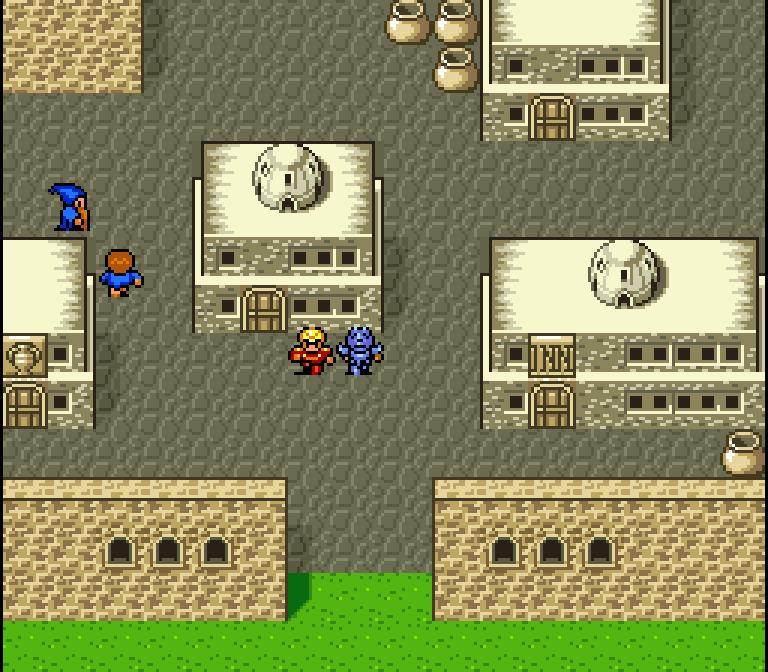 |  |
| Final Fantasy IV (Super Famicom) | Final Fantasy IV Easy Type (Super Famicom) | Final Fantasy II (Super NES) |
Upon closer look, we see that Easy Type and the SNES version have a different layout than the original version. For reference, here’s the full original map and the full altered map:
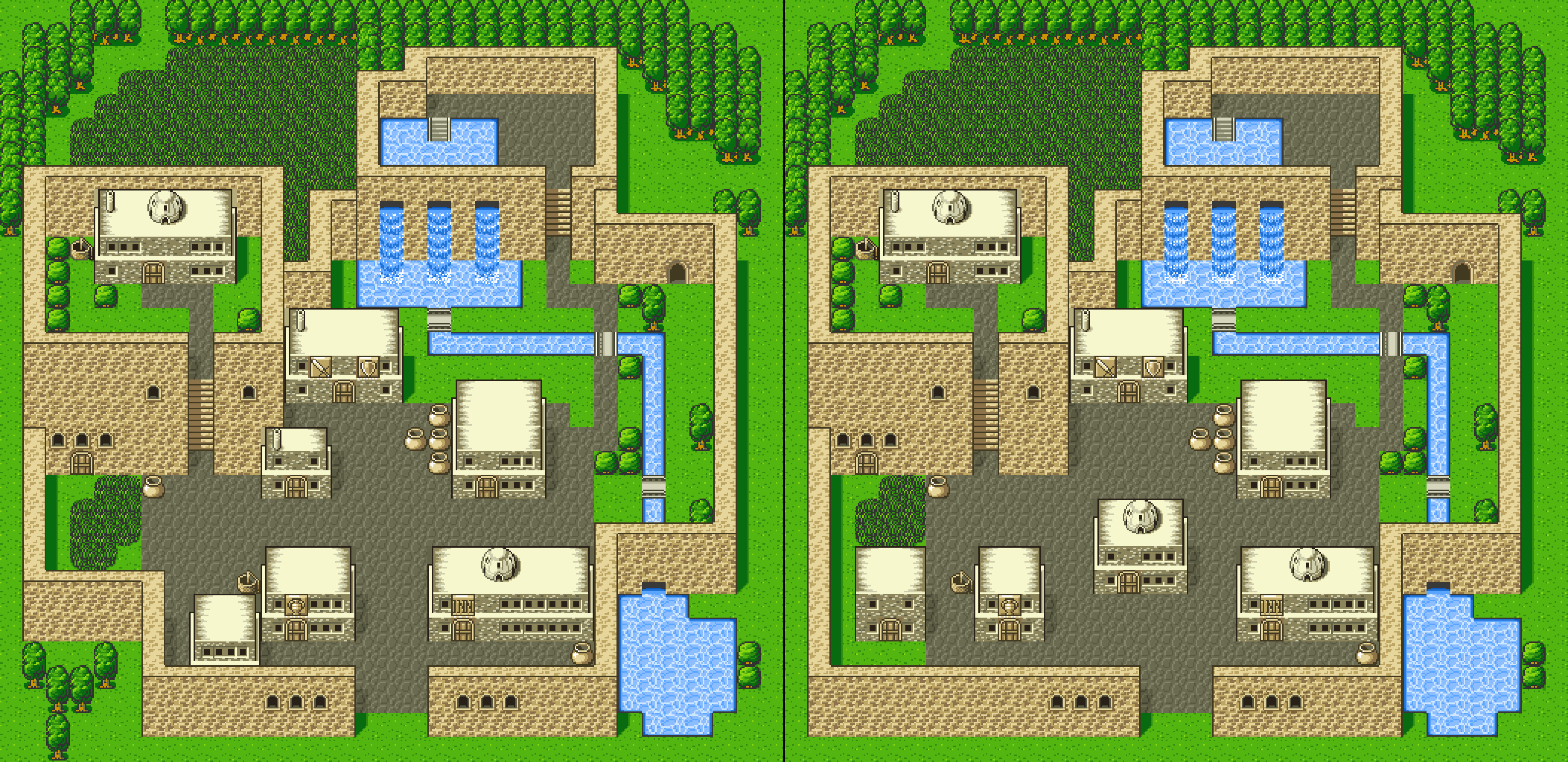
Here’s a quick list of the differences:
- The training room was given its own building and placed right in front of the town’s entrance
- The building containing the warp to Mysidia was moved from the center of town all the way to the bottom-left area
- An unused building in the original map was removed
- The well was moved a bit
- The grass was cut a little
- Trees were removed
- The item shop was made smaller
We’ll take a look at the purpose of these map changes in a little bit, don’t worry.
Also, I might be forgetting something in the list above, so if you spot any other differences, let me know!
Inn Sign
I remember wondering if the Japanese version of the game had a different “Inn” sign while walking around outside. Looks like they’re the same:
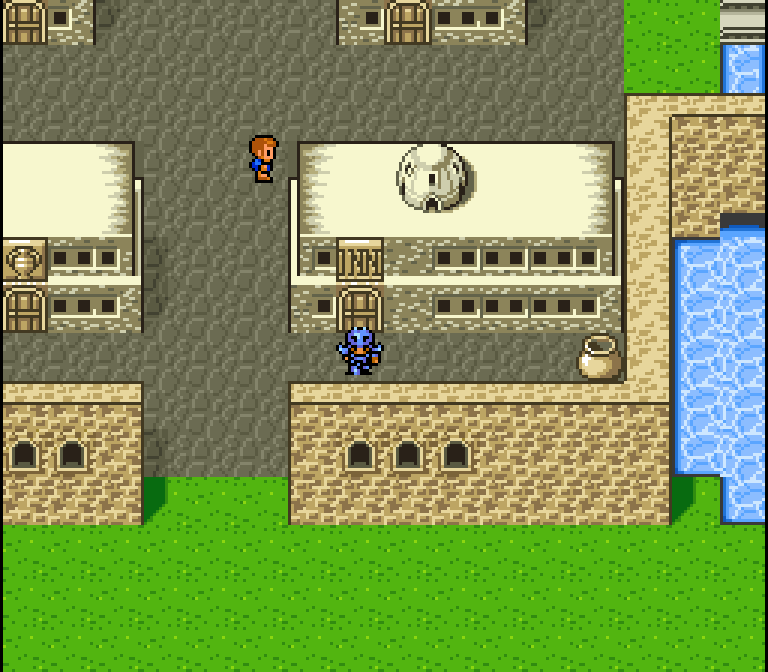 | 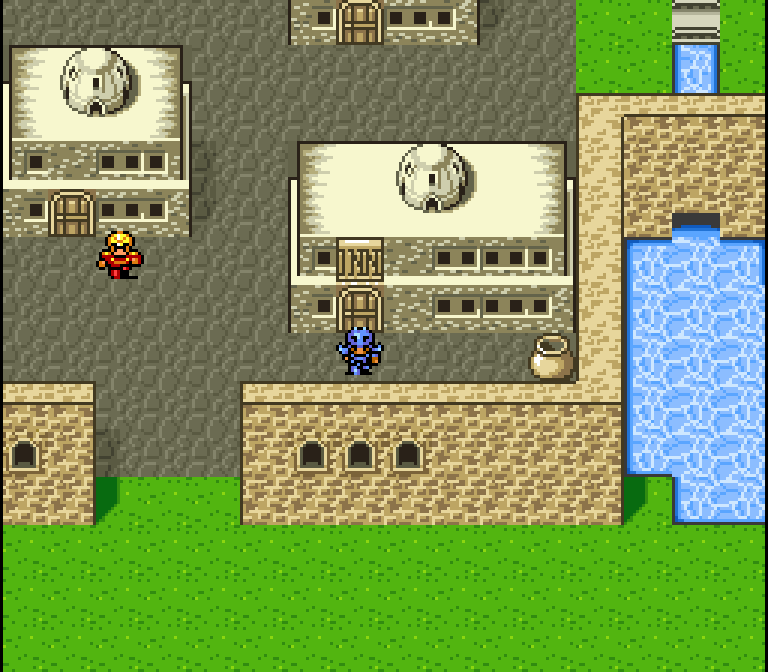 |
| Final Fantasy IV (Super Famicom) | Final Fantasy II (Super NES) |
But if you go inside, the Japanese version will say “Inn” in Japanese:
 | 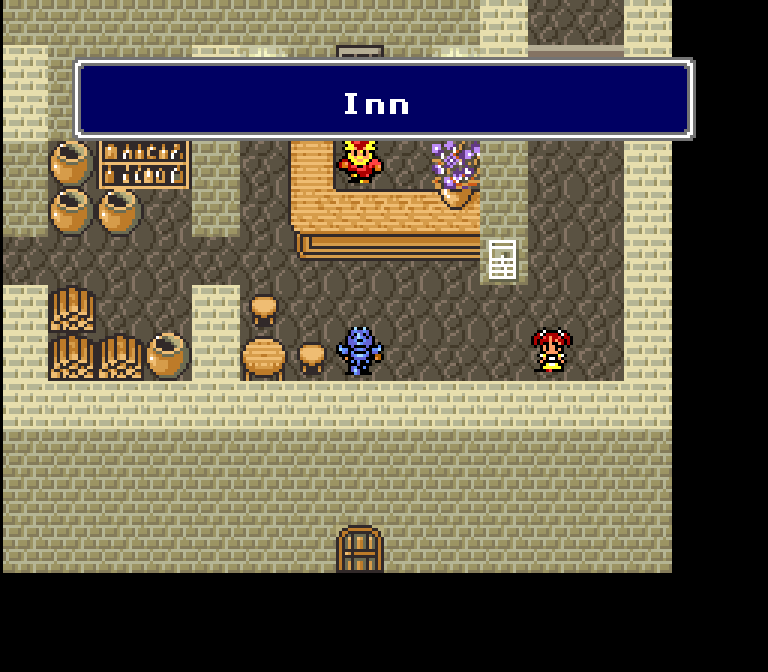 |
| Final Fantasy IV (Super Famicom) | Final Fantasy II (Super NES) |
It was always interesting seeing how different RPGs handled shop and inn signs. That and the different “sleep at the inn” songs every game had.
Inn Poster
There’s a poster on the wall of the inn that has an ad for new dancers. The text is very slightly different in the Japanese and English versions:
 | 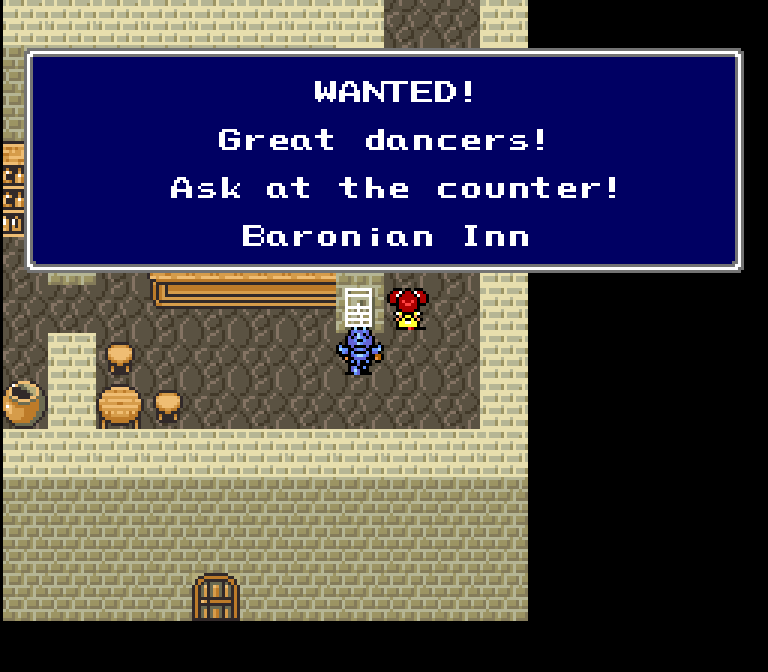 |
| Final Fantasy IV (Super Famicom) | Final Fantasy II (Super NES) |
| Japanese Version (basic translation) | English Translation |
| Dancing girls wanted! Seeking cute and skilled female dancers! Baron Inn Barkeeper | Great dancers! Ask at the counter! Baronian Inn |
I like how the localization centered the text to give it a more poster/flier-y feel. I also like the use of the word “Baronian” here rather than “Baron”. It sort of shows that the translators/localizers had some sense of what sounds good to native speakers’ ears/eyes.
Inn Girl
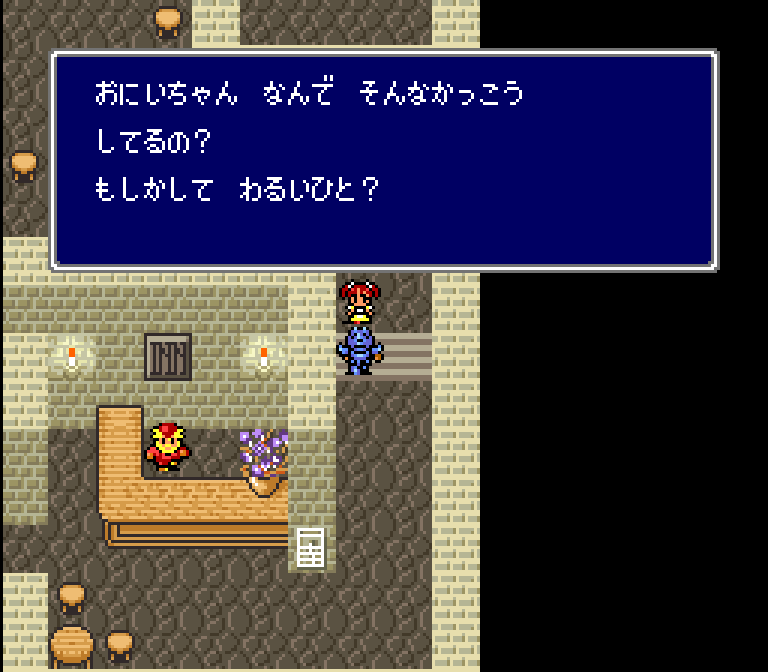 | 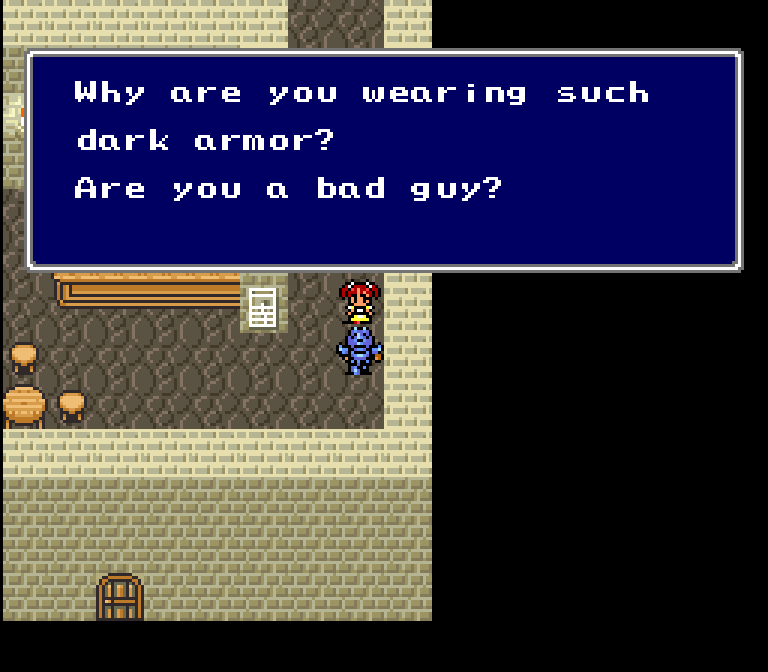 |
| Final Fantasy IV (Super Famicom) | Final Fantasy II (Super NES) |
In English, this little girl in the inn says, “Why are you wearing such dark armor? Are you a bad guy?”
In Japanese, she says, “Why are you dressed like that?” No specific mention of dark armor.
But the more interesting thing is that in Japanese, she uses the term “oniichan”, which means “big brother” but in this context is something you’d call a young boy or a young man in general, up into the early 20s or so I’d personally say (but it’s entirely subjective). So in this way it sort of gives the player the general sense of Cecil’s age. Apparently he’s 20 in the game according to non-in-game materials.
Mist Cave Guide
This man right in front of the town entrance gives you directions on where to go next in the game. Here’s a look at what he says in each version of the game:
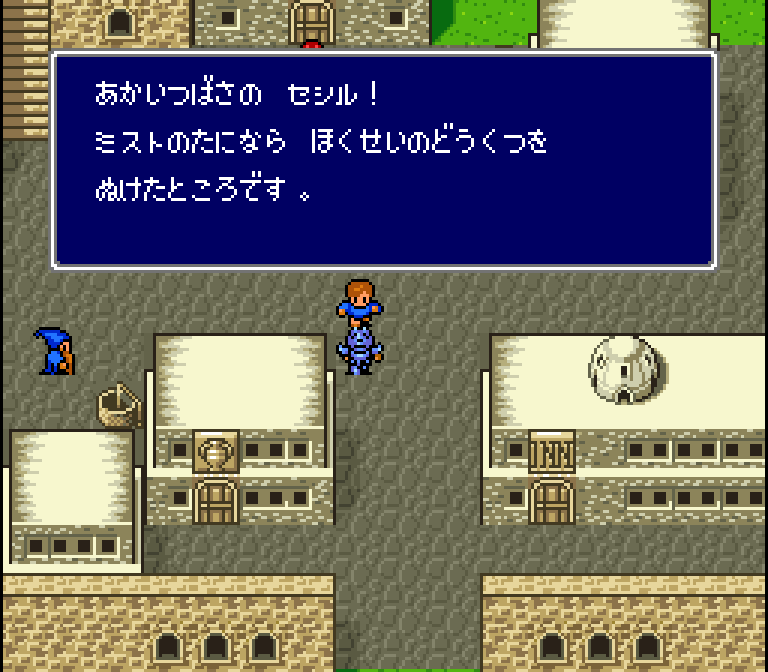 | 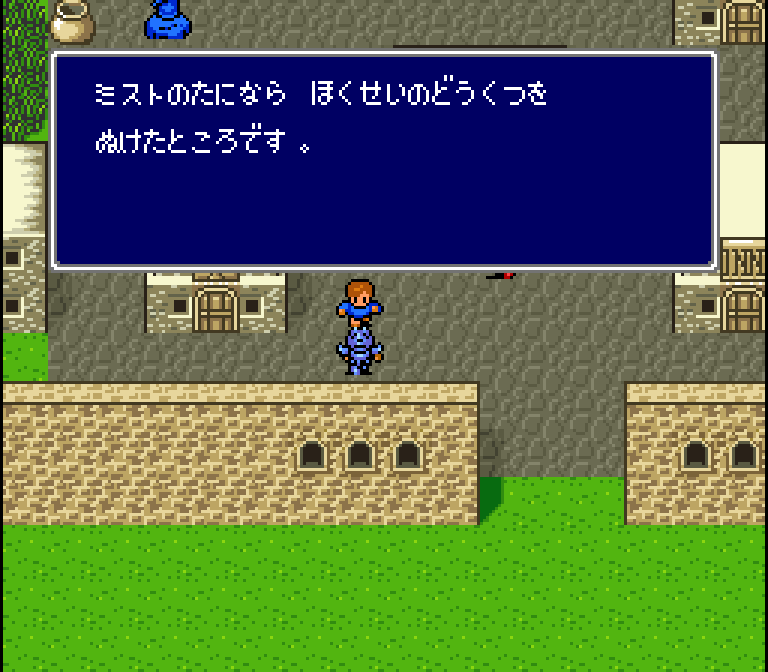 | 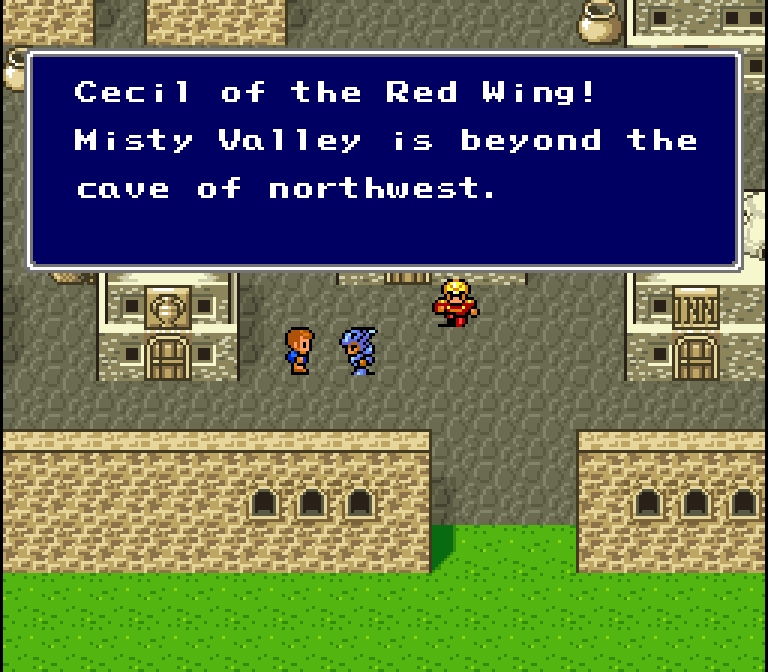 |
| Final Fantasy IV (Super Famicom) | Final Fantasy IV Easy Type (Super Famicom) | Final Fantasy II (Super NES) |
| Final Fantasy IV (basic translation) | Final Fantasy IV Easy Type (basic translation) | Final Fantasy II (Super NES) |
| Sir Cecil of the Red Wings! If you’re looking for the valley of Mist, it’s beyond the cave to the northwest. | If you’re looking for the valley of Mist, it’s beyond the cave to the northwest. | Cecil of the Red Wing! Misty Valley is beyond the cave of northwest. |
As you can see, the original Japanese version has him say Cecil’s name and affiliation, while Easy Type leaves that out.
What’s most interesting, though, is that the SNES version has the name and affiliation part included too. Until this point in the game, I was starting to think that the SNES version was either based on Easy Type or that Easy Type was based on the SNES version. But here we see that yet another English line is actually based on the original Japanese version. So it’s starting to look like the relationship between the three versions isn’t so clear-cut after all.
Item Shop Woman
This lady in the item shop gives some basic RPG advice. Here’s what she says in each version:
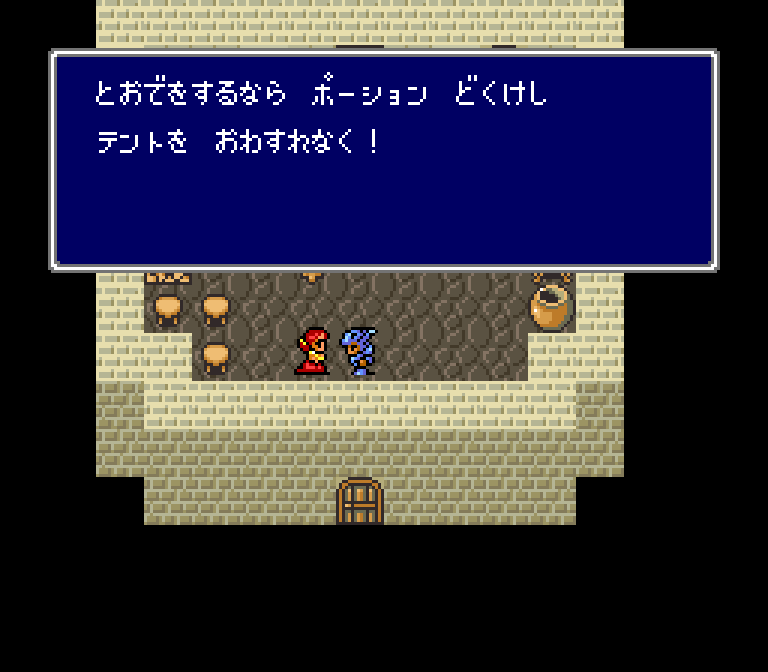 |  |  |
| Final Fantasy IV (Super Famicom) | Final Fantasy IV Easy Type (Super Famicom) | Final Fantasy II (Super NES) |
| Final Fantasy IV (basic translation) | Final Fantasy IV Easy Type (basic translation) | Final Fantasy II (Super NES) |
| If you’re going on a long journey, don’t forget Potions, Antidotes, and Tents! | If you’re going on a long journey, don’t forget Potions, Heal-All Medicines, and Tents! | Do not forget to take Cure1, Heal, and Tent! It’ll be tough outside of the town! |
The big difference of note is that “Antidote” has been replaced by “Heal-All Medicine” in Easy Type and “Heal” in the SNES version. This is due to the fact that healing items were consolidated and simplified in Easy Type and Final Fantasy II, as explained below.
Item & Shop Changes
 |  | 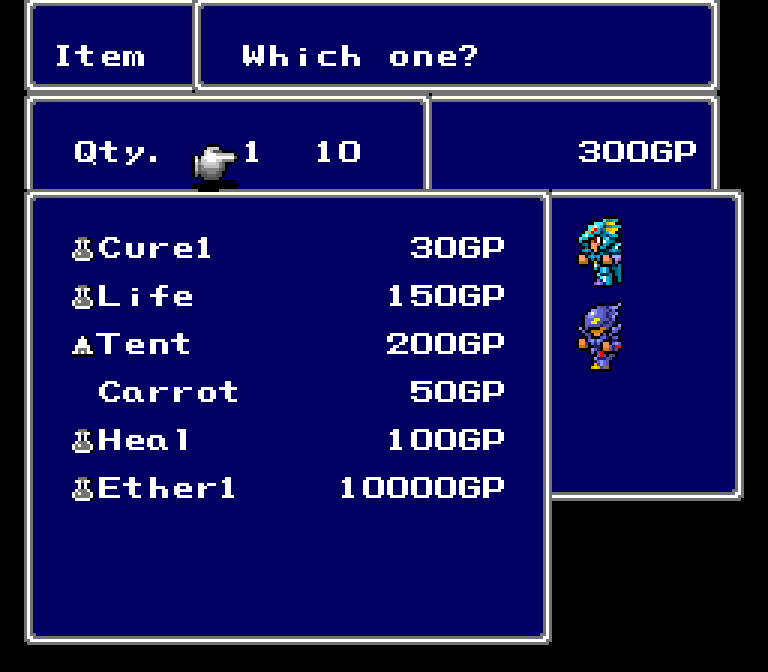 |
| Final Fantasy IV (Super Famicom) | Final Fantasy IV Easy Type (Super Famicom) | Final Fantasy II (Super NES) |
In the item shop we see that each version looks a bit different from the others. Here’s what the shop sells in each version of the game:
| Final Fantasy IV (basic translation) | Final Fantasy IV Easy Type (basic translation) | Final Fantasy II (Super NES) |
| Potion Phoenix Tail Gold Needle Maiden’s Kiss Eyedrops Antidote Tent Gysahl Vegetable | Potion Revive Medicine Tent Chocobo Vegetable Heal-All Medicine Ether | Cure1 Life Tent Carrot Heal Ether1 |
Pretty different! Besides the item consolidation, we also see that Ethers are now purchasable in Easy Type and the SNES version. Not that it matters, though, since they’re way, way too expensive to be of any help.
More importantly, many of the items in the original Japanese version heal specific status ailments – Maiden’s Kiss heals the “Frog” status while the “Eyedrops” heal the “Blinded” status.
This makes it a bit of a chore to deal with status ailments, so this system was simplified in Easy Type and Final Fantasy II – nearly every status ailment can be cured using a “Heal-All Medicine” or “Heal” as it’s called in Final Fantasy II.
Don’t worry – we’ll take a much more detailed look at these status ailments later on. We’ll also look at the differences in all the item names and such at another time, on another page.
We can also see that the English localization included item icons next to each name. This was a common practice back in the day when screen space was limited. By using simple icons, localizers could free up text space to better describe the item in question and not have to resort to crazy names. In fact, the first Final Fantasy’s localization used this same approach:
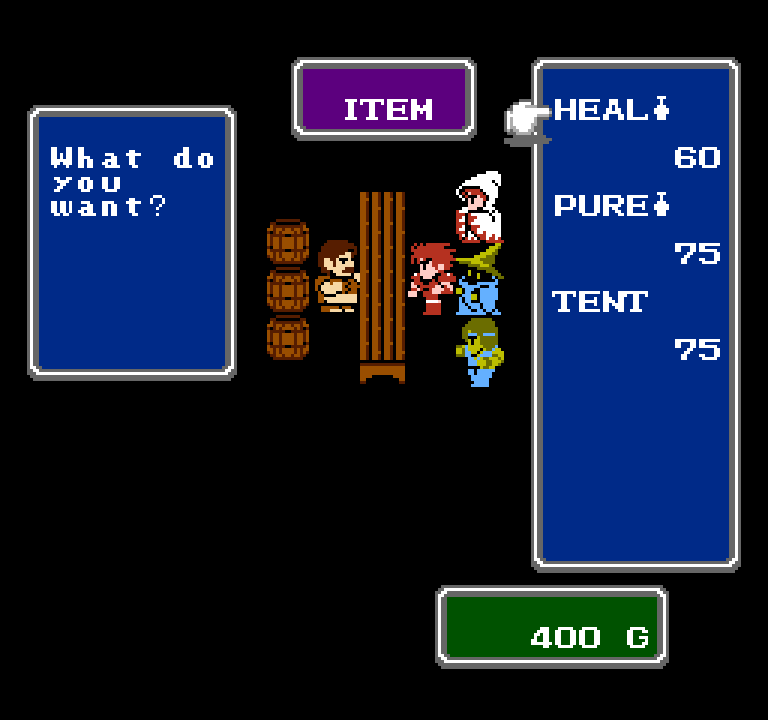
While we’re here, here’s a look at what the shopkeeper says. In English he says, “May I help you?”
Since it’s possible to say more with fewer characters in Japanese, he says more than that: “Welcome! What can I do for you?”
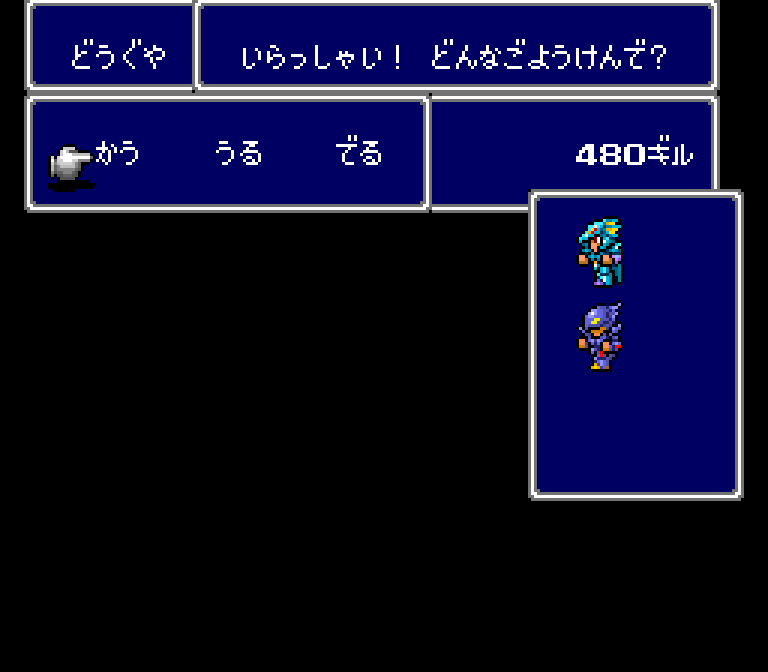 | 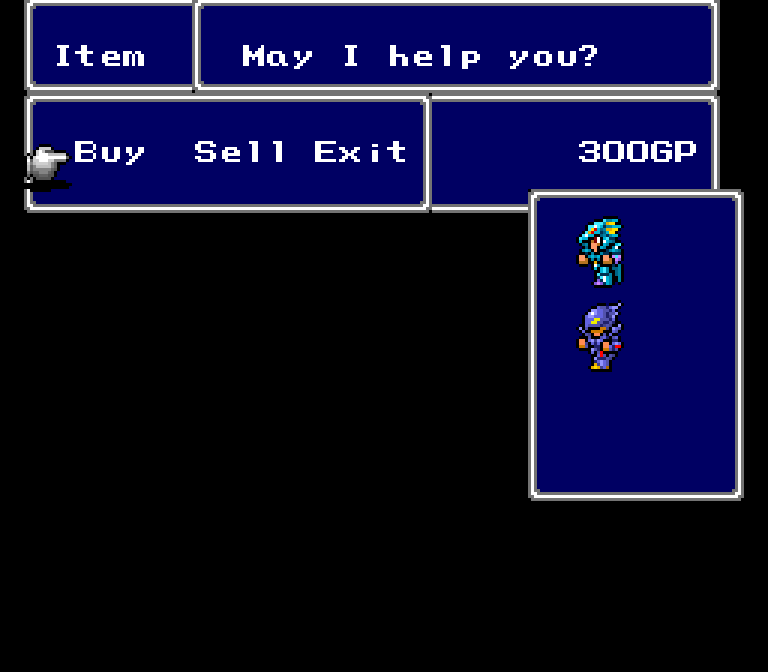 |
| Final Fantasy IV (Super Famicom) | Final Fantasy II (Super NES) |
Worrying Woman
This lady in Baron warns you not to go to Mist:
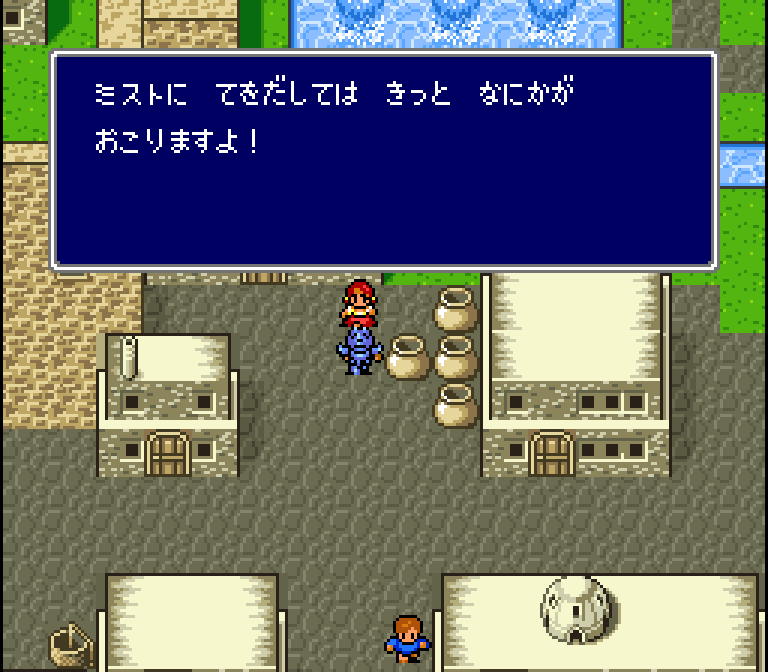 | 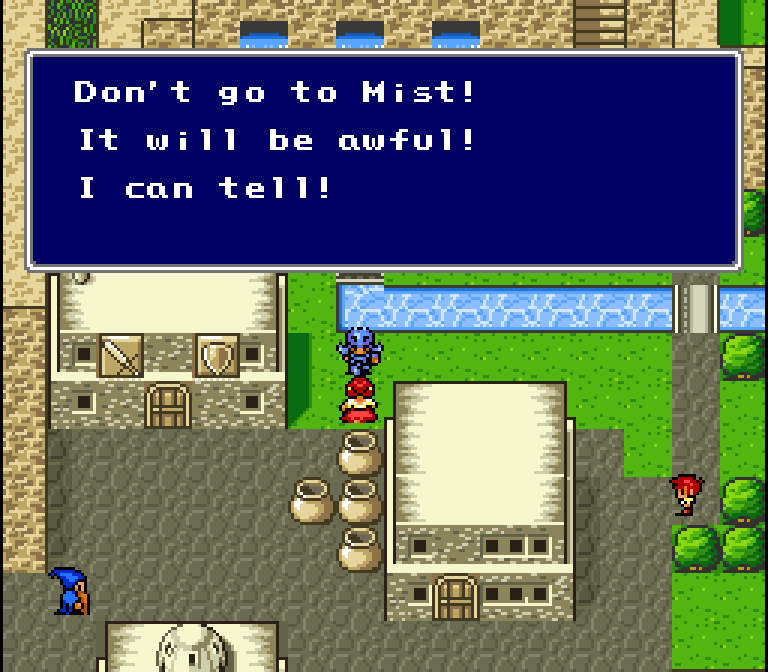 |
| Final Fantasy IV (Super Famicom) | Final Fantasy II (Super NES) |
In English, she says, “Don’t go to Mist! It will be awful! I can tell!”
In Japanese, she says, “If you mess with/do something to Mist I just know something will happen!”
It’s picky, but the original line has the nuance that she thinks he’s going to Mist to do something bad to the village. Which is understandable, given what the King’s been doing lately.
Articles in English
A little kid in Baron is both scared of and in awe of Cecil. His line is essentially the same in English and Japanese, minus some minuscule writing nuances, but I wanted to point out something that’s common in these old Japanese RPG translations: the improper use of articles.
 | 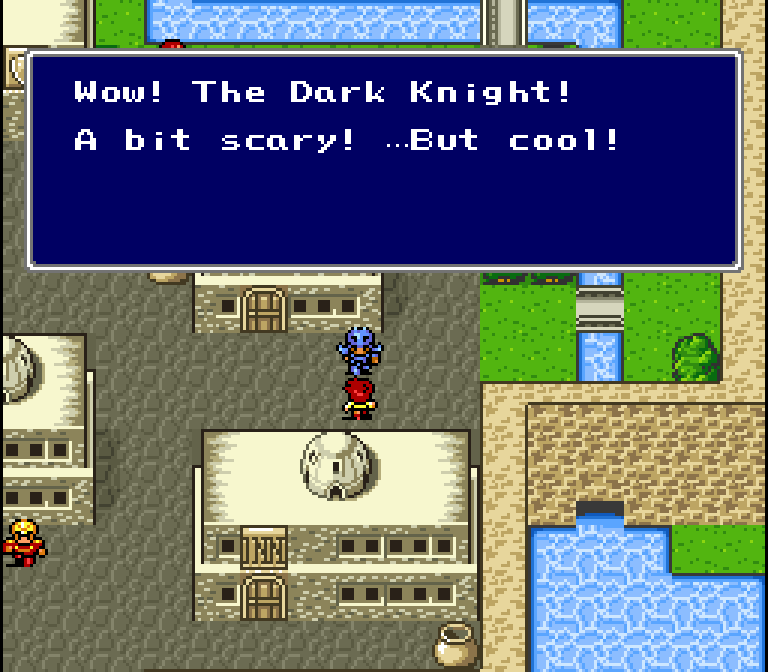 |
| Final Fantasy IV (Super Famicom) | Final Fantasy II (Super NES) |
Basically, Japanese is a very different language from English, and one thing that’s a big hurdle for Japanese natives is the proper use of “a/an/the/some” and all that. We native English speakers can use these without even thinking, but it’s actually pretty tough to teach. As such, a lot of translations by non-native speakers will have lots of problems with “the”.
This line, “Wow! The Dark Knight! A bit scary! …But cool!” is proper grammar and all, but in this context it’s not quite right – it should be “A Dark Knight”. I suppose it’s possible that Cecil’s the only Dark Knight around, but given the fact that Kain said he could become one himself and the fact that this same article mistake happens throughout the translation, I’m pretty sure it should be “a” here.
This same mistake happens throughout Final Fantasy II’s translation, but I won’t mention it often anymore unless it’s particularly noteworthy.
For reference, my own literal translation of this line might be something like:
Whoa, a Dark Knight! Scary! But kinda cool too…
I can actually hear how the Japanese line would be said by a little kid or a voice actor, it’s a nicely emotive line in Japanese. The “Scary!” part is said with an, “I’m scared!” sort of tone of voice too since “scary” and “I’m scared” kind of share the same word in Japanese.
Looking at Other Translations
I don’t know why, but for some reason I got the urge to see how the above line was translated in a few other versions of the game. Here’s the official PlayStation translation, the J2e fan translation (which was based on the original Super Famicom Final Fantasy IV), and the official translation used in the Game Boy Advance port of Final Fantasy IV:
 |  |  |
| PlayStation translation | J2e fan translation | Game Boy Advance translation |
It’s interesting to see that the J2e version is pretty much indeed a literal translation, while the GBA translation has a lot more flourish to it, chiefly by including a reference to an old Internet meme. It’s personally not my cup of tea, but I know some people like their translations that way – the Lunar games for PlayStation come to mind. It’s also interesting to see that the GBA translation has taken out the whole aspect of the kid being scared of Cecil/Dark Knights. I don’t know if that was on purpose or if it was a genuine mistake – the Japanese GBA line was unchanged from the original at least.
After playing the J2e translation a bit, here’s my take on it. Keep in mind it’s been touted for over 10 years to be the most definitive and accurate translation of Final Fantasy IV possible:
- In many places, the translation is indeed wonderfully accurate and faithful to the original text.
- In many other places, the translation is poor and error-prone.
- In many other places, lines are taken straight from Final Fantasy II on SNES, even though they weren’t in the original Japanese text at all.
- In numerous places, lines and text are completely made up out of nowhere for whatever reason.
- For some reason, the J2e translation has American pop culture references, including William Shatner, the Backstreet Boys, Blade Runner, Pulp Fiction, and more. There weren’t any such cultural references in the original Japanese text – these were just added in for no good reason.
- The J2e translation uses swearing inappropriately, as is common with inexperienced fan translators.
- The presentation is poor and very unprofessional.
I think the reason the J2e translation varies so much in quality is because it had like four or five different translators working on it, all with widely varying Japanese and translation skills. On top of that, parts of the script – but not all – were revised by someone who seemed to have a different goal than the project’s original intention. The result is a huge, amateur-ish mess. The official Final Fantasy II SNES translation has far fewer issues than this fan translation.
I played the official GBA translation many years ago, right around the time it was released (if not the first day). I wasn’t analyzing the script at the time, but my general impression was that it did a great job at making the translated text sound less like translated text, but on occasion does go a little bit far in that direction. I’m also not a fan of the tiny, tiny font used in some the GBA translation’s cut scenes – even the Japanese GBA port had a nicely-sized font throughout the game. But that’s just my personal opinion, your mileage may vary.
A quick look at the PlayStation translation shows that it’s pretty much an original creation. I haven’t played through that version myself, but every time I see a screenshot of it, it’s like, “Yep, that was changed.”
I’d take a look at the DS version too, but 1: that game is almost its own new thing, 2: I don’t know how to get DS screenshots, and 3: the DS translator’s an online acquaintance of mine.
In any case, I honestly don’t have the time or energy to compare all 8000 versions of Final Fantasy IV, but maybe we can take a peek at some other versions once in a while. I suppose it depends on how interesting or infamous something is. If you have any suggestions or can send any screenshots my way so I don’t have to play through 20 versions of the game, please contact me!
I don’t know what it is about translating games you really love that makes you want to insert references and inside jokes like this, whether you’re a fan or a professional. Even I was guilty of it in my early days. It’s an interesting phenomenon.
Dancer Girl
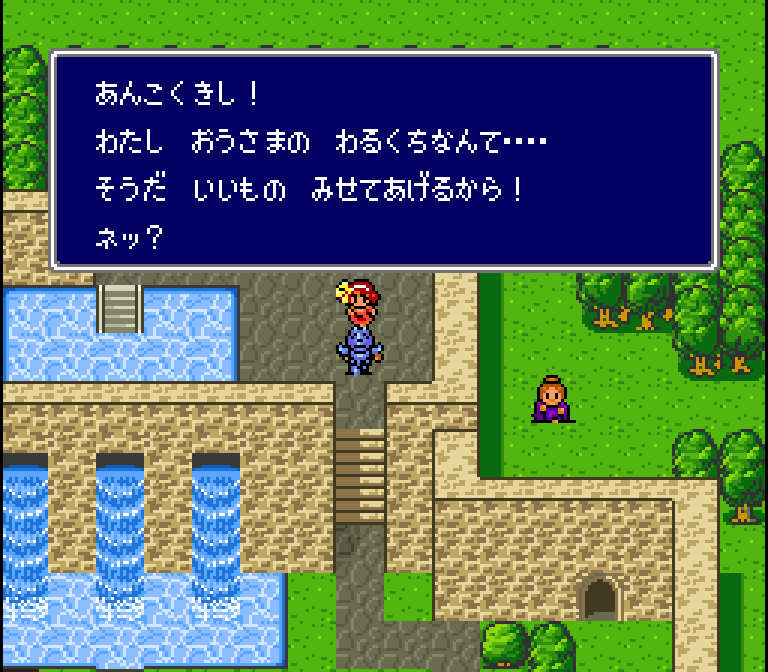 | 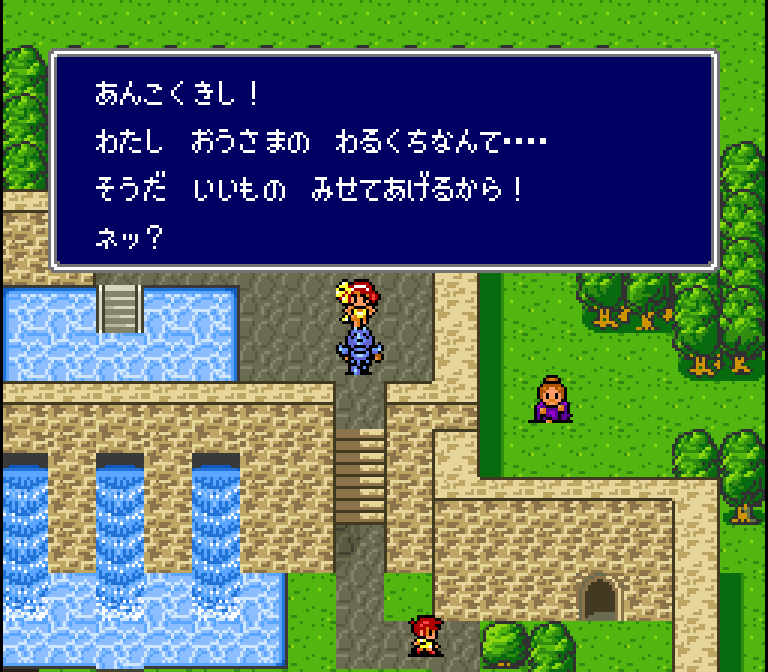 | 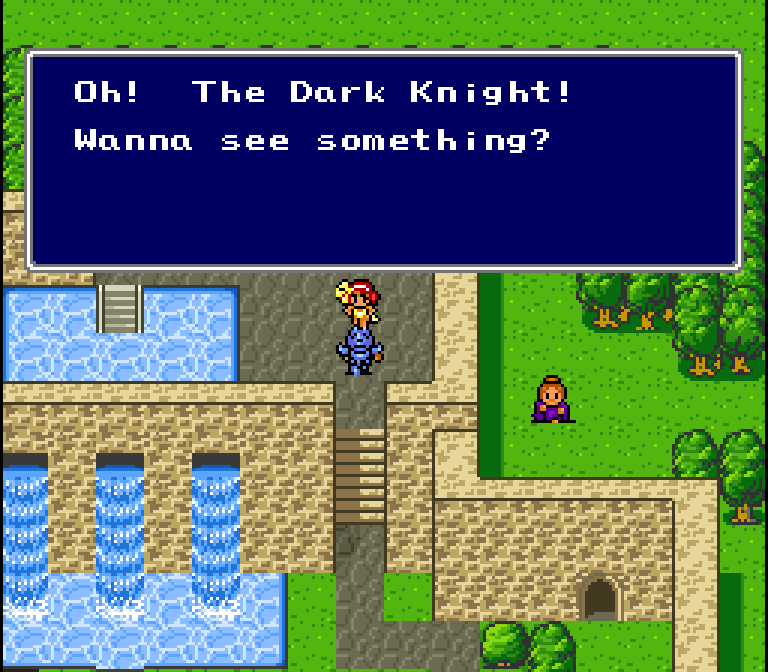 |
| Final Fantasy IV (Super Famicom) | Final Fantasy IV Easy Type (Super Famicom) | Final Fantasy II (Super NES) |
A well known difference between Final Fantasy IV and Final Fantasy II is the dancer girl in Baron. If you talk to her, she’ll do a little dance for you.
In Final Fantasy IV, she’ll throw her dress off before she dances. When she’s done, she retrieves it and puts it back on.
In both Final Fantasy IV Easy Type and Final Fantasy II, she has a slightly different sprite and doesn’t throw any clothes off. Her sprite stays the same throughout the dance. At the end of the dance she still does her little “retrieving clothes” animation even though there’s nothing there, so it’s a little odd.
For reference, I put together a video of all three versions:
Also, this girl says something different between both language versions of the game:
| Japanese Version (basic translation) | English Translation |
| Dark Knight! I would never badmouth the king… Oh, I know! Let me show you something nice! Okay? | Oh! The Dark Knight! Wanna see something? |
In essence, the Japanese version makes it sound like she was badmouthing the king and is doing the dance to distract and/or placate Cecil. Getting naked is certainly a way to do that…
The English localization not only lacks the nakedness, but it also lacks the reason she’s dancing.
Incidentally, this was brought up in this interview with Ted Woolsey after Final Fantasy II’s release. Ted Woolsey was the translator for the Super NES Final Fantasy III, Secret of Mana, Super Mario RPG, Chrono Trigger, and possibly more. As far as I know Ted didn’t work on Final Fantasy II’s translation (or at least didn’t do any of the main work) but he had this to say about the dancer in Baron:
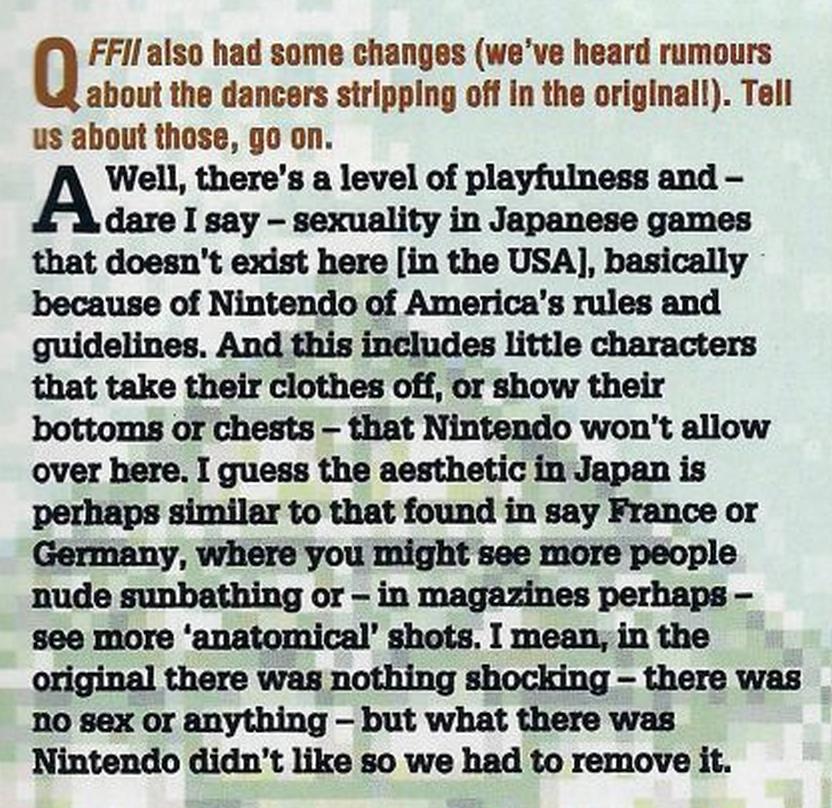
I don’t remember how this dancer was handled in the later ports, remakes, etc. that were localized into English.
Treasure Changes
As we’ve seen before, the contents of many treasure chests throughout the game have been altered. Here’s a list of the various treasure chests/pots/etc. in Baron at this point in the game that have been changed:
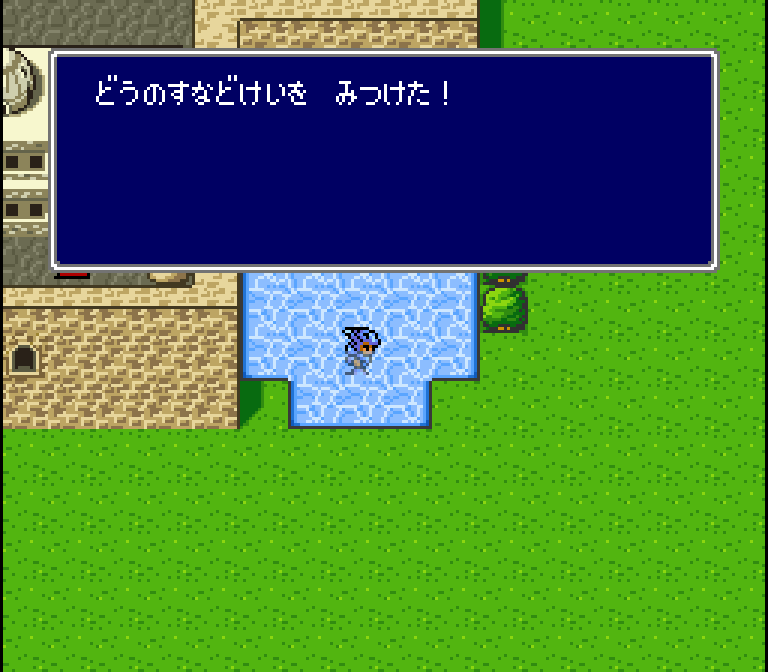 |  |  |
| Final Fantasy IV (Super Famicom) | Final Fantasy IV Easy Type (Super Famicom) | Final Fantasy II (Super NES) |
| Location: | Final Fantasy IV (basic translation) | Final Fantasy IV Easy Type (basic translation) | Final Fantasy II (Super NES) |
| Inn | Dwarf Bread | Tent | Tent |
| Inn | Tent | Heal-All Medicine | Heal |
| Inn | Eyedrops | Potion | Cure1 |
| Rosa’s House | Maiden’s Kiss | Tent | Tent |
| Water | Bronze Hourglass | Tent | Tent |
| Grass | Gold Needle | Heal-All Medicine | Heal |
| Grass | Gold Needle | Heal-All Medicine | Heal |
I like how there’s a Maiden’s Kiss in Rosa’s home.
Old Waterway Woman
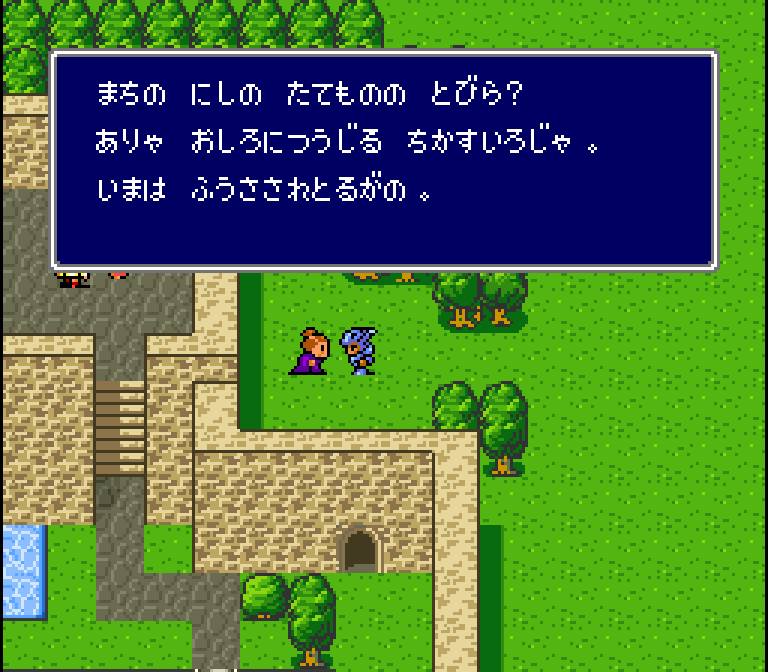 | 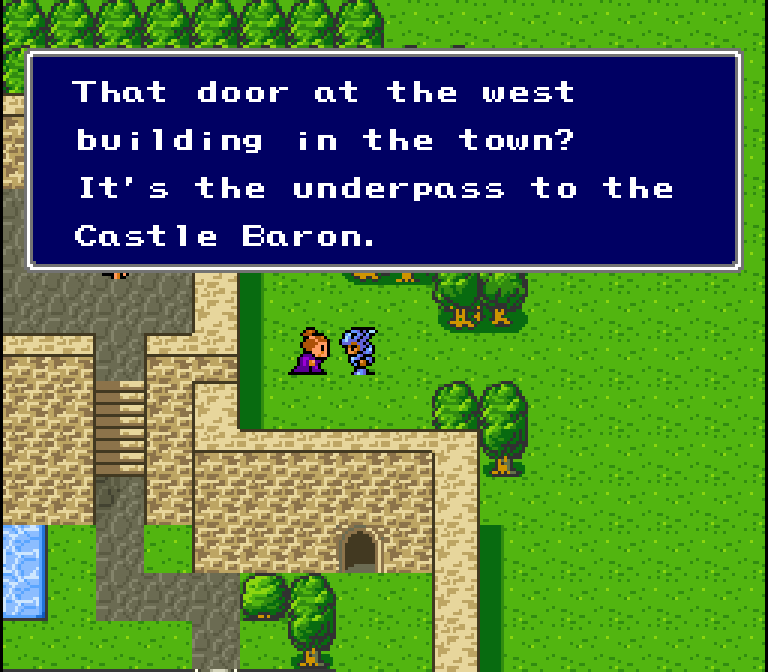 |
| Final Fantasy IV (Super Famicom) | Final Fantasy II (Super NES) |
This old lady says in English, “That door at the west building in the town? It’s the underpass to the Castle Baron.”
In Japanese, she says, “The door on the west building in town? That’s an underground waterway that leads to the castle. It’s sealed now, though.”
She also speaks in a decidedly “old person” way in Japanese.
Fireplace Check
 |  |  |
| Final Fantasy IV (Super Famicom) | Final Fantasy IV Easy Type (Super Famicom) | Final Fantasy II (Super NES) |
I remember being greatly amused when I realized you could talk to the fires in fireplaces in Final Fantasy II. If you do, it’ll just say, “OUCH!”
I was always curious to know what the Japanese version said, and it’s basically the same deal. The Japanese phrase used is the “Ouch!” you use when you touch something hot.
Rosa’s Mother
Rosa’s mom says some ever-so-slightly different stuff in Japanese and English:
 | 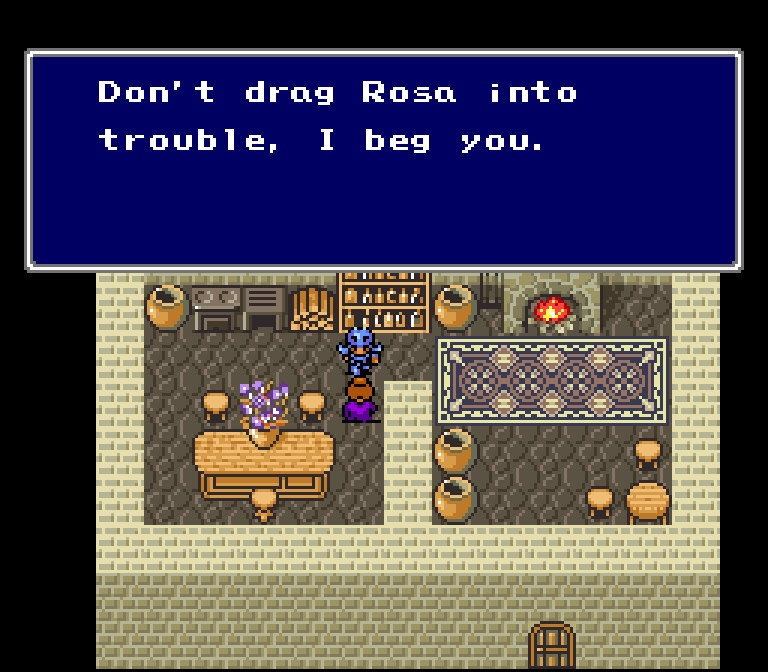 |
| Final Fantasy IV (Super Famicom) | Final Fantasy II (Super NES) |
| Japanese Version (basic translation) | English Translation |
| Rosa’s mother: The king’s way of doing things lately has been just terrible… | Rosa’s mother: The King’s become dreadful. |
| And they say you guys are doing terrible things elsewhere, too. | I heard you did an awful thing in Mysidia. |
| I beg you, don’t get Rosa caught up in any trouble. | Don’t drag Rosa into trouble, I beg you. |
It’s not much, but here we see that she mentions Mysidia specifically in the translation while she doesn’t use anything that specific in the original text.
I also like how the last sentence was phrased in the English localization, it sounds almost like natural English.
Serpent Road / Devil Road
 |  | 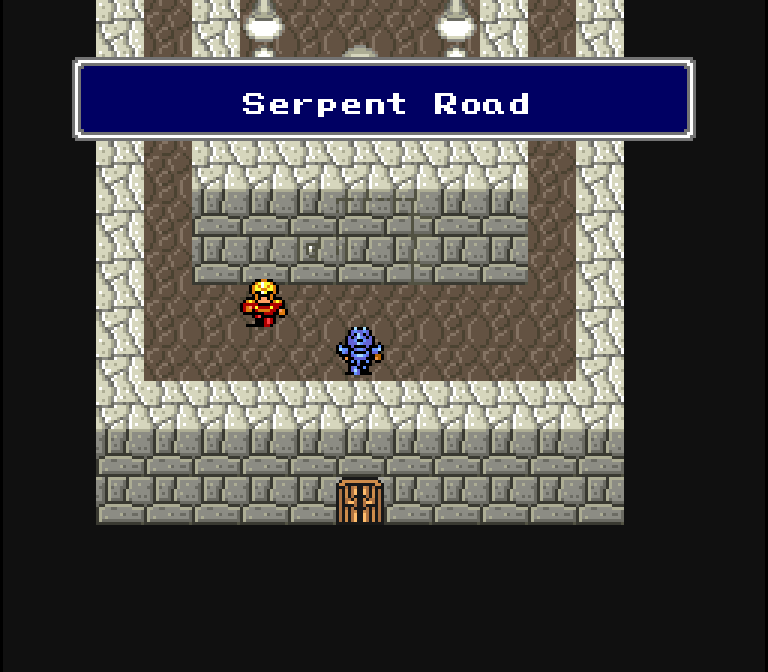 |
| Final Fantasy IV (Super Famicom) | Final Fantasy IV Easy Type (Super Famicom) | Final Fantasy II (Super NES) |
In Final Fantasy II, the special warp area between Baron and Mysidia is called the “Serpent Road”. I always assumed this was because it was long and winding.
It turns out it’s actually called the “Devil Road” in Japanese.
I think it’s supposed to dangerous and very tiring or grueling for whoever uses it. In that sense, the Japanese name makes a tiny bit more sense. But I personally prefer Serpent Road due to my own personal interpretation… and because there’s a Serpent Trench in the sequel that’s very similar.
The soldier in front of the warp point says something different in Japanese and English:
 | 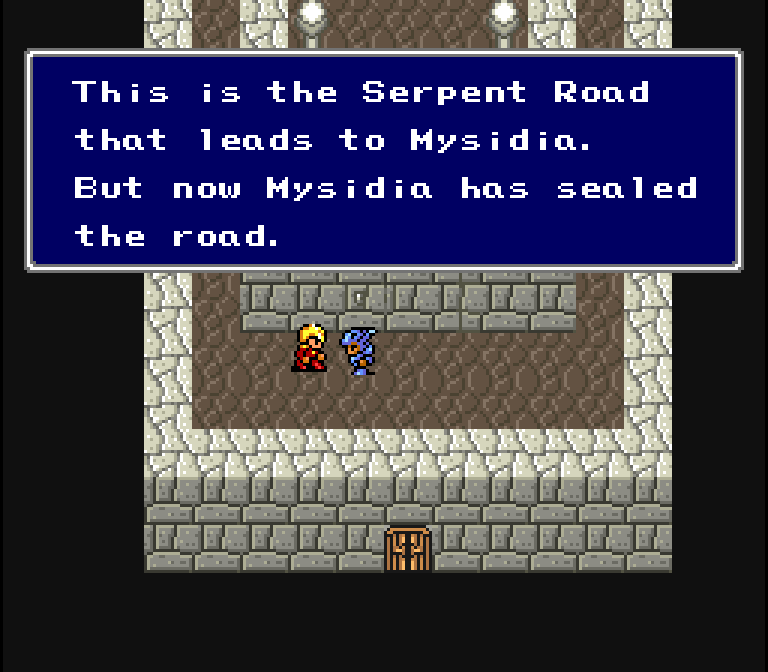 |
| Final Fantasy IV (Super Famicom) | Final Fantasy II (Super NES) |
| Japanese Version (basic translation) | English Translation |
| This is the Devil Road, which leads to Mysidia. | This is the Serpent Road that leads to Mysidia. |
| This was once used heavily for trade and such, but it’s apparently been sealed on the Mysidia side and can’t be used now. | But now Mysidia has sealed the road. |
The background information about how it was once an important connection between the two cities, especially with trade and commerce, helps solidify the fact that relations between Baron and Mysidia are really bad now.
This is left out of the English translation altogether. The fact that Mysidia sealed the path still makes it somewhat clear that the situation has deteriorated – if the reader is paying attention, anyway.
In Final Fantasy IV, the same soldier then explains that there’s a training room downstairs. This line is taken out of Final Fantasy IV Easy Type and Final Fantasy II because the training room was moved to its own building, as seen earlier:
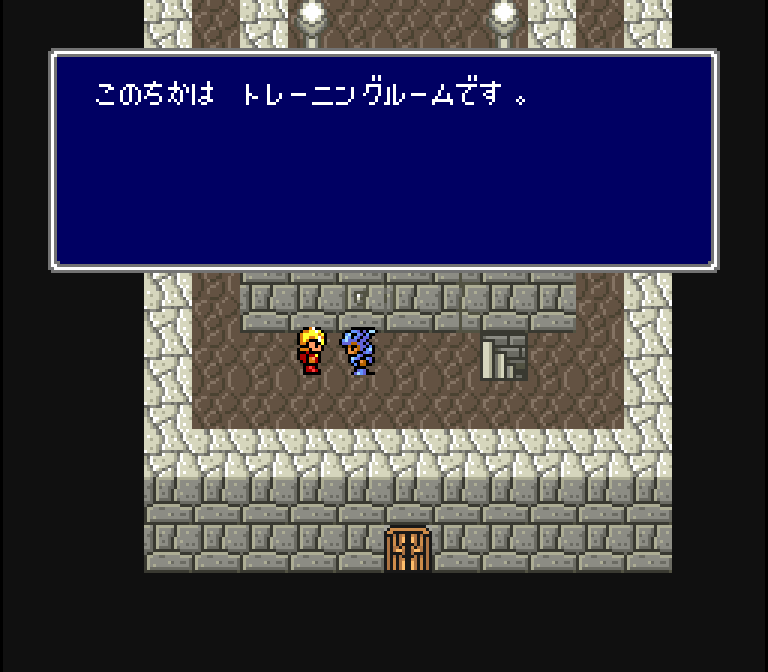
Training Room Introduction
Not only was a training room added to the town of Baron in Final Fantasy IV Easy Type and Final Fantasy II, a soldier was put in front of it to tell you all about it:
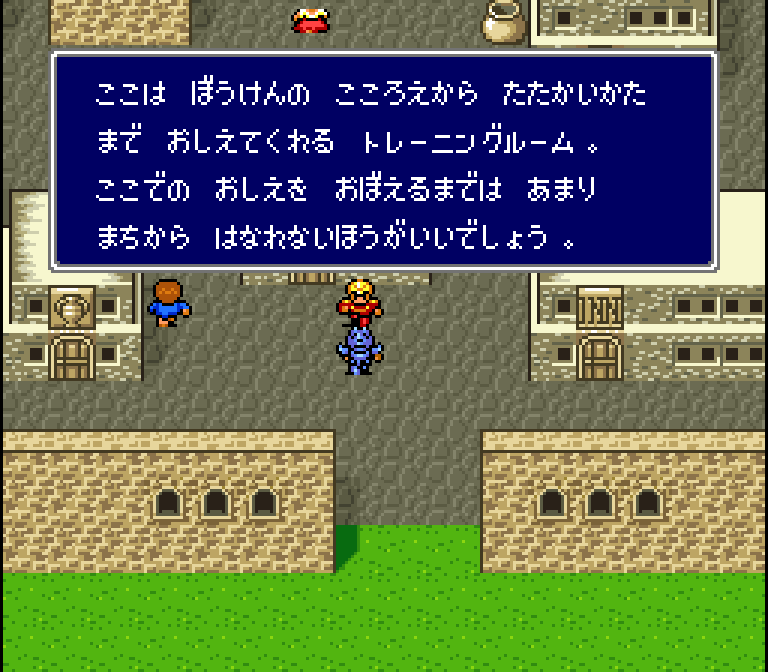 | 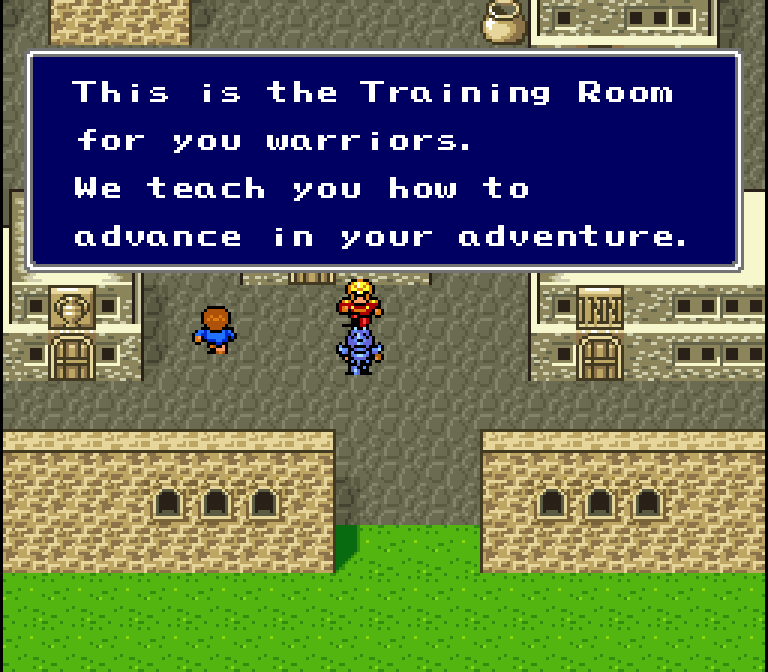 |
| Final Fantasy IV (Super Famicom) | Final Fantasy II (Super NES) |
| Japanese Version (basic translation) | English Translation |
| This is a training room that will teach you everything from adventure knowledge to how to fight. | This is the Training Room for you warriors. We teach you how to advance in your adventure. |
| I would recommend not straying far from town until you’ve learned the things taught here. | You’d better listen to the instructions, or you may not go far. |
The lines in each game are a tiny bit different. The final sentence, “or you may not go far” seems like a possible mistranslation of “I suggest you not go far”. In the end, the basic meaning is conveyed though, so it doesn’t matter much. The Japanese line doesn’t have that intimidating, “You’d better listen or else” feel to it, at least.
Training Room
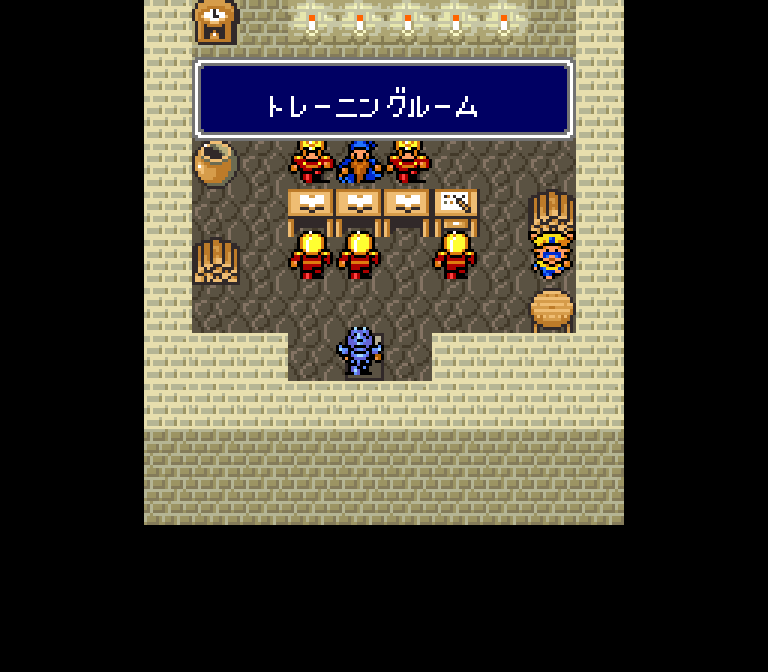 |  | 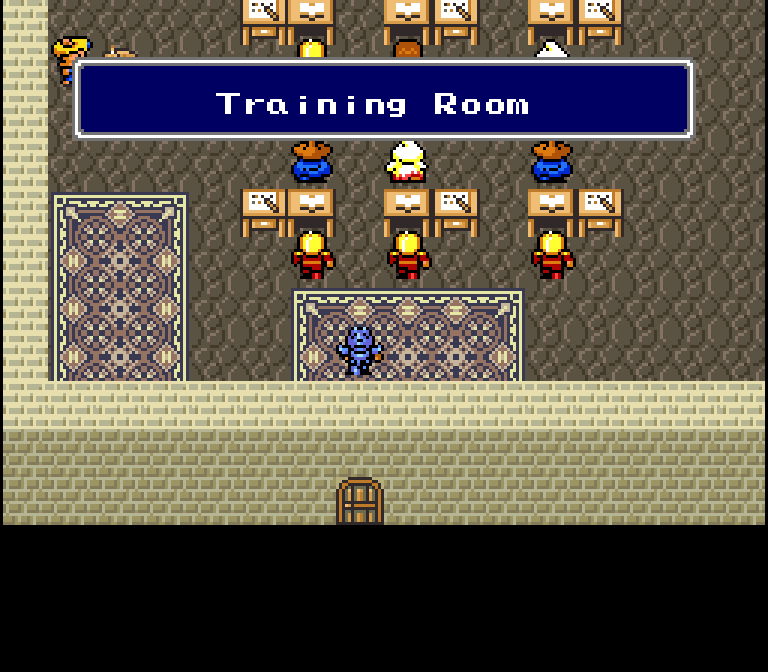 |
| Final Fantasy IV (Super Famicom) | Final Fantasy IV Easy Type (Super Famicom) | Final Fantasy II (Super NES) |
I remember being annoyed by all the talkiness of the training rooms when I first played Final Fantasy II back in the day. It’s not much better in the other two games, so prepare yourself – we’re in the training room for a while…
Anyway, taking a look inside the training rooms of each game, we see that Final Fantasy IV’s training room is a small, 1-story affair (in fact, it’s underground) while in Final Fantasy IV Easy Type and Final Fantasy II it’s much larger and spans two above-ground floors:
Naturally, the Easy Type and Final Fantasy II training rooms also have more people to talk to. Many of them give new hints that weren’t in the original game. In other cases, long hints that were given in Final Fantasy IV are broken into smaller hints and spread across multiple people.
Here’s a quick overview of what’s taught in the two types of training rooms:
| Final Fantasy IV | Final Fantasy IV Easy Type & Final Fantasy II |
| Fat Chocobos How to escape battles Using magic on multiple targets Namingway Save points Battle modes Party formations In-battle controls | Fat Chocobos How to escape battles Using magic on multiple targets Namingway Save points Battle modes Party formations In-battle controls What a save actually is Explanation of map directions What Chocobos are How to use Chocobos Changing the lead party member Battle config options Monster weaknesses Left/right-handedness Bows and arrows |
The bigger training rooms are definitely very helpful for beginners, but I can’t help but wonder if it’s a lot of info all at once. Maybe that’s why they added copies of this training room in other early towns, though. Smart!
Saving the Game
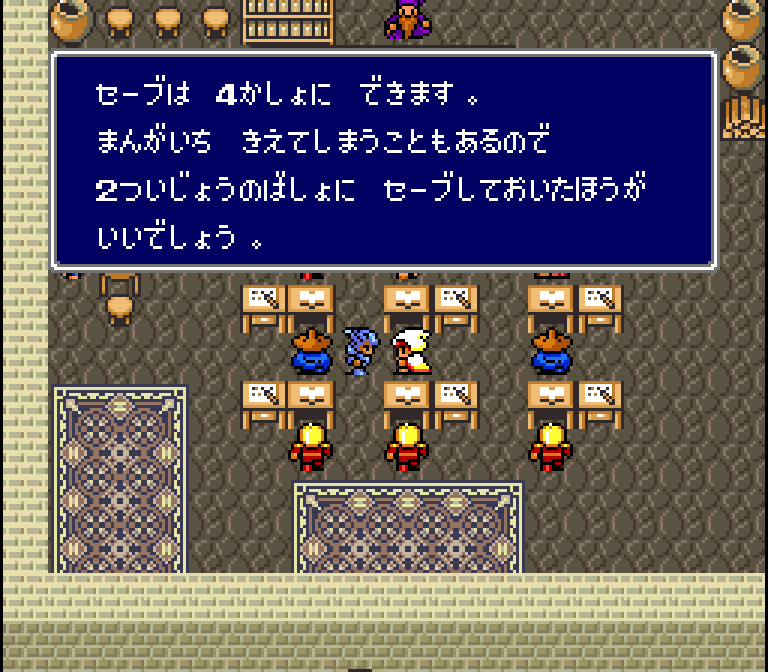 | 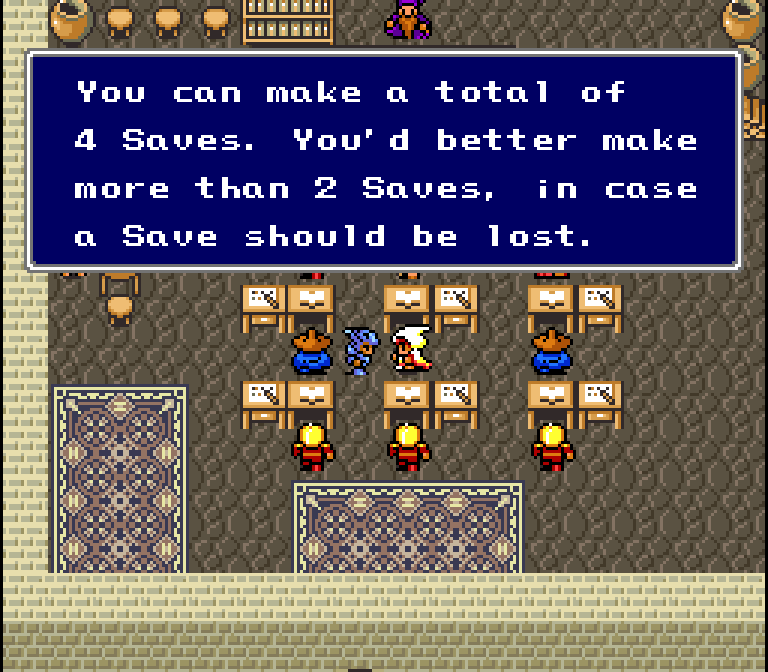 |
| Final Fantasy IV (Super Famicom) | Final Fantasy II (Super NES) |
One of the hints in the expanded training room is about how you can save four files. It also suggests you copy your main save to two separate slots in case one gets erased.
There’s not much to say about this in terms of localization, but I wonder if this was added in due to complaints from Final Fantasy IV players. I say that because this actually happened to me with Final Fantasy II – one year I spent all of Christmas break leveling everyone up to Level 99. That’s a lot of work! But then one day shortly after the file was suddenly gone.
So I sent Square a letter about it and they replied back with something like, “Oh that happens sometimes, you should be sure not to drop the game or damage it, and be sure to back up your saves on other slots.”
So, yeah. I wonder if this was common enough in Japan that they added this hint. If this happened to you with Final Fantasy II or Final Fantasy IV, let me know! I’m curious to know how widespread this was back in the day. I’m sure it’s more common now that all the old batteries are starting to die.
Meeting Namingway
In Final Fantasy IV, this soldier tells you about Namingway. Here’s a look at what he says in all three versions of the game:
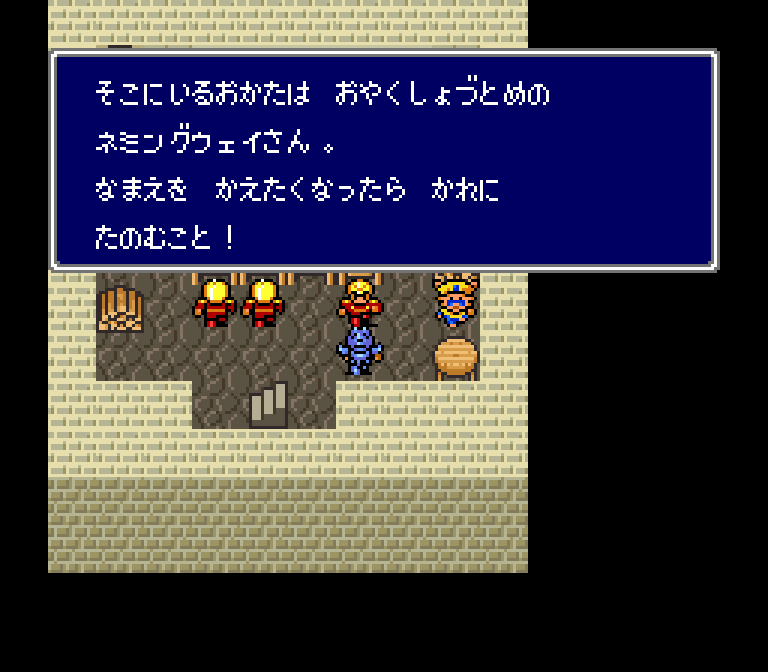 |  | 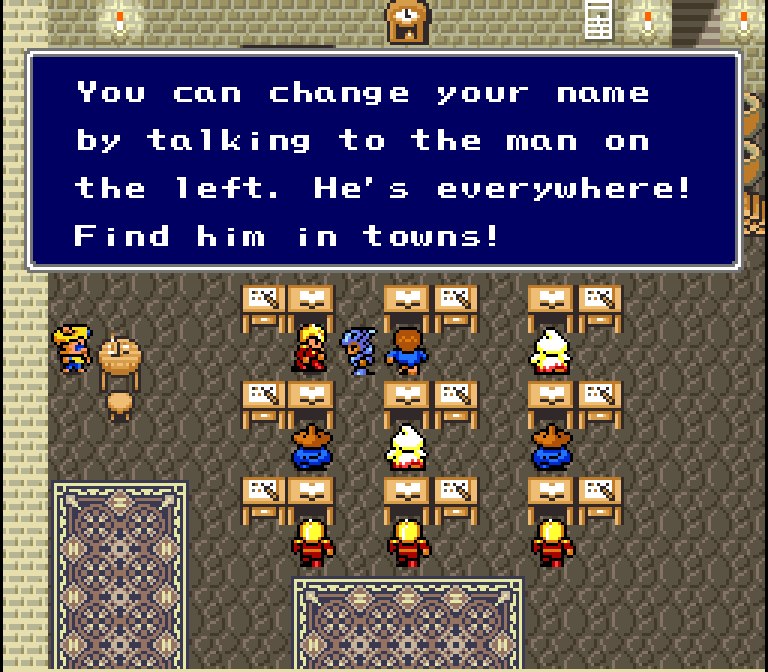 |
| Final Fantasy IV (Super Famicom) | Final Fantasy IV Easy Type (Super Famicom) | Final Fantasy II (Super NES) |
| Final Fantasy IV (basic translation) | Final Fantasy IV Easy Type (basic translation) | Final Fantasy II (Super NES) |
| That gentleman there is Mr. Namingway, an office worker. | That gentleman on the left is Mr. Namingway, an office worker. | You can change your name by talking to the man on the left. |
| If you ever want to change your name, ask him! | If you ever want to change your name, ask him and you can change it at any time. | He’s everywhere! Find him in towns! |
A few points of interest here:
- “Office worker” could also be translated to something like “government official” or something like that, just a guy who works at/for a government-type office.
- The original text just says “that gentleman there”, while the guy in the expanded training room says, “the gentleman on the left”. This is because the room is suddenly much bigger and filled with more people, so “that person there” would be less clear.
- The English version cuts out a lot but adds in stuff about how he’s everywhere, particularly in towns.
- There’s a slight difference in the two Japanese lines – Final Fantasy IV Easy Type adds in the part about “at any time”.
Party Leader Change
Here’s a look at what this helpful guy says in both versions of the expanded training room:
 | 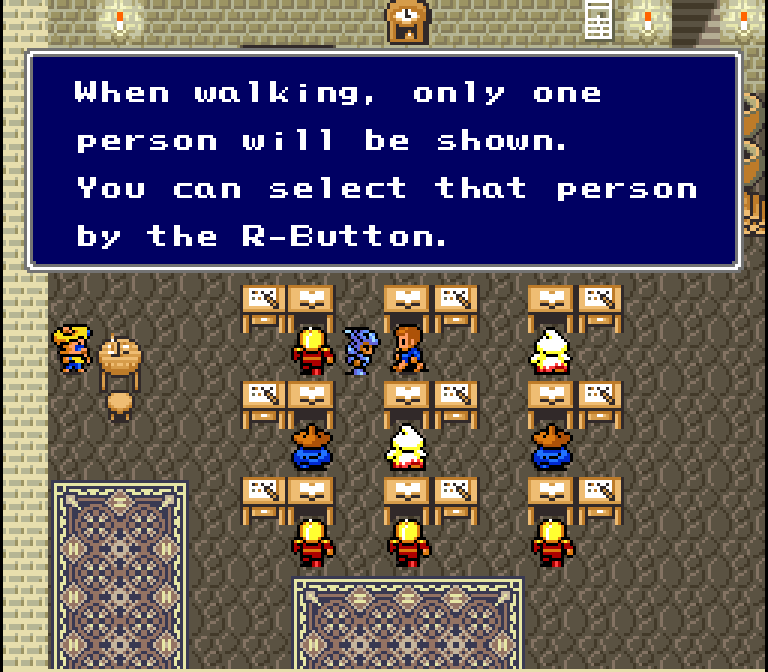 |
| Final Fantasy IV (Super Famicom) | Final Fantasy II (Super NES) |
| Japanese Version (basic translation) | English Translation |
| While you’re walking, even if you have other party members only one person will be displayed. | When walking, only one person will be shown. |
| As you journey, you should use the R Button to select a character you like. | You can select that person by the R-Button. |
A pretty simple piece of text. There are a few things of note:
- I really like how the first sentence was translated – I’m always a fan of seeing well-condensed translations.
- The second translated sentence falls apart a bit, especially because of the improper use of “by”. This is due to the fact that Japanese uses particles to denote how things in sentences connect. We don’t have quite the same system in English, so you’ll often see non-native translators mess up English prepositions like “with”, “by”, “at”, “in”, “on” and such. This is one such case.
Even the best non-native translators have trouble with little intricacies like this, which is why it’s usually better to have a native speaker of the target language translate or at least edit the translated text. - Most game console manufacturers have a set of guidelines that software developers need to follow. This is partly to prevent crappy-quality and buggy stuff from cheapening the console’s image, among other things. Nintendo has something called “lot check”, and a big part of passing it involves making sure you spell button names a very specific way.
That’s why you see “R-Button” spelled and capitalized this specific way. Had it been spelled any other way, Square would have to fix it and resubmit the game for evaluation, which is an expensive and lengthy process.
Lot check guidelines seemed to have changed over time, but when I worked on professional games localizations I had to write button names basically like this too.
Chocobo Hint Man
There’s a guy who gives a hint about the big Chocobos in all three training rooms:
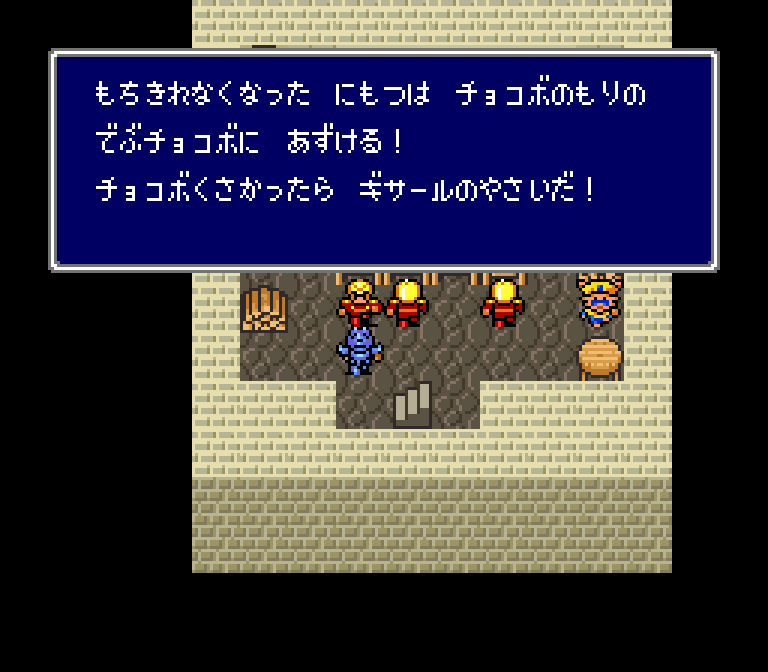 | 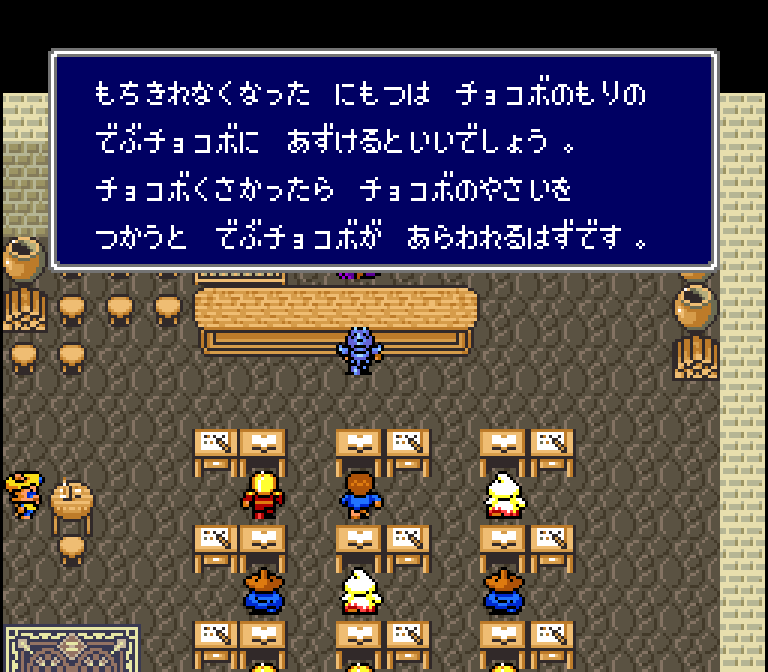 | 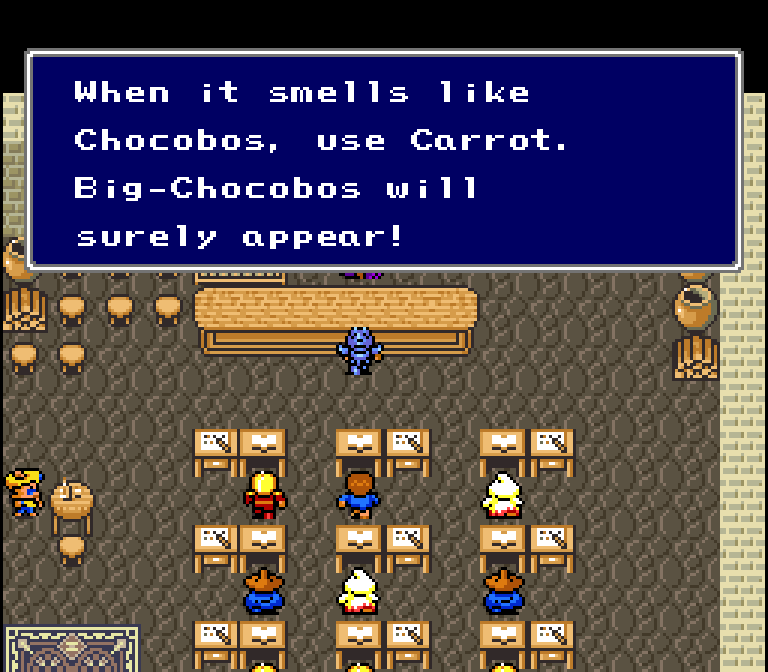 |
| Final Fantasy IV (Super Famicom) | Final Fantasy IV Easy Type (Super Famicom) | Final Fantasy II (Super NES) |
| Final Fantasy IV (basic translation) | Final Fantasy IV Easy Type (basic translation) | Final Fantasy II (Super NES) |
| Give items you can’t hold on to anymore to the Fat Chocobos in Chocobo forests! | You should give items you can’t hold on to anymore to the Fat Chocobos in Chocobo forests. | When your items get too many to carry, go to the Big-Chocobos and leave items in their care. |
| Use a Gysahl Vegetable where it smells like a Chocobo! | If you use a Chocobo Vegetable where it smells like a Chocobo, a Fat Chocobo should appear. | When it smells like Chocobos, use Carrot. Big-Chocobos will surely appear! |
Some things worth pointing out:
- The translation calls them “Big-Chocobos”, although the Japanese term used is more like “fat”.
- In Final Fantasy IV, you have to give them Gysahl Vegetables to make them appear. In Final Fantasy IV Easy Type this item is called a “Chocobo Vegetable” and in Final Fantasy II it’s simply called a “Carrot”.
- ”Gysahl” comes from the name of a town in Japanese Final Fantasy III for the Famicom.
- The guy in Easy Type speaks more politely than the guy in Final Fantasy IV. For more information on Japanese politeness levels, see my writeup on the subject in my Zelda 1 comparison.
Changing Your Name
You can change the name of any character in your party by talking to Namingway.
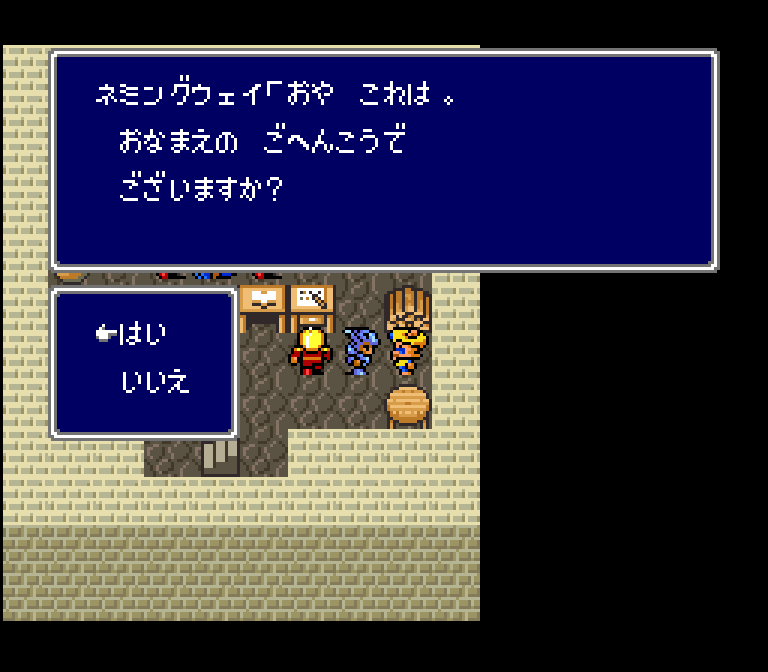 | 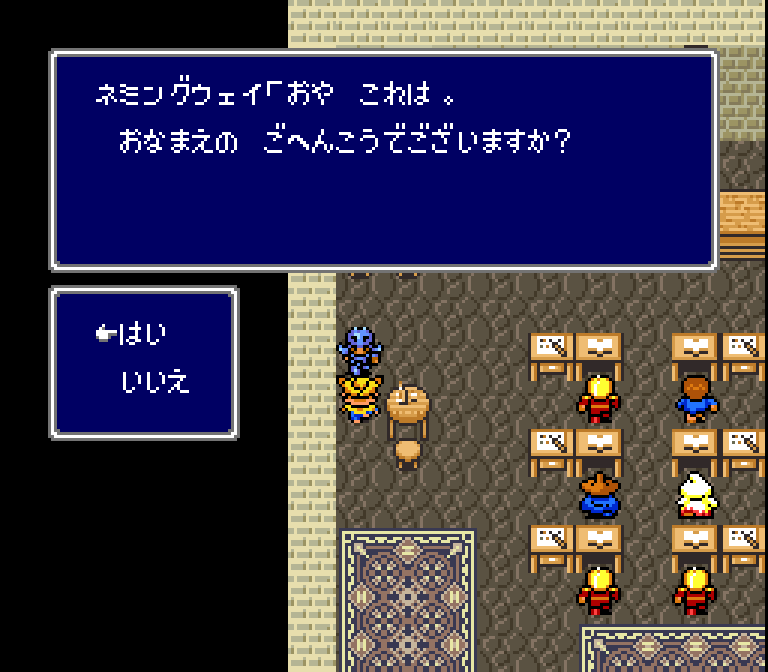 | 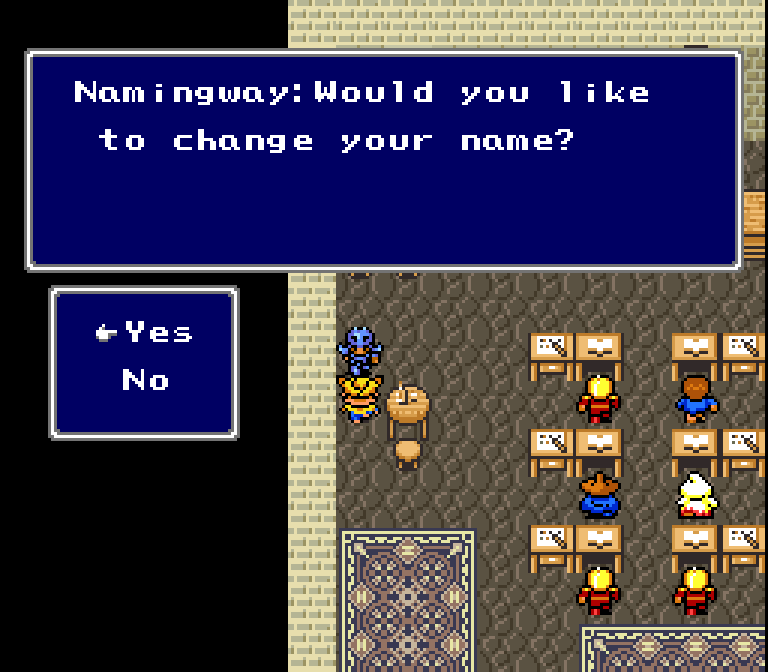 |
| Final Fantasy IV (Super Famicom) | Final Fantasy IV Easy Type (Super Famicom) | Final Fantasy II (Super NES) |
In English, when you first talk to him he says, “Would you like to change your name?”
In Japanese, he says essentially the same thing, but starts with something like, “Oh, hello there.”
Namingway also speaks in a very formal and polite form of Japanese that very few other characters in the game use. It doesn’t really come across at all in Final Fantasy II’s translation, though:
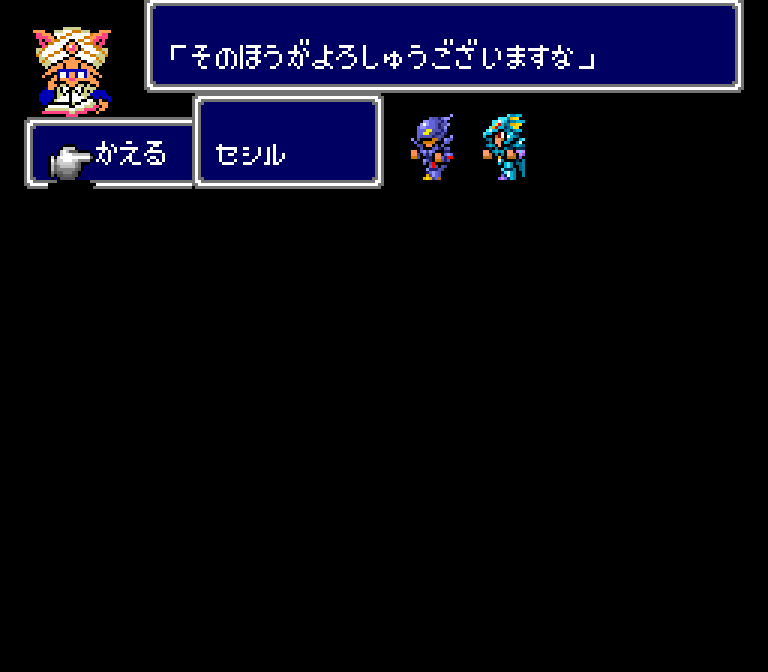 | 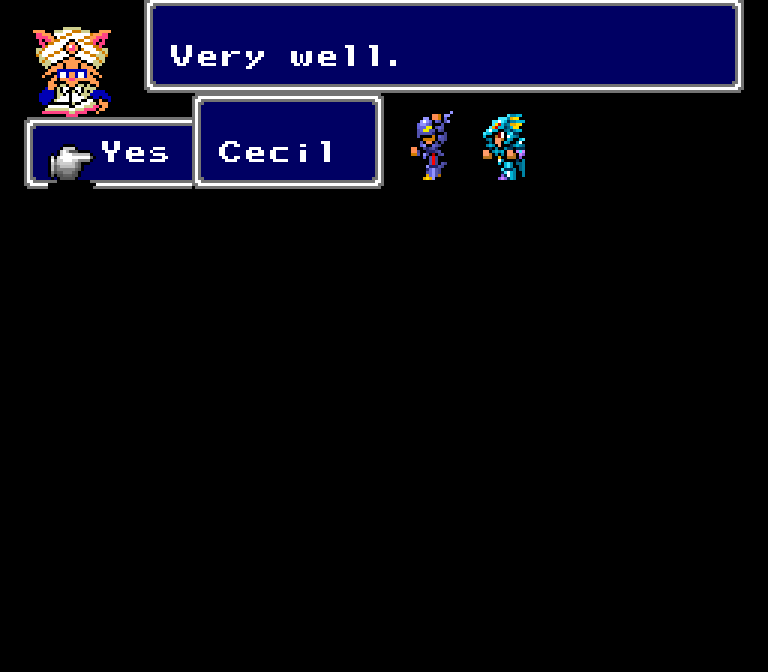 |
| Final Fantasy IV (Super Famicom) | Final Fantasy II (Super NES) |
Also, in the English version, he says, “Who’s name?” when you’re selecting someone to rename. This should’ve been “Whose name?” This actually seems to be a common mistake made by native Japanese speakers who’ve learned English as a second language. Which isn’t surprising, as it’s a common mistake among native English speakers too.
Naming Screens
 |  | 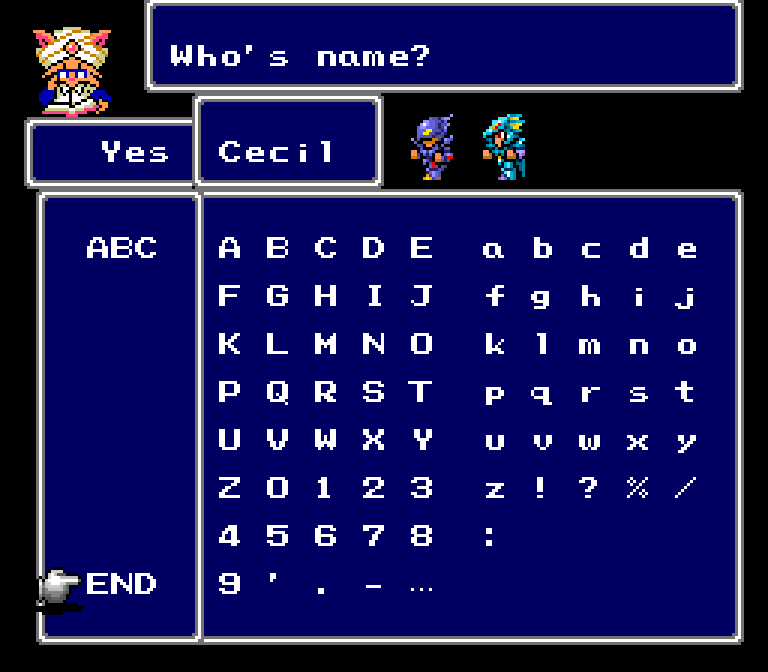 |
| Final Fantasy IV (Super Famicom) | Final Fantasy IV Easy Type (Super Famicom) | Final Fantasy II (Super NES) |
As you might expect, the actual text input screen where you enter your name is different in Japanese and English.
But first, it should be noted that modern Japanese uses basically four writing systems side-by-side:
- Hiragana
- Katakana
- Kanji
- The English alphabet
In quick terms, hiragana and katakana are a bit like an alphabet – there’s only a small number of characters to learn and they’re used to spell/pronounce words. Hiragana is used for normal writing while katakana is generally used for words from other countries or for emphasis. Kanji is basically Chinese characters, but with their own added Japanese flair. There are about 2000 standard kanji characters that are taught in Japanese schools.
Early Japanese console games often didn’t include kanji since there are so many of them and memory was often limited. You can write everything using just hiragana and katakana, so most old games use only those, including both versions of Final Fantasy IV.
As such, the naming screens in Final Fantasy IV Easy Type let you create new names using three different character sets: hiragana, katakana, and English letters.
For the localization, the hiragana and katakana screens were removed, leaving only the English letter set. Some of the punctuation in the set was changed too. Here’s a look at the two games’ fonts:

For reference, here’s a look at all three character sets allowed in the Japanese naming screens:
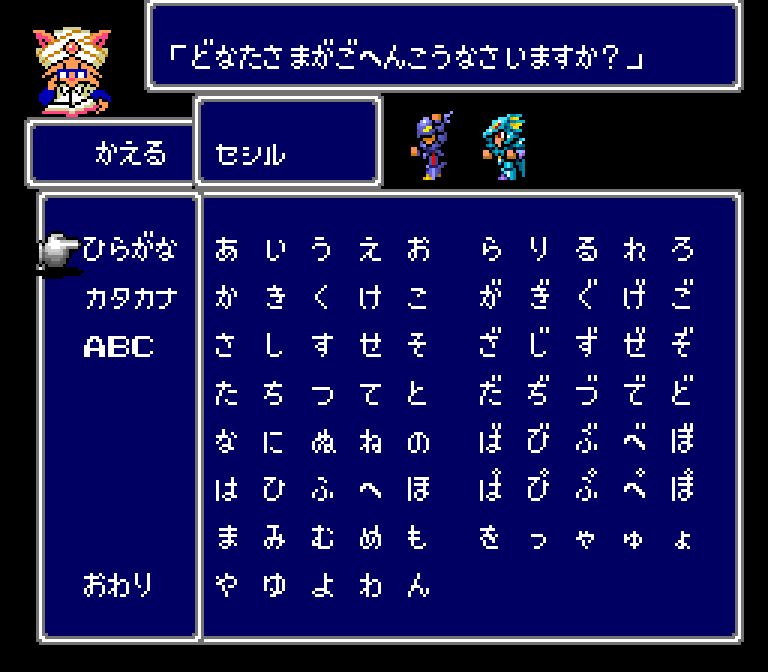 | 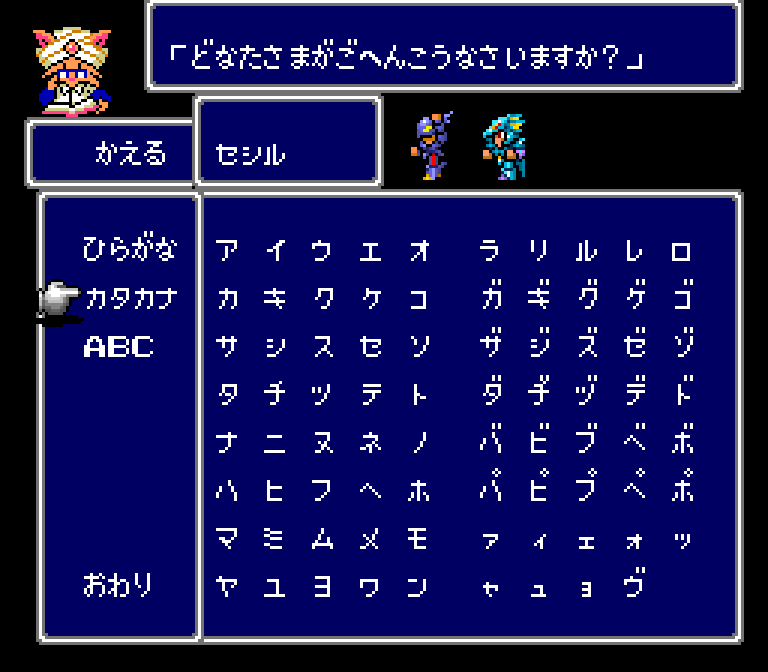 | 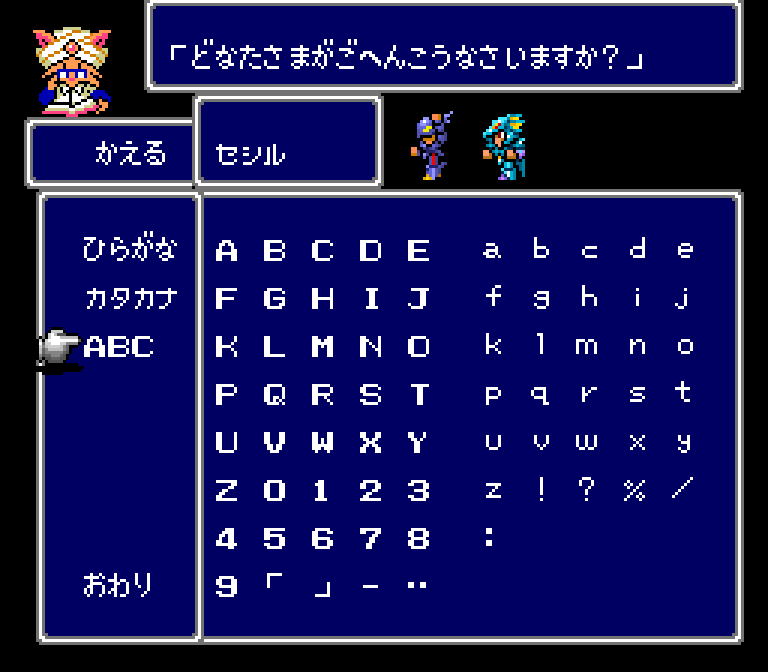 |
| Hiragana input | Katakana input | Alphabet input |
Riding Chocobos
This hint guy talks about riding Chocobos. Here’s a look at what he says in both versions:
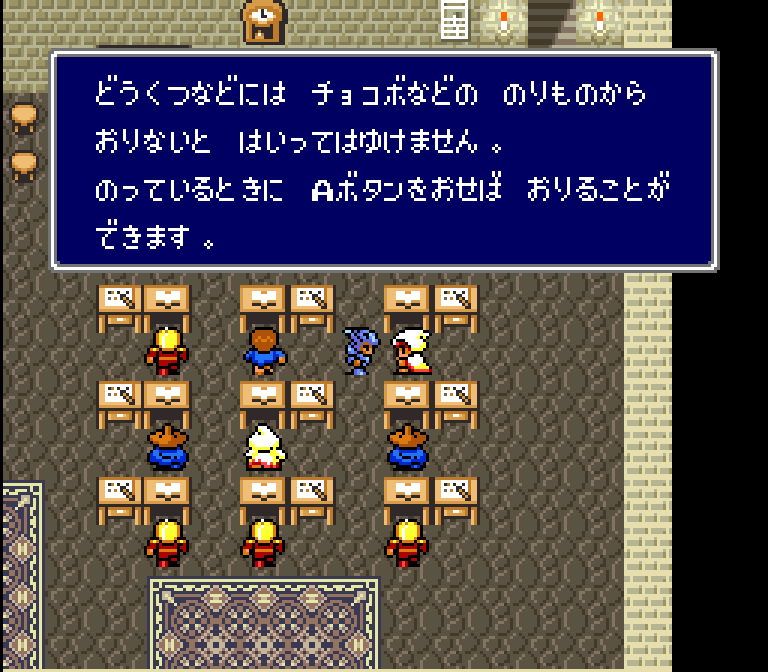 | 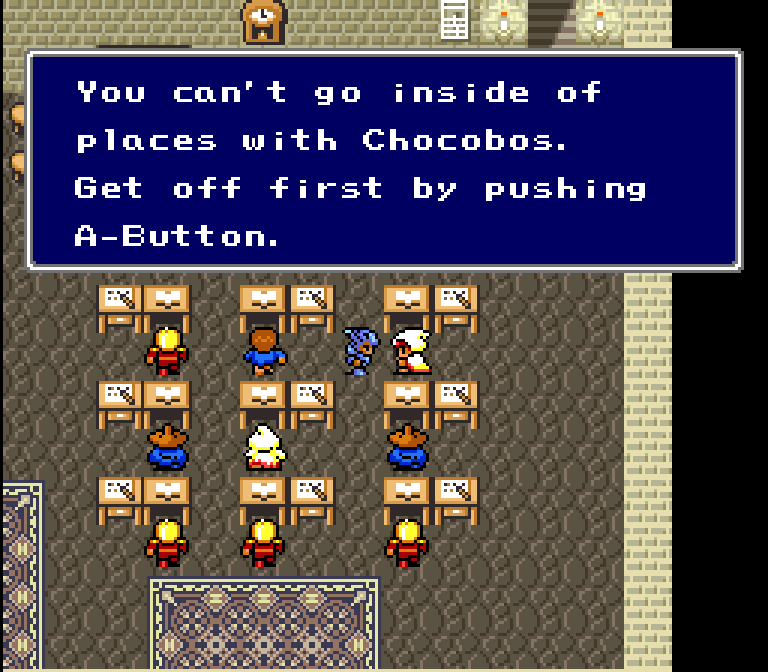 |
| Final Fantasy IV (Super Famicom) | Final Fantasy II (Super NES) |
| Japanese Version (basic translation) | English Translation |
| You can’t enter caves and the like unless you get off Chocobos and other such vehicles first. | You can’t go inside of places with Chocobos. |
| You can get off a vehicle if you press the A-Button while riding. | Get off first by pushing A-Button. |
Essentially, the original Japanese text teaches the player how to properly use vehicles in general, not just Chocobos. It also gives the player a hint that there will be other controllable vehicles at some point in the game.
Translation Overlap Mismatch
There are two other people in the extended training room that talk about catching and riding Chocobos. Here’s a look:
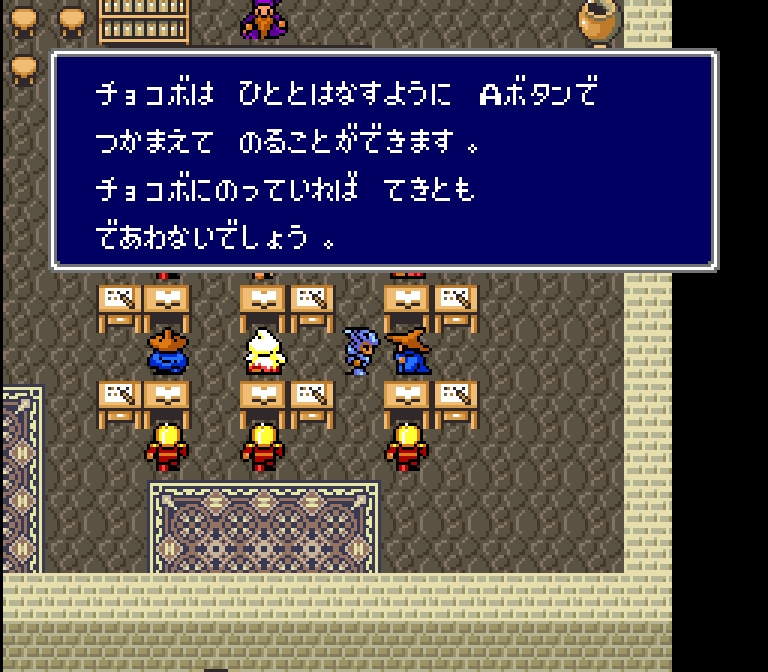 | 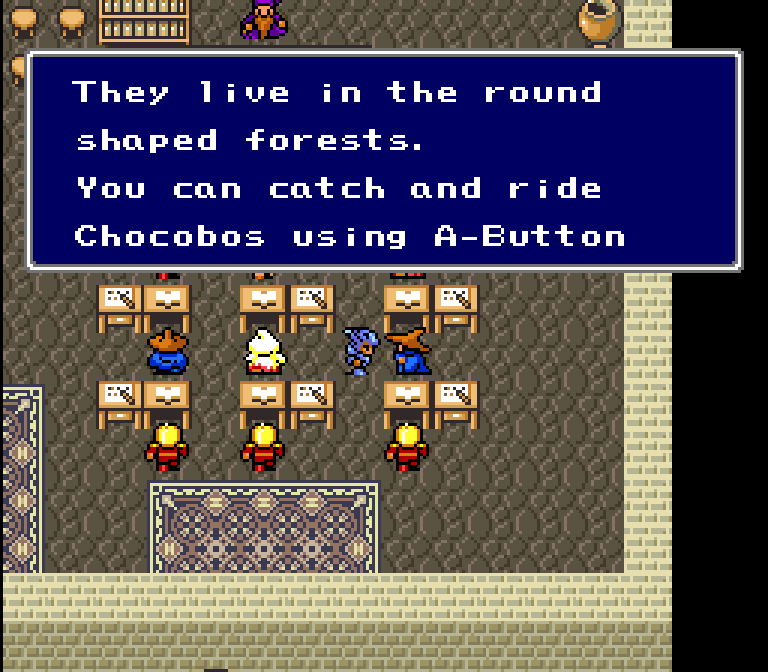 |
| Final Fantasy IV (Super Famicom) | Final Fantasy II (Super NES) |
| Soldier in Japanese Version (basic translation) | English Version |
| Are you familiar with Chocobos? | Do you know Chocobos? |
| They’re ostrich-like animals that can carry humans around like transportation. | They are ostrich-like birds which can be used as transportation. |
| Chocobos live in round-shaped forests. |
| Black Mage in Japanese Version (basic translation) | English Version |
| _ | They live in round shaped forests. |
| You can catch and ride Chocobos with the A-Button, just as if you were talking to someone. | You can catch and ride Chocobos using A-Button… just like talking! |
| While on a Chocobo, you won’t encounter enemies. | While riding Chocobos, you don’t encounter enemies. |
The localization messed up where one line ends and the other begins – specifically, the part about living in round forests:
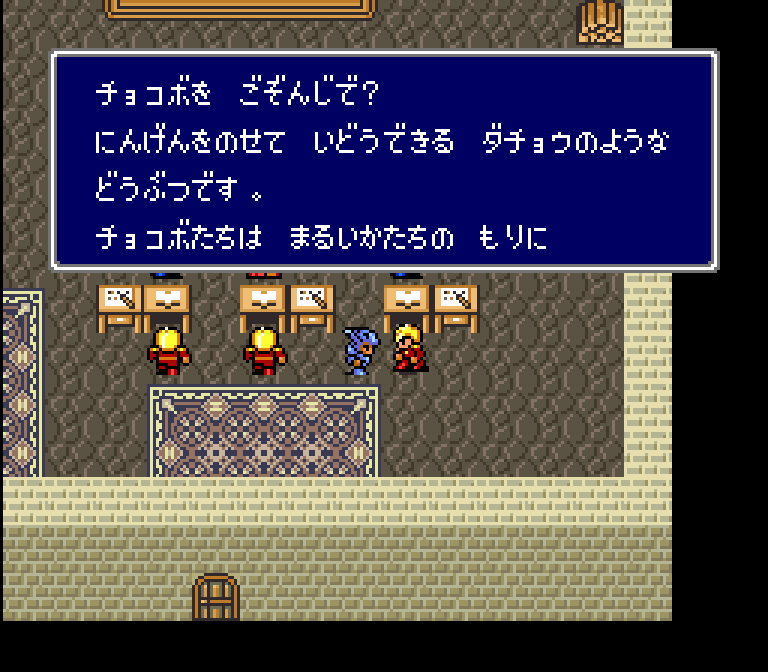 | 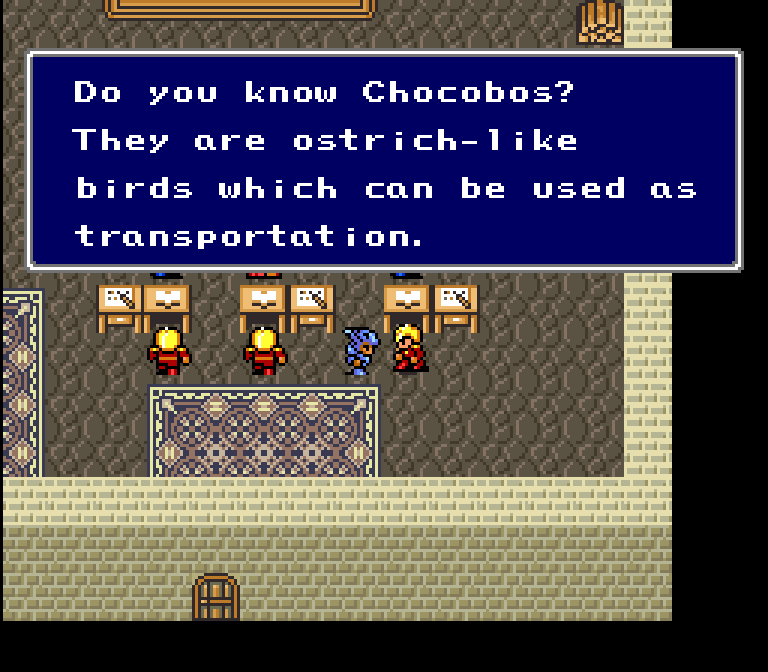 |
| Final Fantasy IV (Super Famicom) | Final Fantasy II (Super NES) |
It’s actually easy to screw up something like this and not notice it. What most likely happened is that the translator forgot to press the Enter key at the right spot, causing the end-of-line control code to get applied at the wrong part in the text data. That or the translator added the end-of-line control code to the wrong part of the text.
Either way, I could definitely see this happening while working in a big and messy text file. I’d be surprised if it didn’t almost happen to me at some point in my early translating days.
Battle Text Speed
This guy on the second floor of the training room has some slight differences in his text:
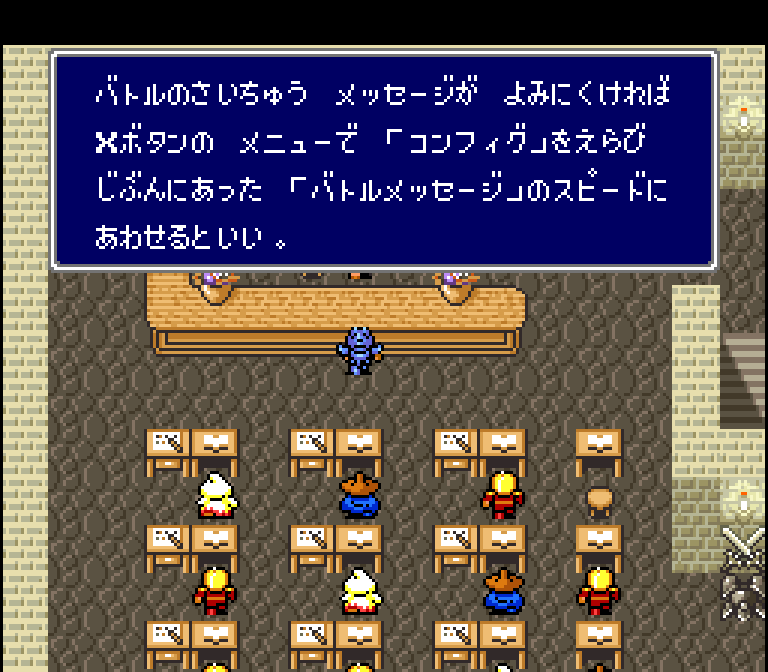 | 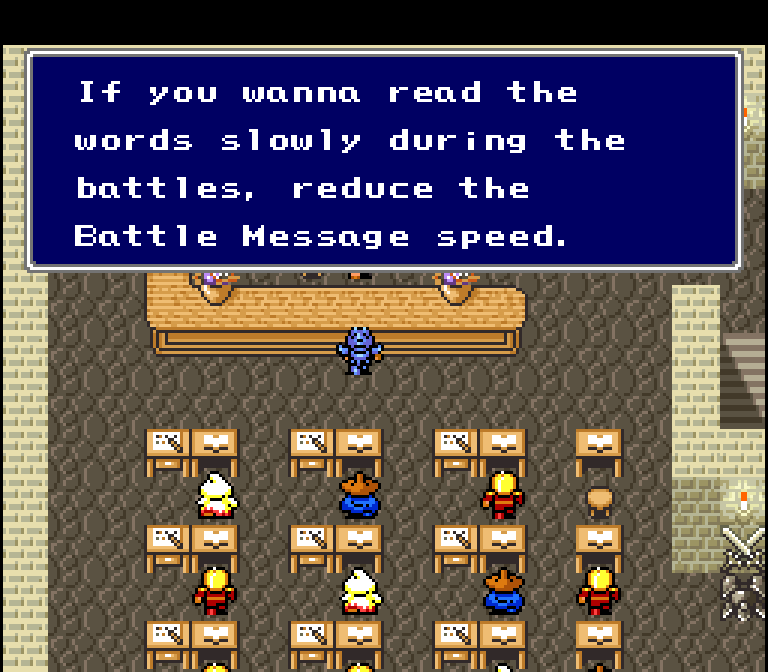 |
| Final Fantasy IV (Super Famicom) | Final Fantasy II (Super NES) |
| Japanese Version (basic translation) | English Translation |
| If messages during battle are difficult to read, select “Config” on the X-Button menu and set the “Battle Message” speed to something that suits you. | If you wanna read words slowly during the battles, reduce the Battle Message speed. |
Here, the way to set the battle text speed is clearly spelled out in the Japanese version – press the X-Button to go to the menu, go to Config, then go to Battle Message. I think they should’ve mentioned you can only access this menu outside of battle, but it’s still pretty helpful.
In contrast, the English translation just says “change the speed” but doesn’t actually say how.
Multiple Controllers
In Final Fantasy IV Easy Type, this same guy continues with another hint:
Additionally, if you set “Controller” to “Multi” you will be able to share control of your party members with Controllers 1 and 2, so two people can cooperate in battle!
What the heck? This is nowhere to be found in the English text, nor is it in the original Japanese text.
 | 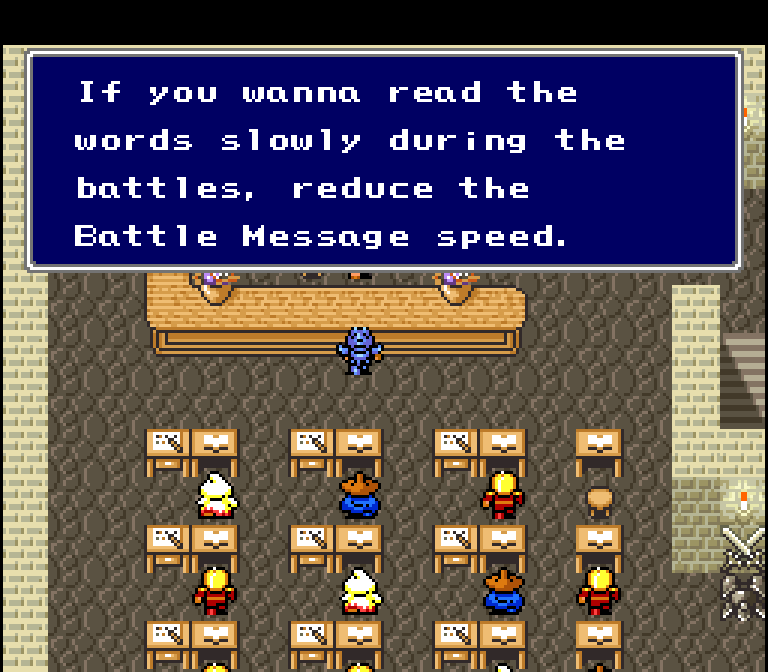 |
| Final Fantasy IV (Super Famicom) | Final Fantasy II (Super NES) |
Believe it or not, all three versions of the game can be played with both controllers. Seriously, give it a try if you didn’t already know!
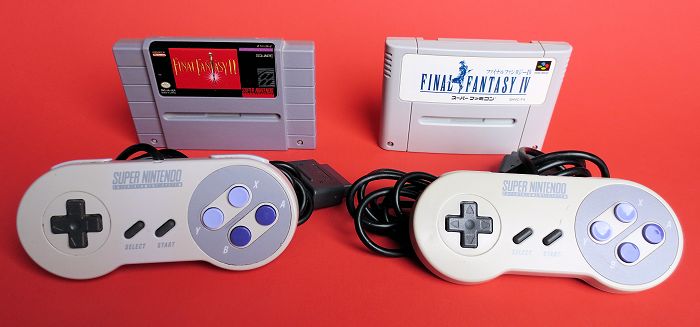
Since this isn’t mentioned in Final Fantasy IV or Final Fantasy II, we should probably take a look at the config screen:
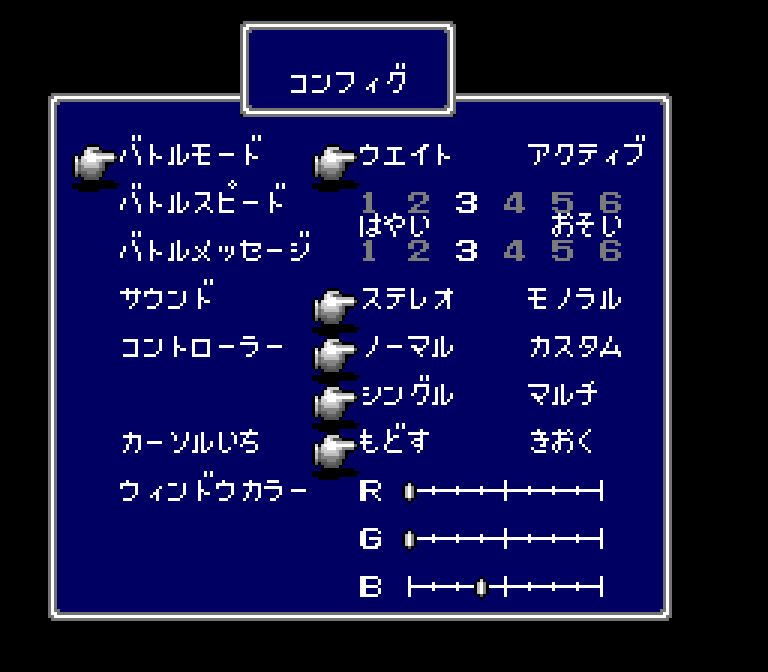 |  | 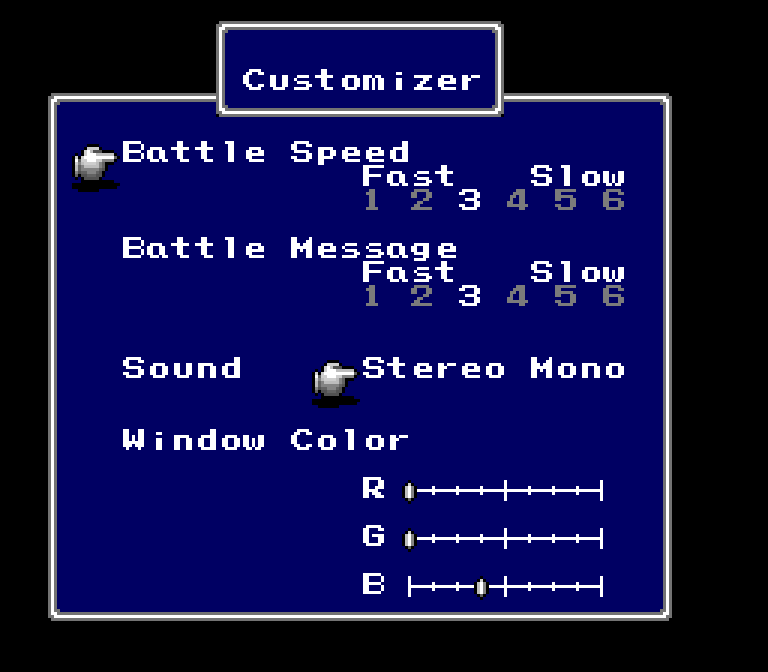 |
| Final Fantasy IV (Super Famicom) | Final Fantasy IV Easy Type (Super Famicom) | Final Fantasy II (Super NES) |
There are clearly some differences here. Here’s a quick run-down of the options:
| FFIV | FFIV Easy Type | FFII | ||||||||||||||||||||||||||||||||||||||||||||||||||||||
|
|
|
||||||||||||||||||||||||||||||||||||||||||||||||||||||
So it looks like this “Multi” controller option is available in both Final Fantasy IV and Final Fantasy IV Easy Type, it was just never mentioned in any of the in-game tutorial text in Final Fantasy IV.
But, wait, if all three versions already have multiplayer support, what exactly does this “Multi” option do?
Well, exactly as explained in the training room, you can assign different party members to different controllers. This way you can play with friends but not have to fight over control. It’s a whole new way to enjoy the game, in a way.
This “Multi” option was left out of the English localization. I’m not really sure why. Maybe to simplify things even more? I suppose I can imagine a kid messing with options and unknowingly locking certain party members out of Controller 1.
Here’s a look at the multiplayer assignment screen. It’s the same in both Japanese versions of the game:
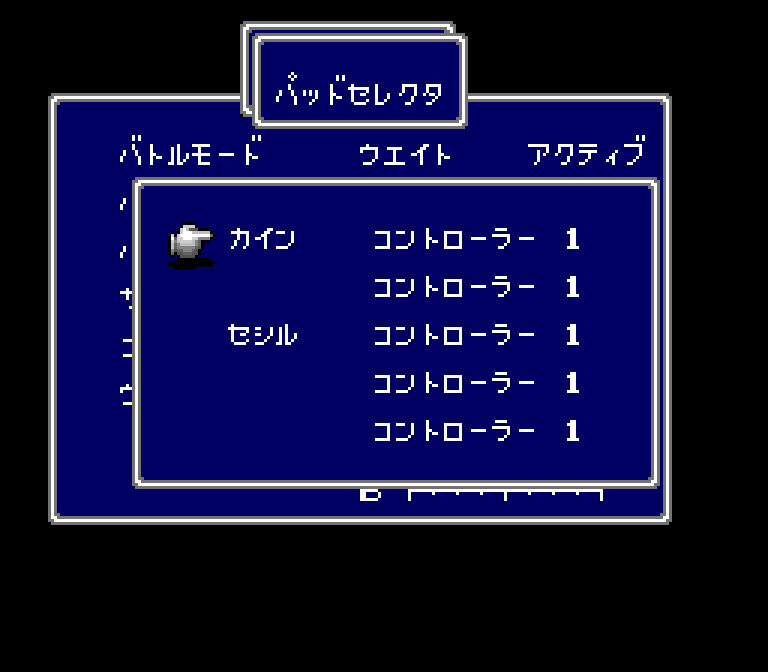
In this screenshot, it says:
| Pad Selector | |
| Cain
Cecil |
Controller 1 Controller 1 Controller 1 Controller 1 Controller 1 |
As you can guess, if you had a full party of five members, they’d all be listed on the side and you can choose which character is controlled by which controller.
Actually, this idea of multiple controller support in an RPG shouldn’t come as too much of a surprise if you’ve played other Super NES RPGs like Final Fantasy III or EarthBound – they both accept input from Controller 2 as well:
 |  |
Way back in the day, I remember wishing these games had multiplayer support. Little did I know!
Exotic Customization
I’m still curious about that “Custom” choice for Final Fantasy IV’s controller options. Let’s take a look:

Here’s what it says:
| Accept | A | B | X | Y | SELECT |
| Cancel | A | B | X | Y | SELECT |
| Menu | A | B | X | Y | SELECT |
| L-Button | Ignore | Accept | Cancel | Menu | |
| Start-Button | Ignore | Accept | Cancel | Menu | |
| End |
This is pretty nifty and allows the player to really customize the controls!
I actually remember reading in an old Nintendo Power (issue #49) that Japanese companies went and made special one-handed controllers especially for RPG players, the idea being that it would allow the player to make maps and write down info with their other hand:

Naturally, this type of controller fits perfectly with Final Fantasy IV’s controller customization. In fact, there was more than just one type of one-handed Super Famicom controller. Here are a few more:

Not having grown up in Japan, I don’t know how well these were received or if they were actually that useful. But I’d always wondered how these controllers could possibly work with RPGs – now everything makes sense!
Running Away
There’s a helpful guy in all three versions of the game that tells you how to run away in a battle:
 | 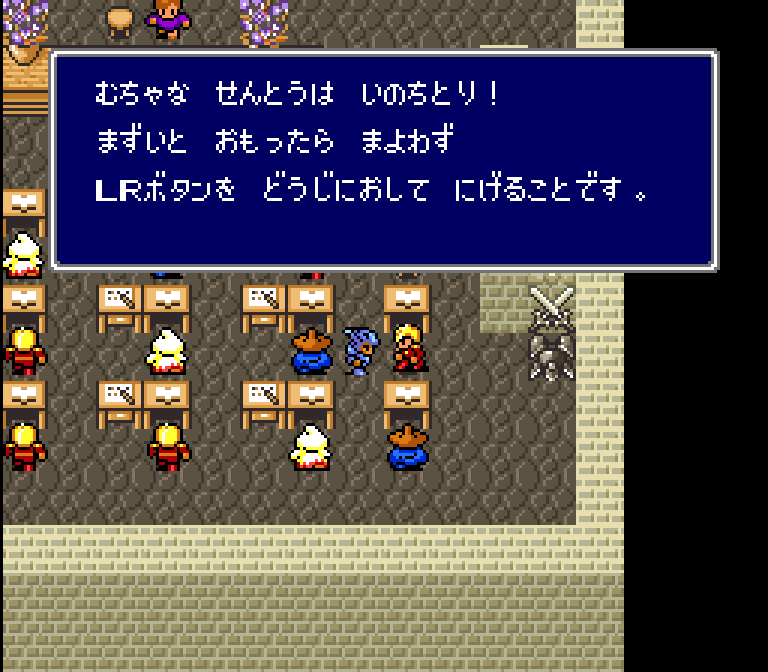 | 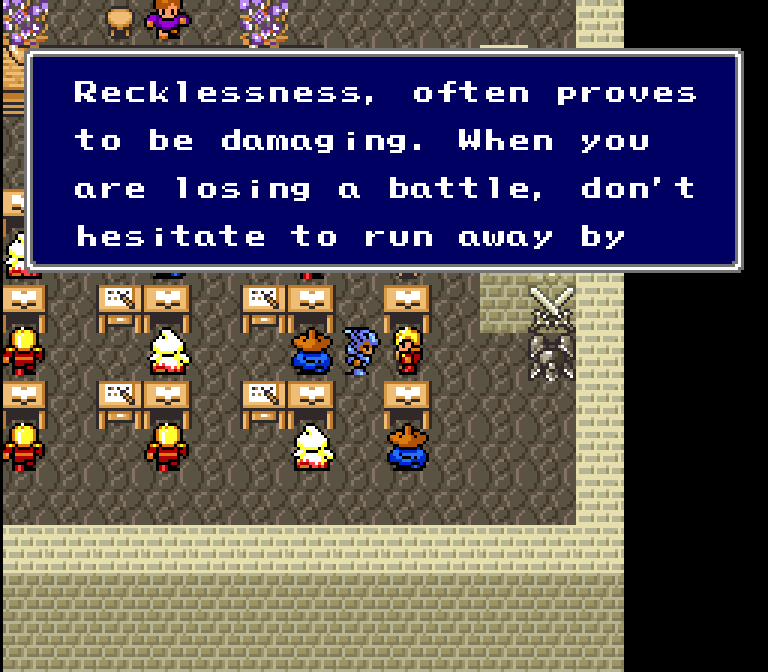 |
| Final Fantasy IV (Super Famicom) | Final Fantasy IV Easy Type (Super Famicom) | Final Fantasy II (Super NES) |
| Japanese Version (basic translation) | English Translation |
| Reckless fighting can prove fatal! | Recklessness, often proves to be damaging. |
| If things start to look bad, don’t hesitate to run away by pressing the L and R-Buttons simultaneously! | When you are losing a battle, don’t hesitate to run away by pushing L and R-Buttons at the same time. |
The text isn’t that different. I guess I can point out that commas are another thing that non-native translators often have trouble with. Hell, even native speakers do. But it’s another one of those things that makes a difference between native and non-native translators.
But the actual point of interest here is that there’s a slight difference in the two Japanese versions. It’s not by much, but the Final Fantasy IV Easy Type version of the text is more formal and proper. This is seen in the use of desu and the change from the exclamation mark to a Japanese-style period.
It seems this sort of polite-ization happened elsewhere in this expanded training room too, but not always.
Casting Magic
This white mage gives some info on how to cast magic on multiple targets:
| Final Fantasy IV (Super Famicom) | Final Fantasy IV Easy Type (Super Famicom) | Final Fantasy II (Super NES) |
| Final Fantasy IV (basic translation) | Final Fantasy IV Easy Type (basic translation) | Final Fantasy II (Super NES) |
| Also, there are some spells that can be cast on all targets. | There are some spells that can be cast on all targets. | There are spells which can be used for all. |
| In battle, press left to cast on all enemies or press right to cast on all allies! | In battle, press left to cast on all enemies or press right to cast on all allies! | In the battles, you can cast the spell on all enemies by pushing the Control Pad to left, and all allies to right. |
| When using spells in menus too, if you press Left or Right you can cast on all your allies! | Even when using restorative magic outside of battle, if you press Left or Right you can cast on all your allies. | On Menu Screen, you can cast spells to all by pushing either left or right. |
The English line definitely has some wonky writing – it almost makes it sound like it’s saying to push left on the control pad or to push your allies to the right.
That aside, the Final Fantasy IV Easy Type line is a little more informative than the original Japanese text. We also see in the Japanese text here that the Easy Type version has been altered slightly to use a more polite, formal tone. Except it looks like they only half-changed it; the last sentence still retains its less formal form. Huh.
Lastly, “in the battles” stands out a bit as non-native writing. In Japanese, there’s no difference between singular and plural nouns, so plurality is another thing that non-native translators often get wrong. If you’ve played old games, you’ve probably run across this without realizing it.
So how do you specify if something is plural in Japanese if you absolutely need to? There are ways to do it, usually involving counting words. But in most cases the exact same word is used for singular and plural nouns.
Changing Formation
Another hint in all three versions of the game is about how to change your formation in battle:
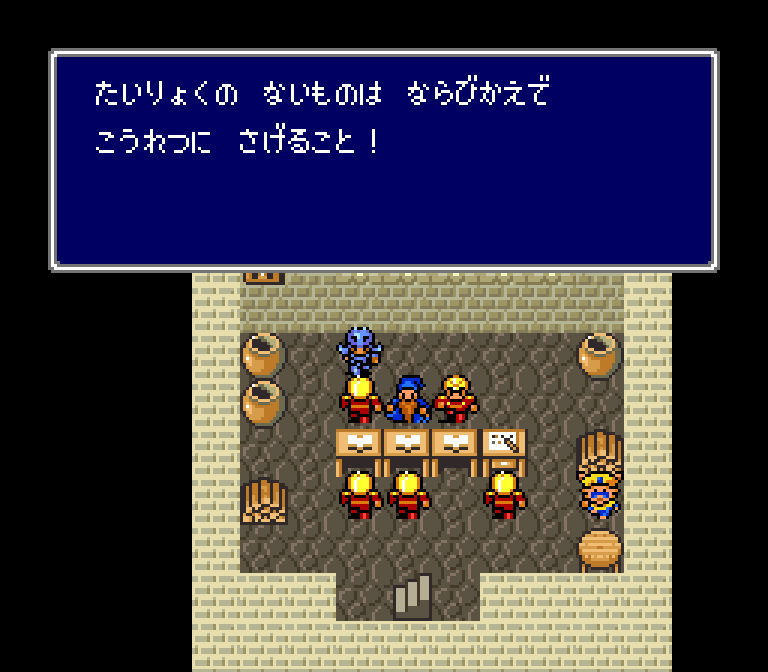 | 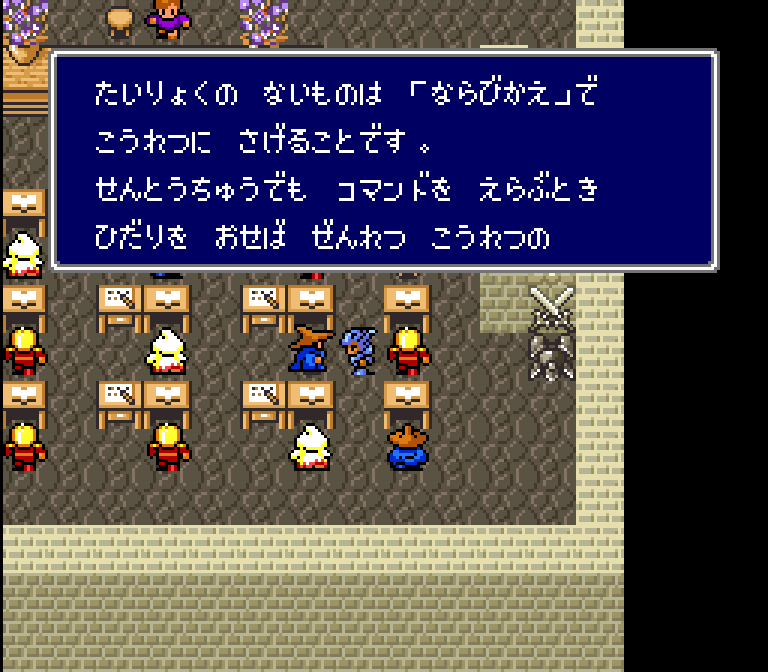 |  |
| Final Fantasy IV (Super Famicom) | Final Fantasy IV Easy Type (Super Famicom) | Final Fantasy II (Super NES) |
| Final Fantasy IV (basic translation) | Final Fantasy IV Easy Type (basic translation) | Final Fantasy II (Super NES) |
| Use Rearrange to place those low on strength in the back row! | Use “Rearrange” to place those low on strength in the back row. | You should move the people with less HPs to the back by using the Change command. |
| Even when choosing commands in battle, if you press Left you can change the front row and back row. | Even when choosing commands in battle, if you press Left you can “Change” the front row and back row formation. | During the battles, you can Change the front and rear row by pushing the left Control Pad when in turn. |
| If you press Right, you can defend! | If you press Right, you can “Defend”! | By pushing to the right, you can select Parry. |
There’s a lot of stuff here:
- Easy Type has slightly more polite text this time too.
- The various commands are in Japanese quote marks in Easy Type. This helps the words stand out more clearly.
- The Japanese version essentially teaches you two techniques: Rearrange and Change. Rearrange lets you put a character in a specific slot. Change lets you swap the front and back rows. The English text only explains how “Change” works.
- This is because the English version translates “Rearrange” as “Form” and “Formation” as “Change”. Kind of odd, but whatever.
![Image 1]()
![Image 2]()
Final Fantasy IV (Super Famicom) Final Fantasy II (Super NES) - We also see that “Defend” becomes “Parry” in the English translation. This was actually where I first learned the word “parry” in English. It sort of gave me the wrong impression of the actual meaning, though. I suppose “Parry” was chosen because “Defend” was too long.
Battle Speed
There’s another helpful hint in all three versions of the game concerning battle speed:
 |  | 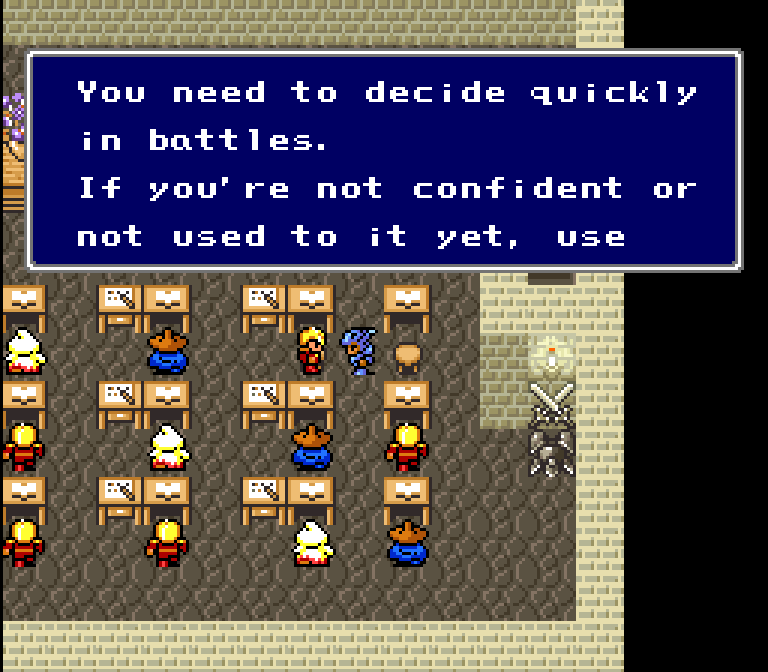 |
| Final Fantasy IV (Super Famicom) | Final Fantasy IV Easy Type (Super Famicom) | Final Fantasy II (Super NES) |
| Final Fantasy IV (basic translation) | Final Fantasy IV Easy Type (basic translation) | Final Fantasy II (Super NES) |
| Quick decision-making is essential in battle! | Quick decision-making is essential in battle! | You need to decide quickly in battles. |
| Those who aren’t confident should lower the battle speed! For those who ARE confident, if you go to Config on the menu and set the battle mode to Active, then you’ll be able to enjoy thrilling battles in which monsters will attack even while you’re choosing magic and items! | Those who aren’t confident should press the X-Button to open the menu, go to “Config”, and lower the “Battle Speed”! For those who ARE confident, if you set “Battle Mode” to “Active”, then you’ll be able to enjoy thrilling battles in which monsters will attack even while you’re choosing magic and items! | If you’re not confident or not used to it yet, use the Menu Screen to reduce the Battle-speed! |
From this, we can see that the original text was expanded upon and made clearer for Final Fantasy IV Easy Type. The English localization kind of muddies everything up and doesn’t make it quite as clear how to do get to the necessary config option.
The English translation also leaves out the part about setting the Battle Mode to “Active”. This is because “Active” is the only battle mode in the English localization. For some reason they took the “Wait” mode out, or at least removed the option entirely from the config screen.
So this is one of those cases where Final Fantasy II is different from both Final Fantasy IV and Final Fantasy IV Easy Type. It’s clear by now that Final Fantasy II is a creature all its own, based partly on Final Fantasy IV, partly on Easy Type, and partly on its own new things.
Enemy Weaknesses
This guy talks about monster weaknesses. What he says in both languages is slightly different:
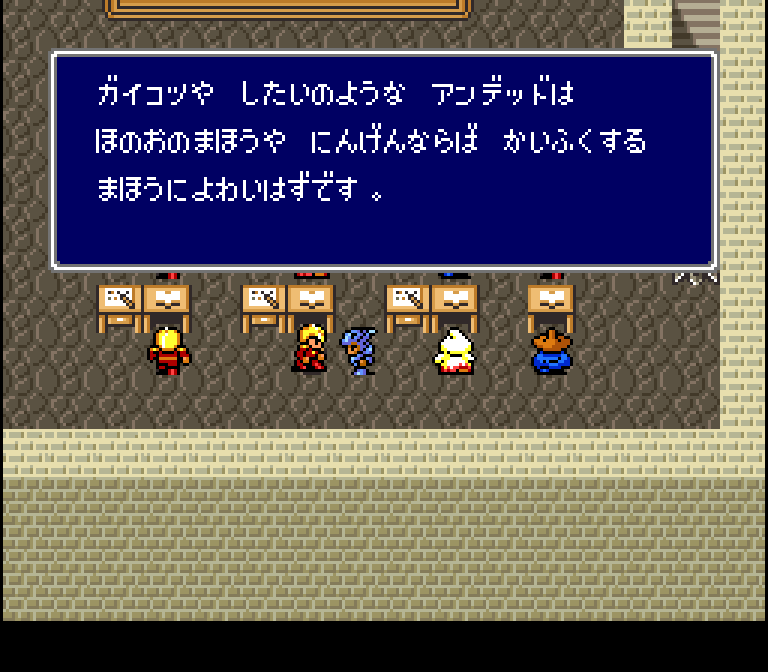 | 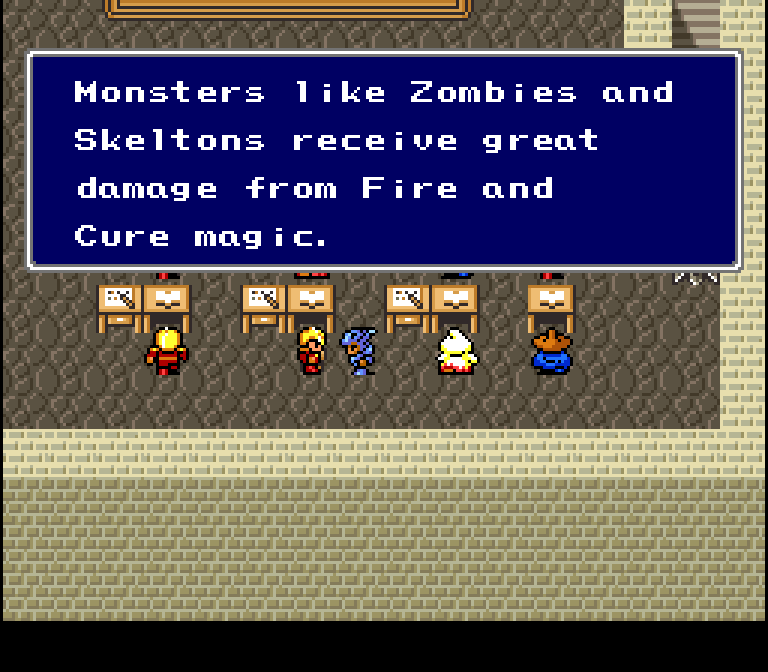 |
| Final Fantasy IV (Super Famicom) | Final Fantasy II (Super NES) |
| Japanese Version (basic translation) | English Translation |
| Undeads like skeletons and corpses should be weak against fire magic and spells that heal humans. | Monsters like Zombies and Skeltons receive great damage from Fire and Cure magic. |
Here we see that “corpse/dead body” was changed to say “Zombie” and that the word “undead” was changed to “monsters”. Of more interest is that “skeletons” became “Skeltons”. This is either a typo or a reference to the fact that some enemy names had to use the word “Skelton” because “Skeleton” was too long.
Lastly, we see that the English translation sort of simplifies things and straight-out says to use Cure magic. This gameplay tip is one of the most important in the game, as taking advantage of enemy weaknesses is a big part of battles. I remember wondering why enemy weaknesses didn’t work so well in the original Final Fantasy, so I probably wouldn’t have paid much attention to enemy weaknesses in this game had it not been for this guy.
Equipment Change
Another somewhat neat tip that’s given in all three games is how to change equipment in battle – at least equipment that’s in your hands, anyway:
 | 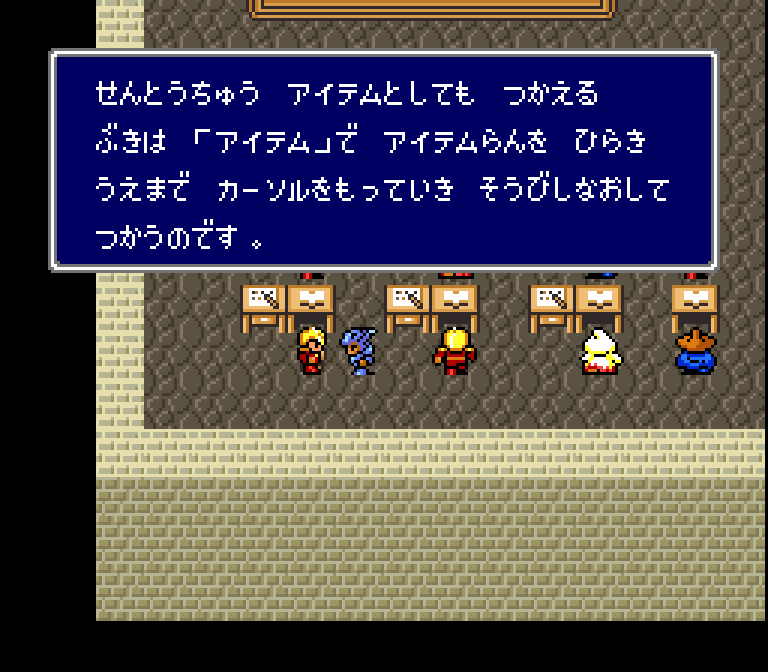 | 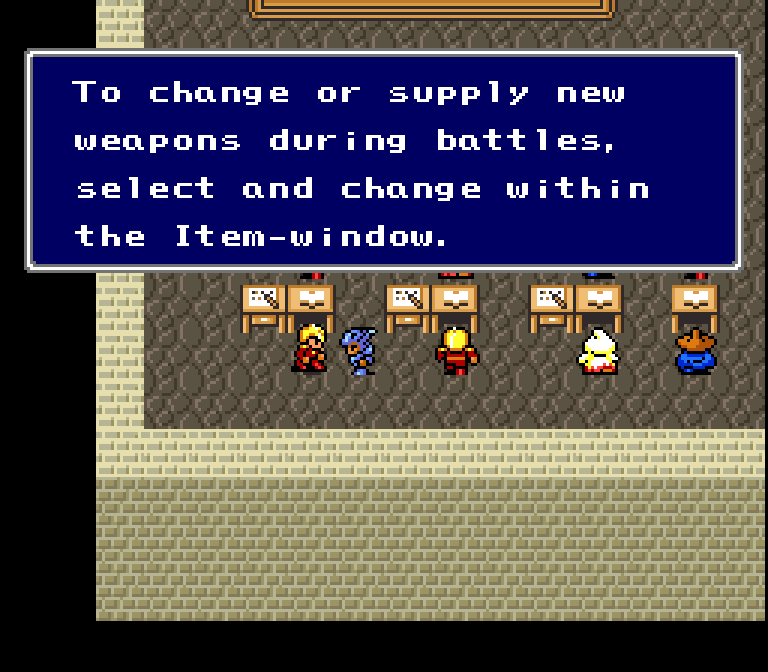 |
| Final Fantasy IV (Super Famicom) | Final Fantasy IV Easy Type (Super Famicom) | Final Fantasy II (Super NES) |
| Japanese Version (basic translation) | English Translation |
| Also, for weapons that can be used as items, use them by choosing “Item” to open the item list, moving the cursor to the top, and reequipping it! | To change or supply new weapons during battle, select and change within the Item-window. |
The Japanese tip is a little odd. Some weapons have special powers when used in battle like items, and it seems to be telling you this. But then it also seems to be talking about how to change your equipment, which uses basically the same process.
Whatever the case, it’s definitely more helpful than the English translation – I’m not quite sure what “supply new weapons during battles” even refers to. It’s not in the original text, either, so it’s pretty strange.
Lastly, here we have another case of the Final Fantasy IV Easy Type text using slightly more formal speech than the original Final Fantasy IV text.
Upset Old Man
 |  |
| Final Fantasy IV (Super Famicom) | Final Fantasy II (Super NES) |
In English, this old man in Baron says: “Why is the King training the soldiers how to use the sword of dark side?”
In Japanese, it’s more like, “Teaching soldiers the way of the Dark Sword! Just what is the king thinking?!”
So far, the English translation has sort of brushed aside this “dark sword” stuff, but here we see that it’s been called “the sword of dark side”.
The Japanese text also shows the old man’s disgust better.
Also, this man speaks in a stereotypical “old man” way in Japanese, but that’s not brought across in the English localization. For more about Japanese speaking styles, see this explanation I wrote on my page about Zelda’s localization.
Cid’s Daughter
Cid’s daughter has a lot to say when you visit Cid’s house:
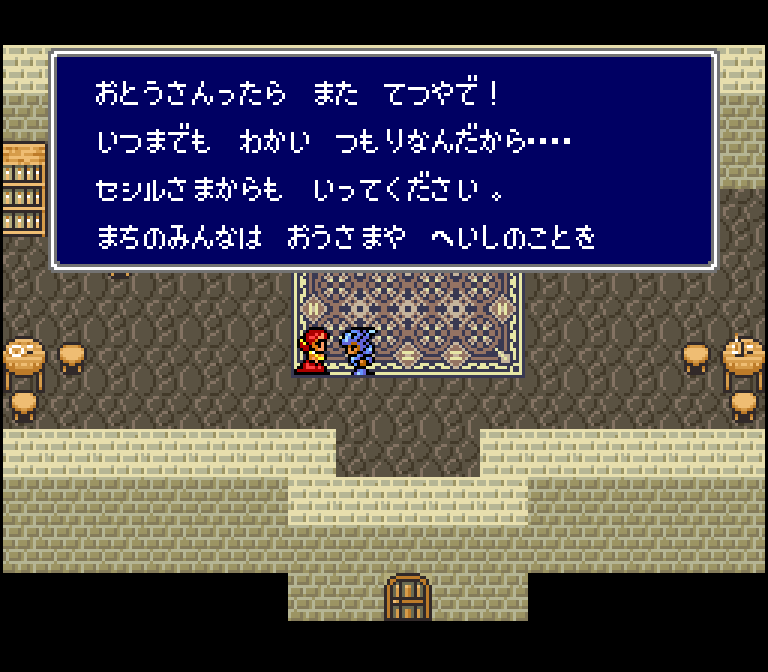 | 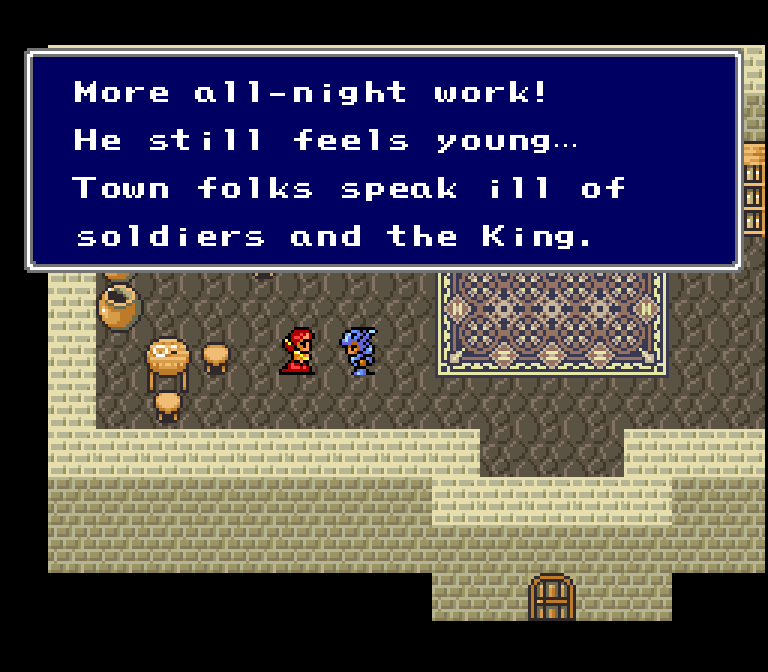 |
| Final Fantasy IV (Super Famicom) | Final Fantasy II (Super NES) |
| Japanese Version (basic translation) | English Translation |
| Sheesh, Dad pulled another all-nighter! He just keeps acting like he’s young… | More all-night work! He still feels young… |
| Could YOU give him a talking to, Sir Cecil? | |
| Everyone in town talks badly about the king and the soldiers, even though there are lots of nice people like you too… | Town folks speak ill of soldiers and the King. |
| Dad sometimes gets into arguments with the townspeople because of that. | My father often quarrels with them for that. |
So we see that in the original text she asks Cecil to give Cid a talking to because he won’t listen to her. This was taken out of the English translation.
She also talks about how she knows that there are nice people like Cecil too. This is in stark contrast to how a lot of the other townspeople have treated Cecil – usually with fear. This, too, was left out of the English translation.
Snoring Cid
 | 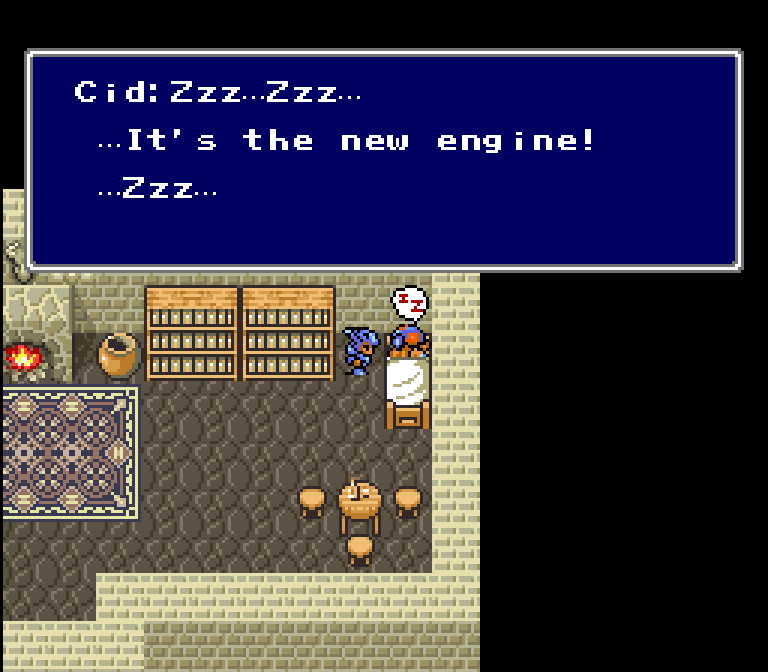 |
| Final Fantasy IV (Super Famicom) | Final Fantasy II (Super NES) |
If you talk to Cid while he’s in bed, he’ll say in English: “Zzz… Zzz… …It’s the new engine! …Zzz…”
It’s not much different in Japanese, but he says something like: “Zzz… Zzz! All finished! The new model engine! Zzz… Zzz…”
Basically, the original text makes it more clear that he’s dreaming that he’s completed the new type of engine that he’s been working on for the king.
Chocobo Catch
 |  |
| Final Fantasy IV (Super Famicom) | Final Fantasy II (Super NES) |
In English, when you manage to catch a Chocobo, it says, “Chocobo!”
In Japanese, it’s more like, “Found a Chocobo!” Except the word used is a special version of “I found a…”, which is said in a happy tone. Just reading it I can imagine a young kid saying this out loud.
Chocobo Food
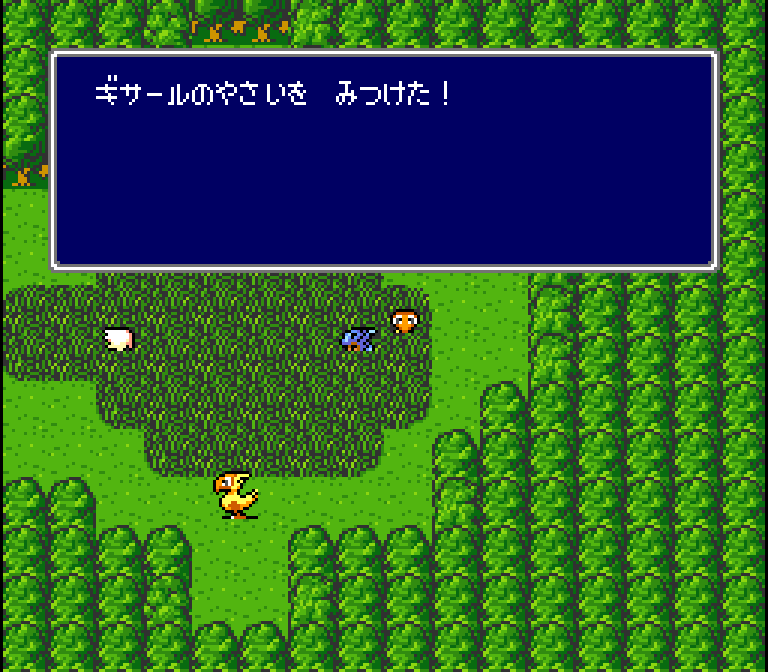 | 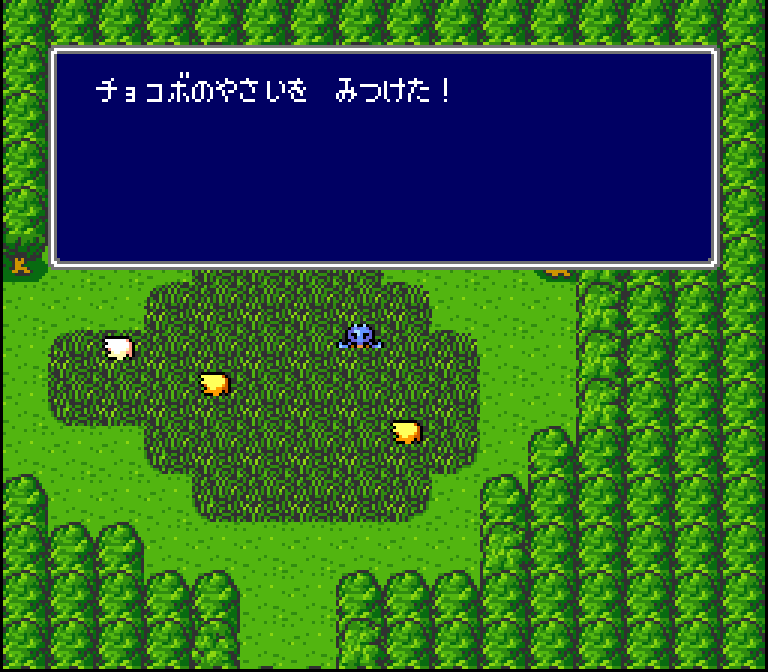 | 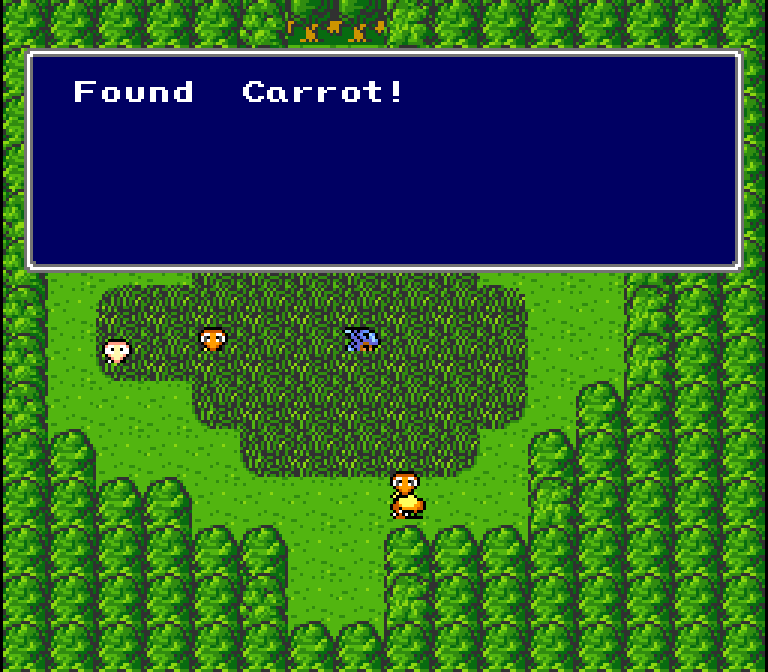 |
| Final Fantasy IV (Super Famicom) | Final Fantasy IV Easy Type (Super Famicom) | Final Fantasy II (Super NES) |
As we saw briefly earlier, the item used to summon the big Chocobos is called a “Gysahl Vegetable” in Final Fantasy IV, a “Chocobo Vegetable” in Final Fantasy IV Easy Type, and a “Carrot” in Final Fantasy II.
Gysahl was a town in Final Fantasy III for the original Famicom. Since Final Fantasy IV Easy Type is meant for new players, the developers probably assumed it would make more sense to tie the name in with Chocobos rather than with a past game players probably never played before.
That same reasoning, along with the fact that item names have to be really short, is probably why it was called a “Carrot” in the English localization.
Fat Chocobo
The big, hidden Chocobo in Chocobo forests will hold on to your items for you.
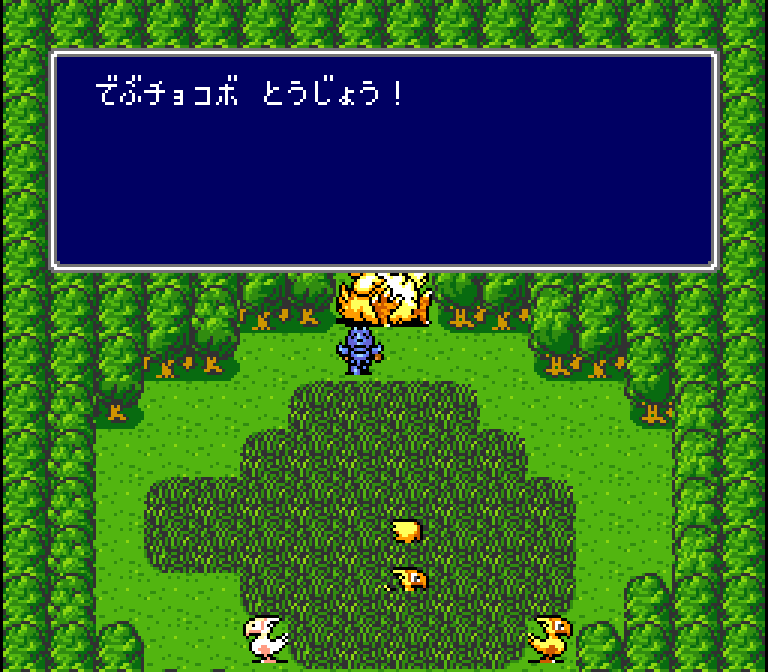 |  |
| Final Fantasy IV (Super Famicom) | Final Fantasy II (Super NES) |
In English, this bird is called a “Big Chocobo”. In Japanese, it’s called a “Fat Chocobo”.
If you look at its sprite, you’ll also see something coming out of its mouth:
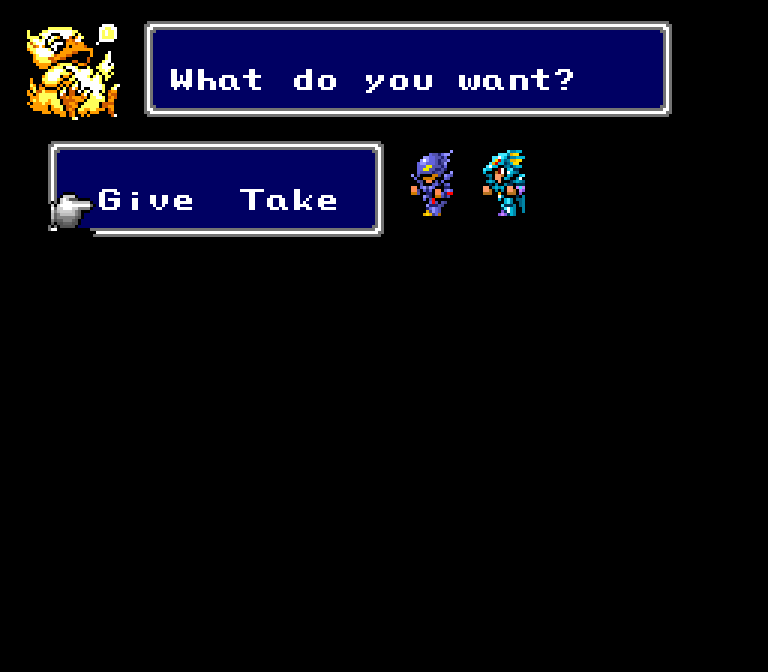
It probably doesn’t need mentioning, but this is a common thing used in Japanese comics, etc. to show someone making a sound of exhausted relief or to indicate burping after eating lots of food:
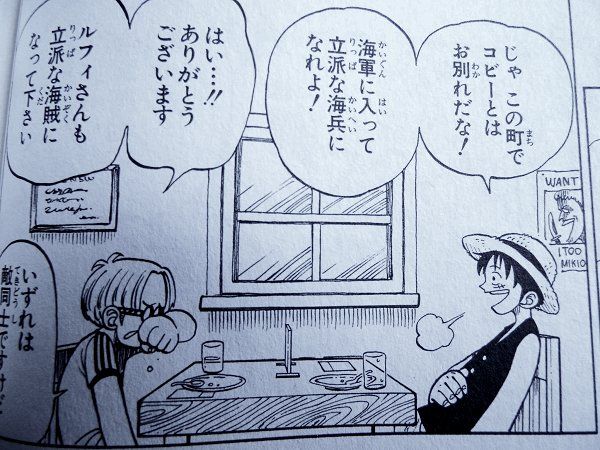
This reinforces the idea that it’s a “fat” Chocobo rather than just a large-sized one.
On top of that, in Japanese the Fat Chocobo talks in a deep, slow voice like you might expect some really giant, fat creature to sound like.
It’s a little harder to bring that across in translation, especially when you have so little space for text, so this didn’t make it into the localization.
In this first Japanese screenshot, he says something like, “Heeeey, yoooou want something?”:
 | 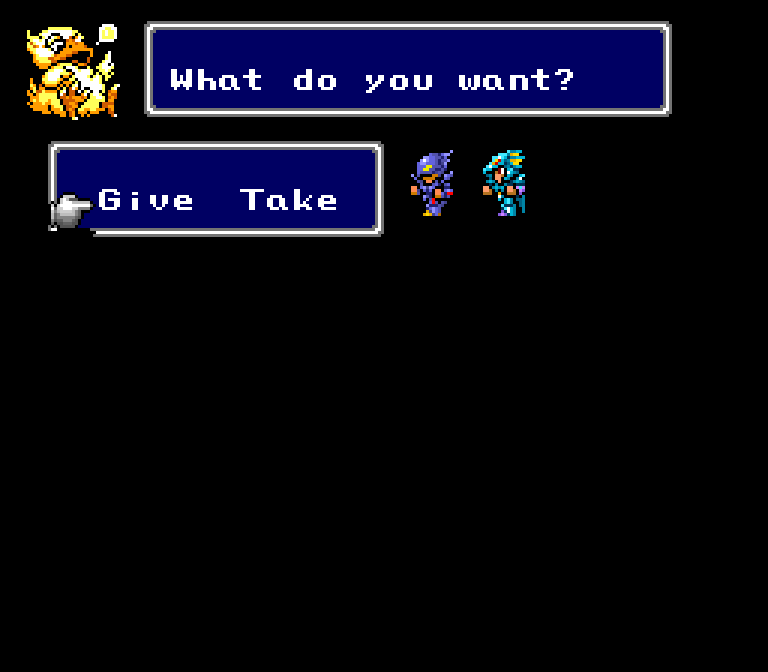 |
| Final Fantasy IV (Super Famicom) | Final Fantasy II (Super NES) |
In this second screenshot, he says something like, “What’ll you give meeee?”:
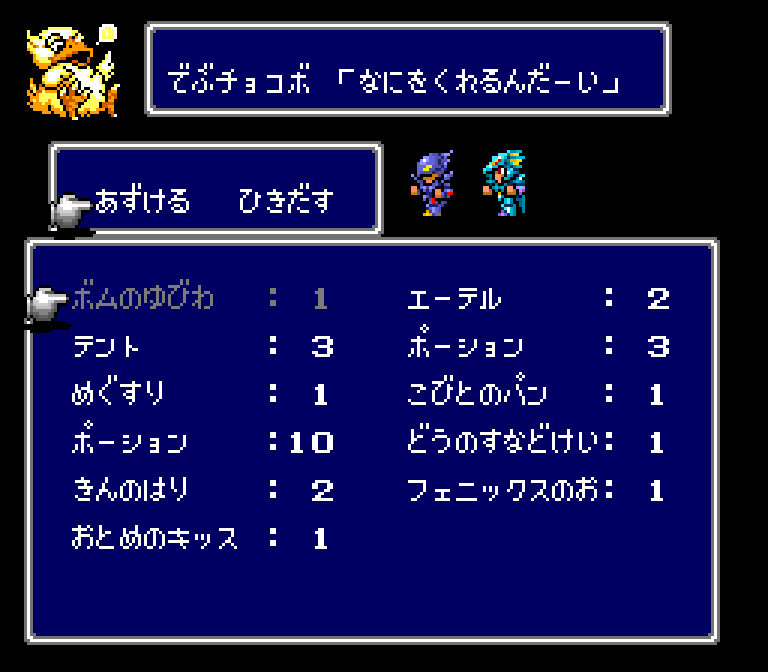 | 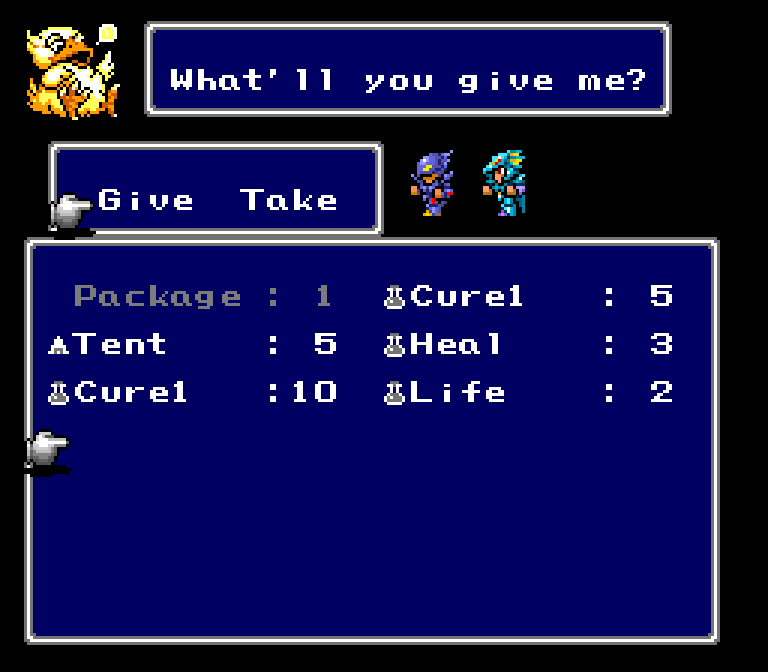 |
| Final Fantasy IV (Super Famicom) | Final Fantasy II (Super NES) |
And in this third one he says, “What do yooou want?”:
 | 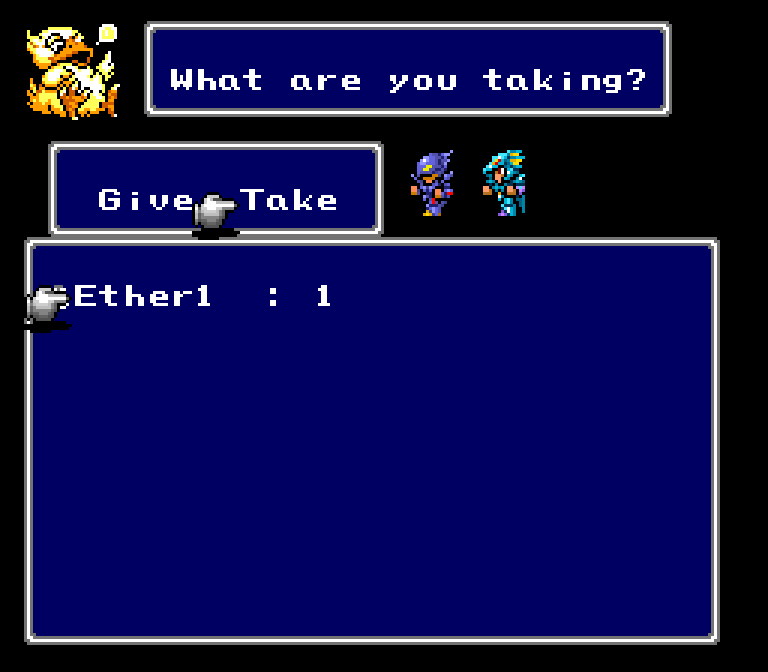 |
| Final Fantasy IV (Super Famicom) | Final Fantasy II (Super NES) |
I can almost actually hear how he would sound speaking in Japanese, but in English it’s tougher for me to convey it well. I imagine something like the big ghost that visits Uncle Scrooge in that old Disney version of A Christmas Carol.
Anyway, all that aside, we also see that while the English localization struggles to fit the Chocobo’s text into the window, the Japanese version has so much extra space that it can even add “Fat Chocobo:” to the beginning of the text. Sometimes it’s convenient how concise Japanese can be.
Incidentally, Fat Chocobos first appeared in Final Fantasy III for the Famicom too, not just the Gysahl Vegetable:
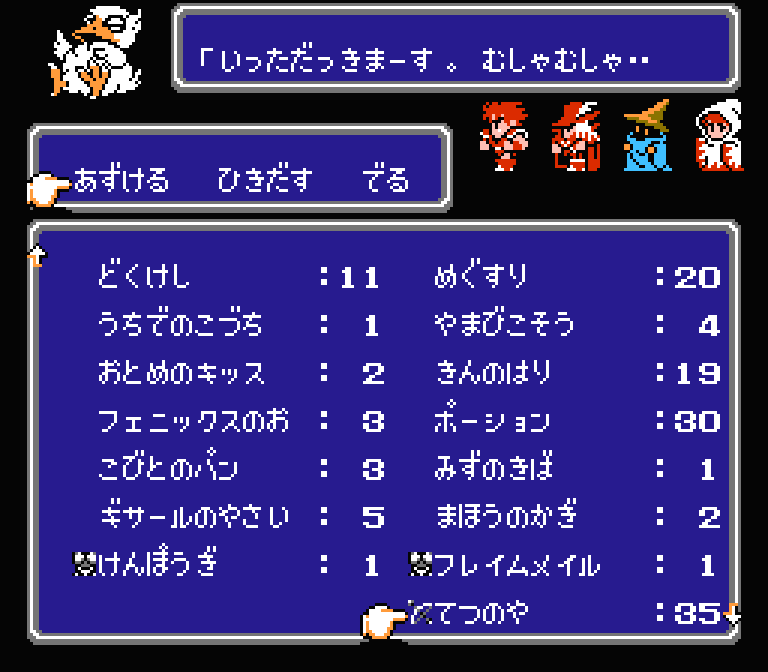
Darkness Battle Command
At last, the time has come to set out on the adventure!
Right off the bat you’ll notice that Cecil has an extra battle skill in Final Fantasy IV and Final Fantasy IV Easy Type: “Darkness”.
 |  | 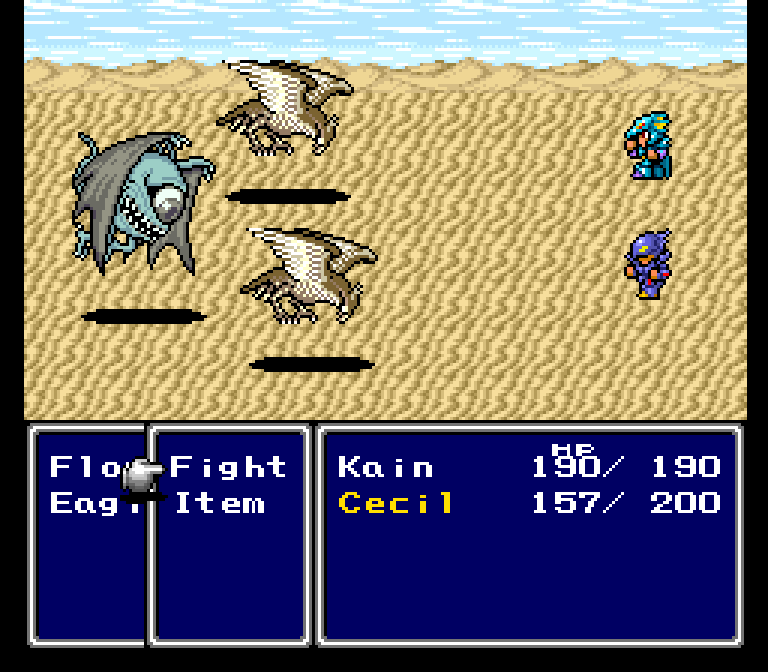 |
| Final Fantasy IV (Super Famicom) | Final Fantasy IV Easy Type (Super Famicom) | Final Fantasy II (Super NES) |
This attack lets Cecil attack all enemies with a wave of energy. But after he’s executed it, he loses a small amount of HP (about 1/8th of his HP I think), so it’s important not to overuse it:
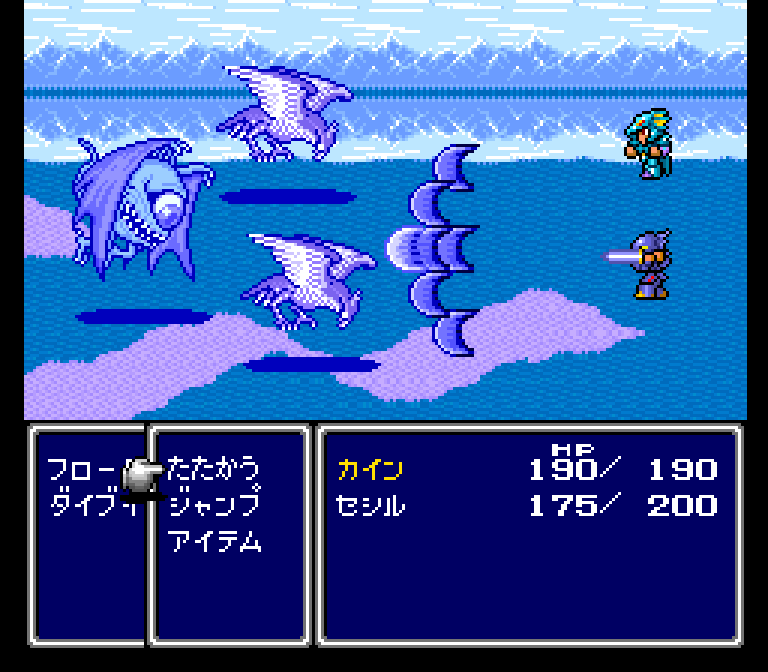
This skill was taken out of the English localization for reasons unknown. Did the localizers feel that the idea of your own attacks reducing your HP might confuse players, especially right at the start of the game? Or was it something else? I’d love to know, so let me know if you have any insight!


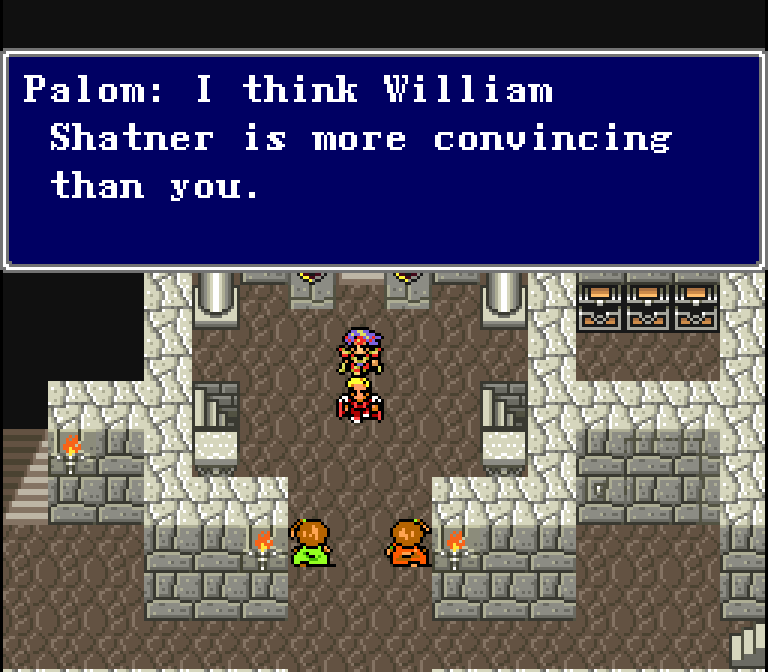
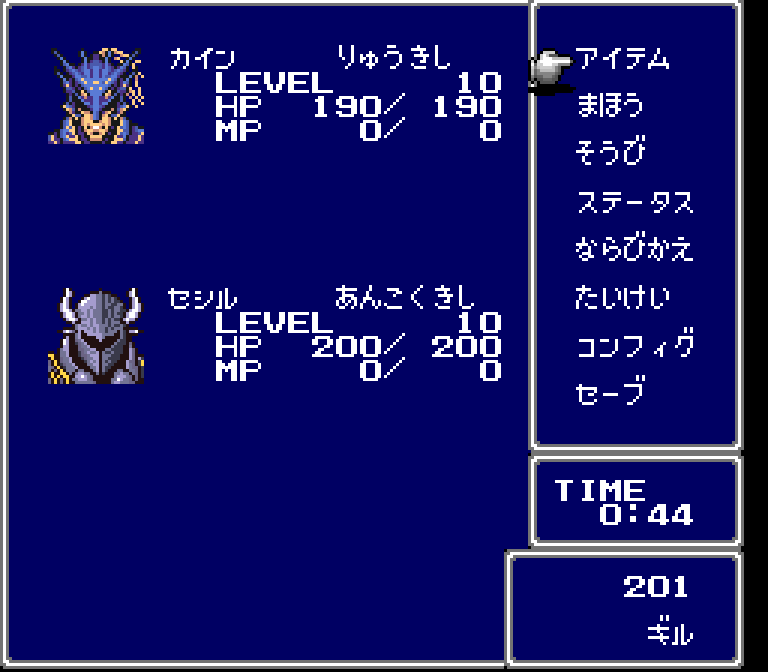
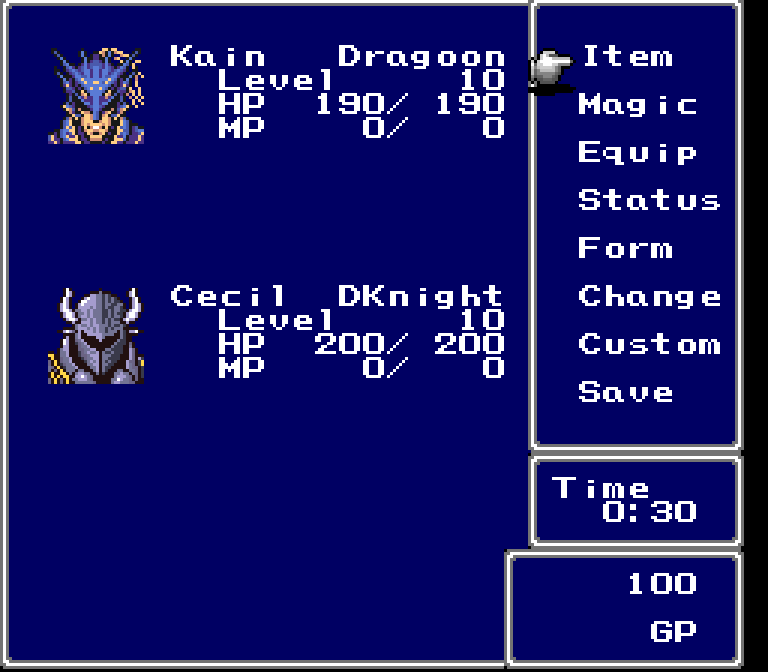
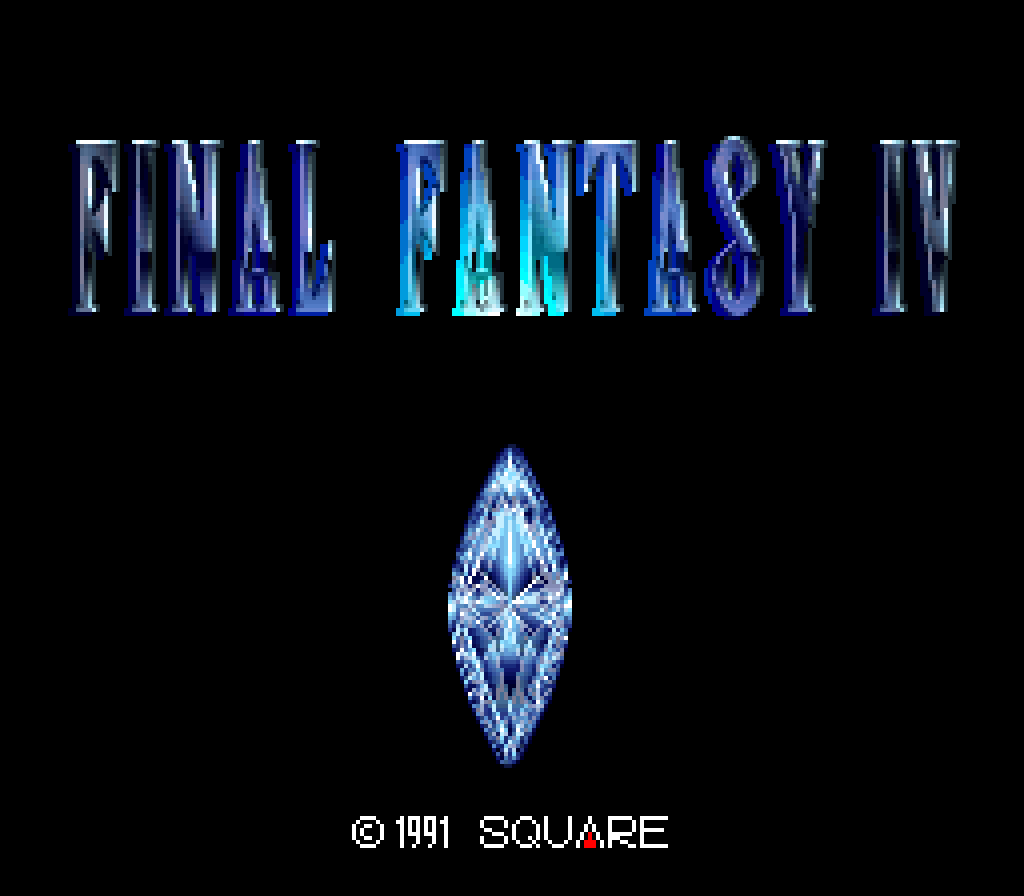
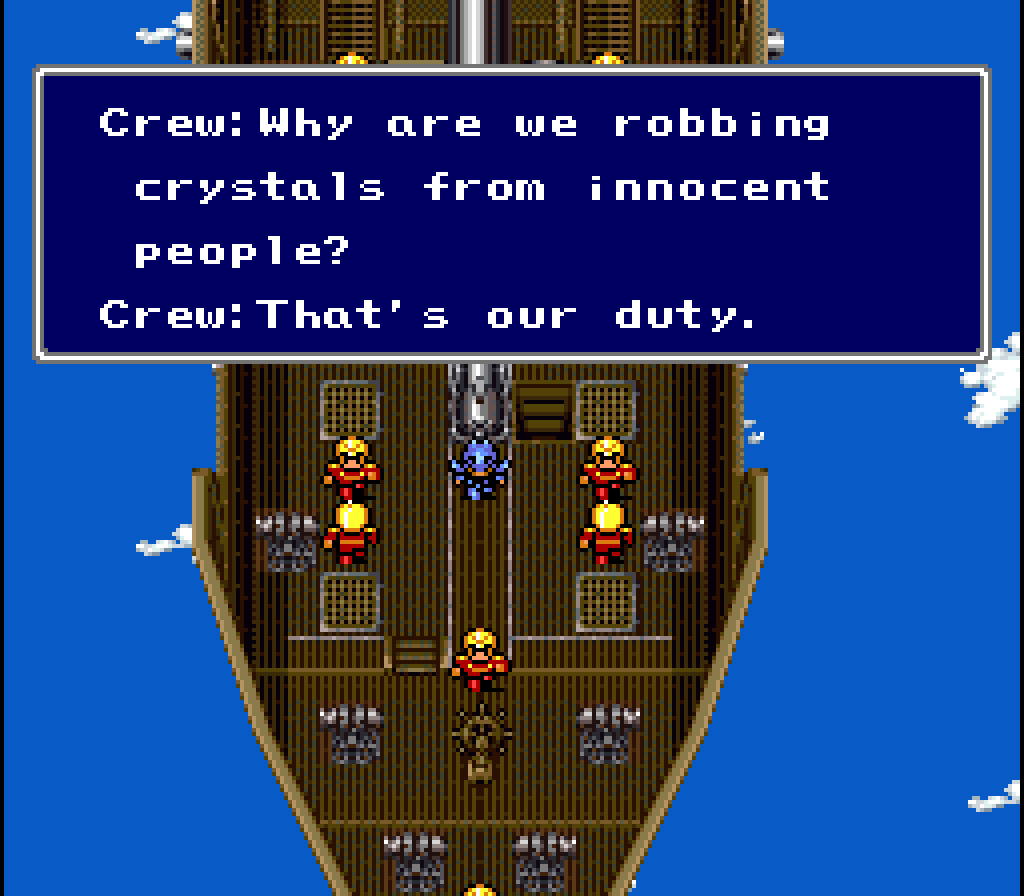
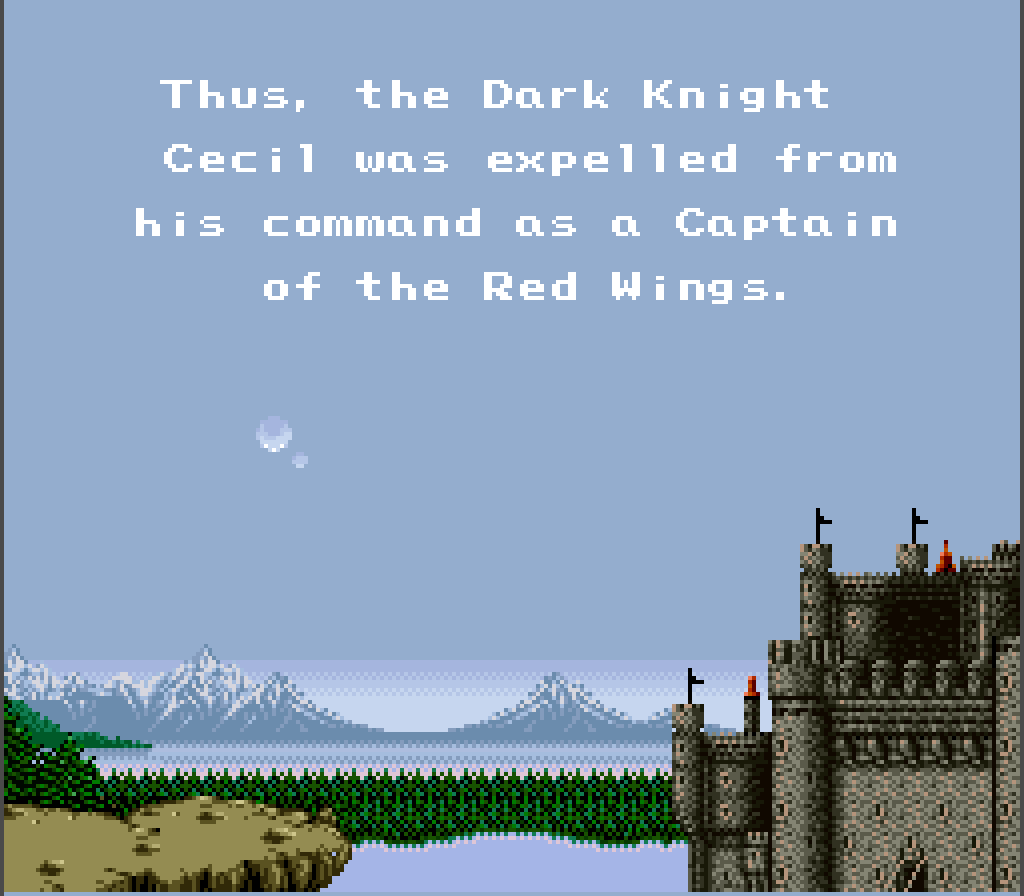
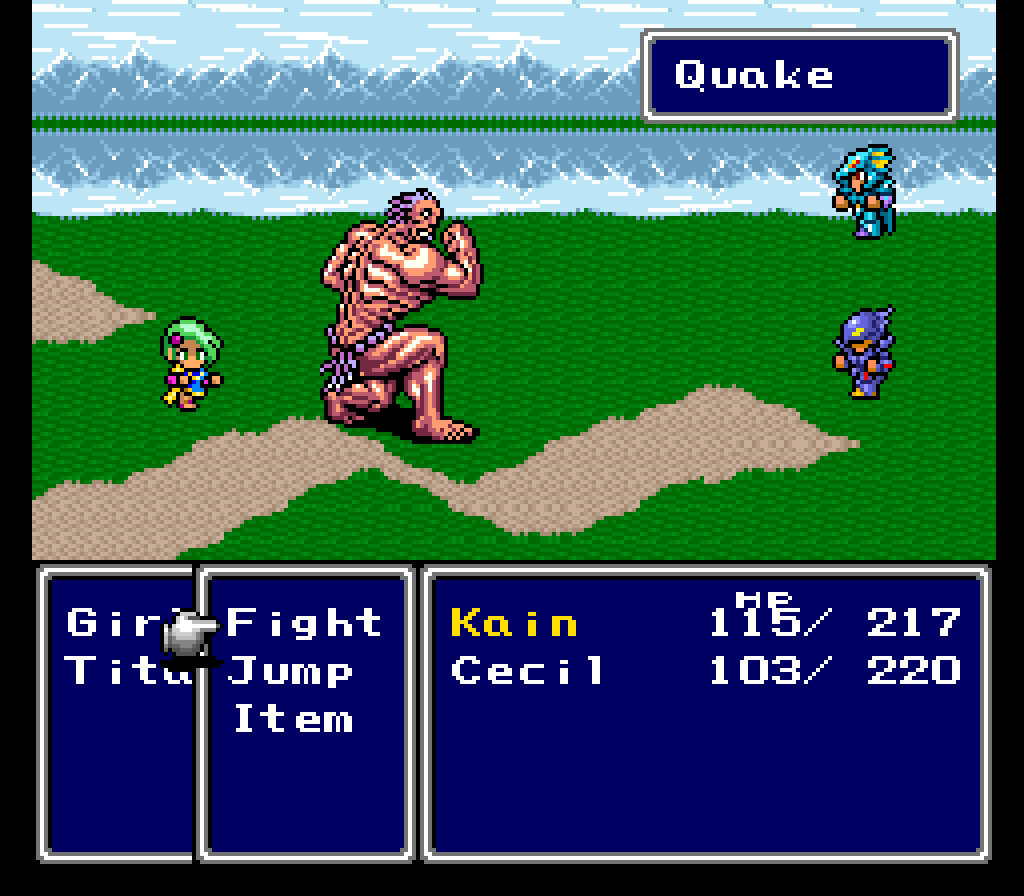
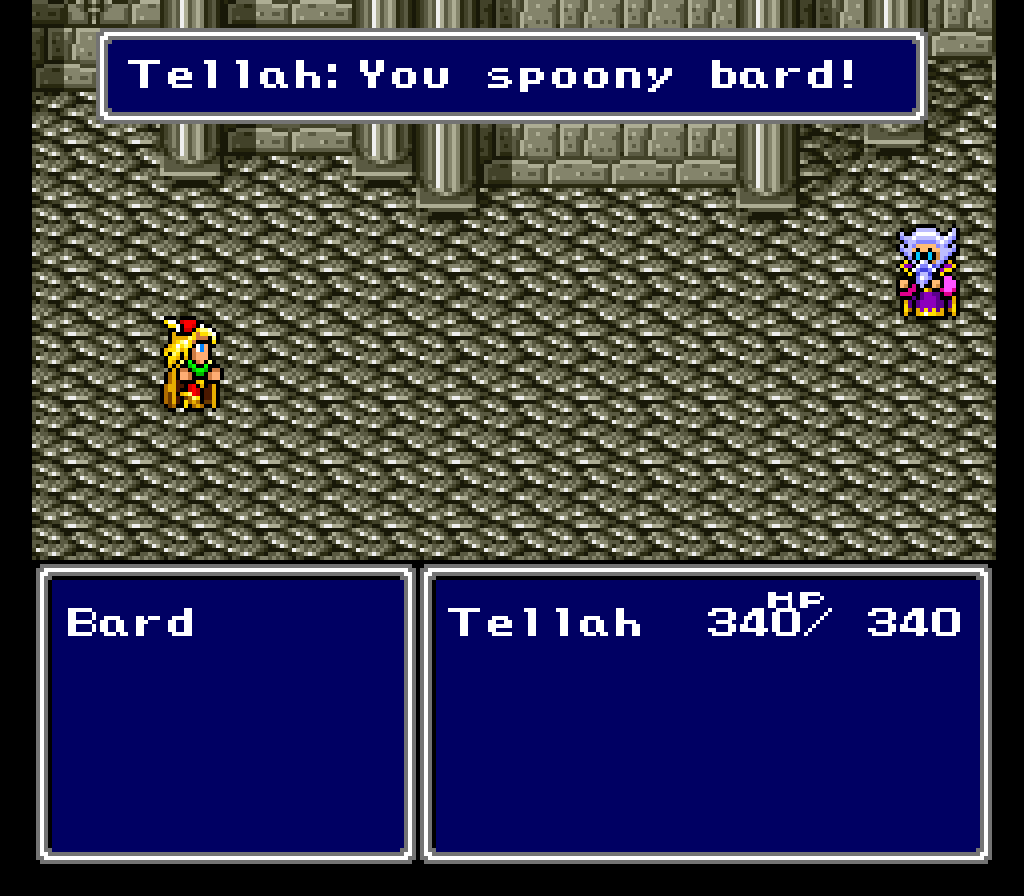
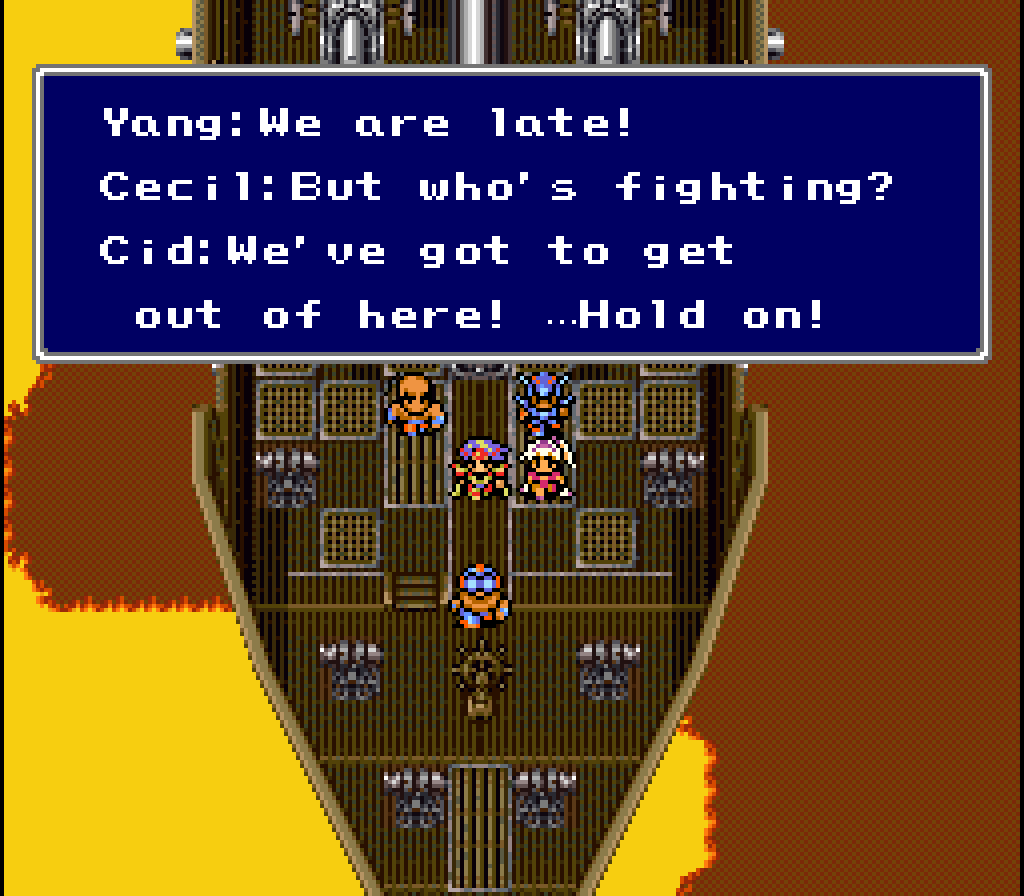
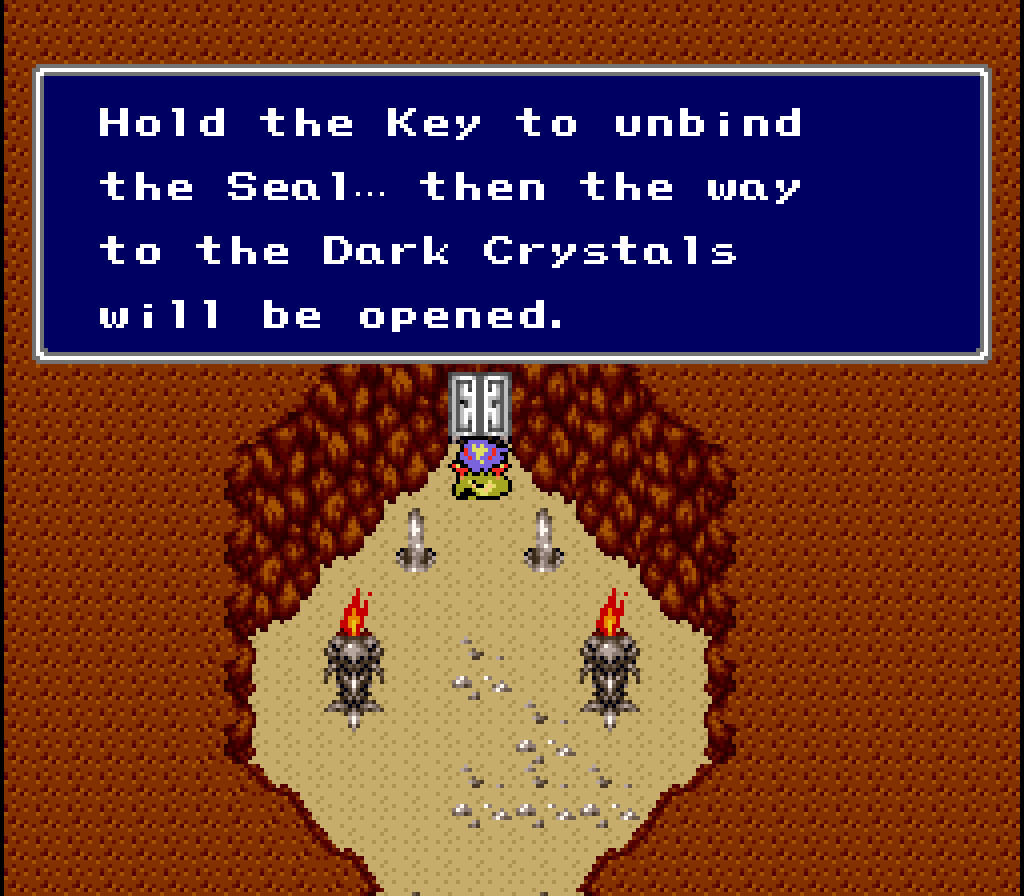
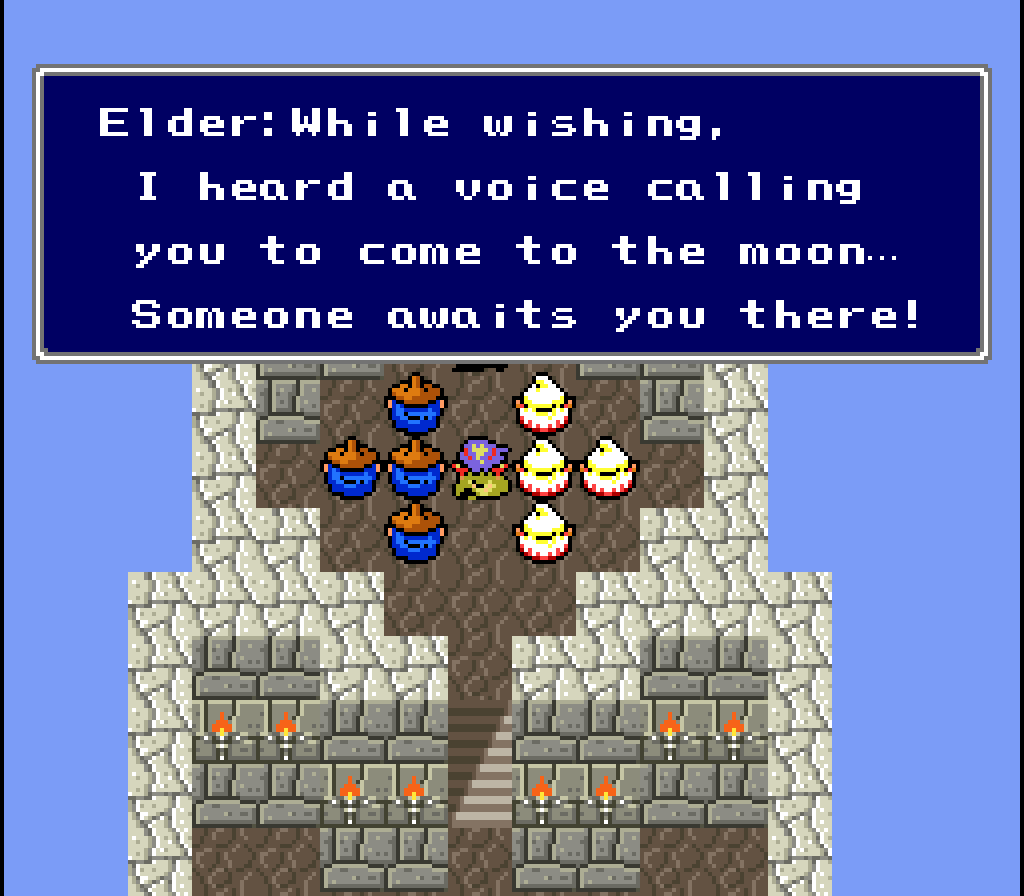
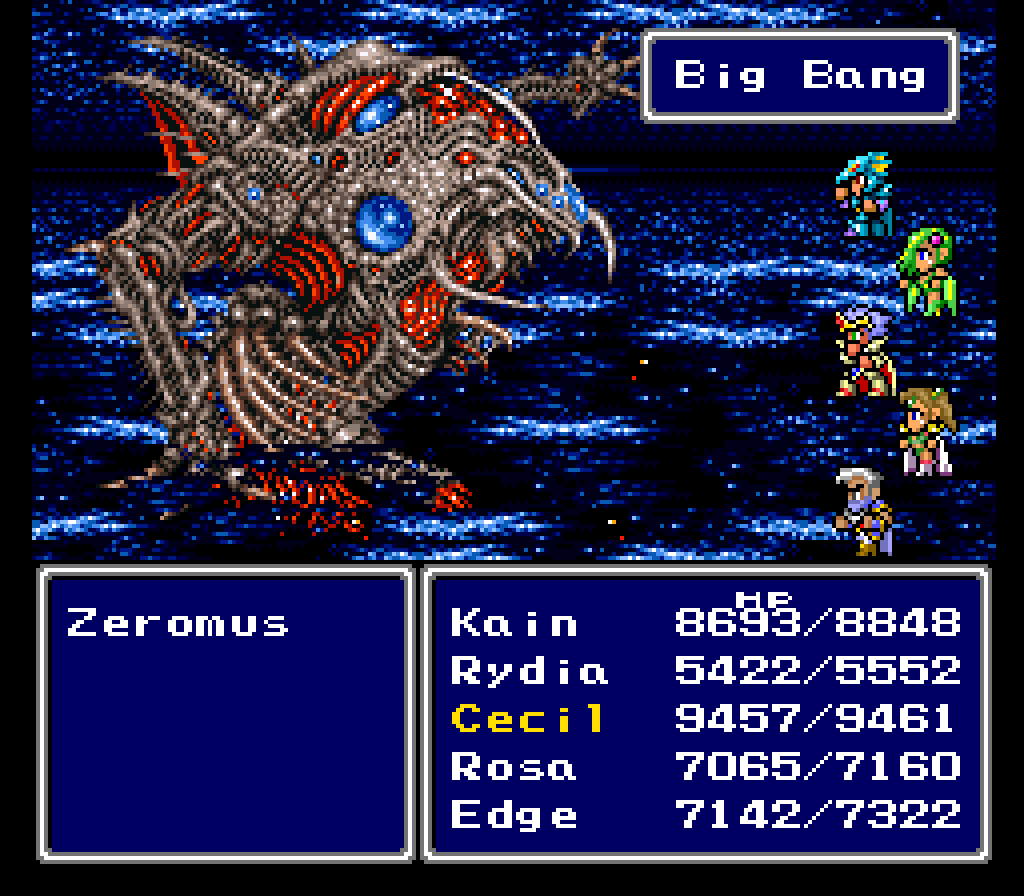
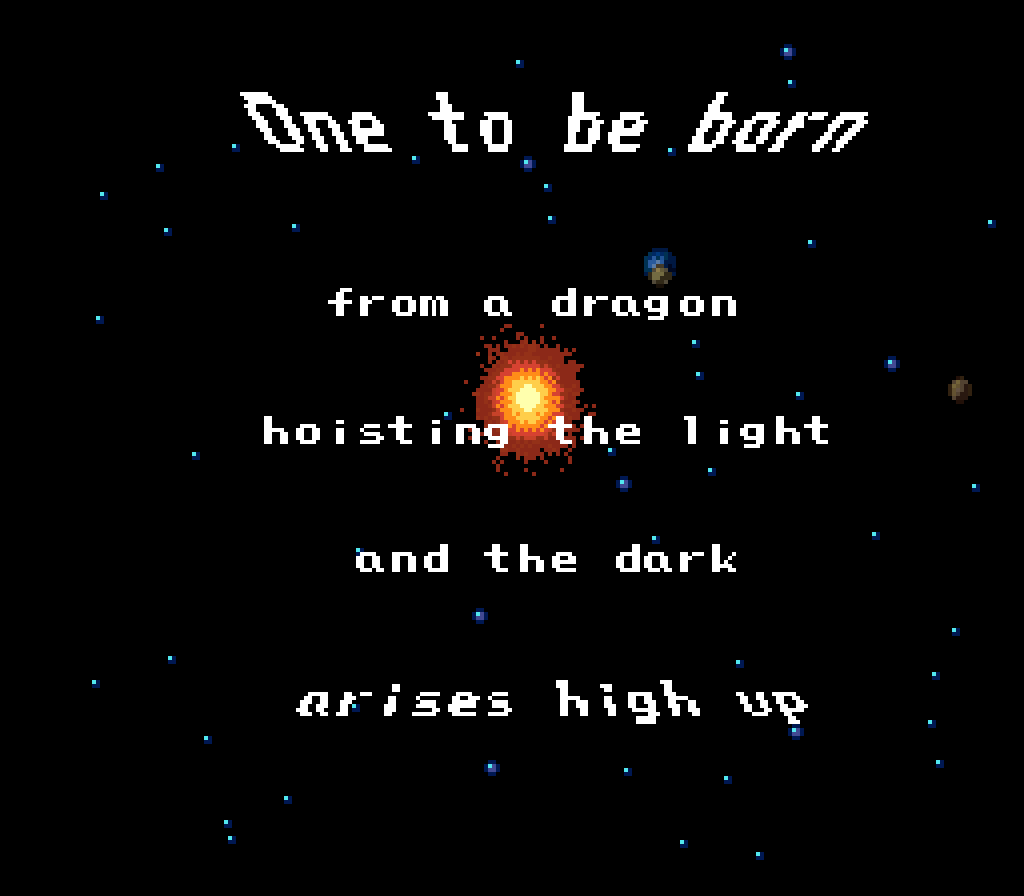
![press start to translate [Final Fantasy IV] press start to translate [Final Fantasy IV]](https://legendsoflocalization.com/wp-content/uploads/2019/08/bbenma.png)
Hello
I recently purchased a Japanese copy of the Final Fantasy IV PSP version. I noticed that the text is in English (could be due to my PSP Region) and the dancer is uncensored here. If that’s the case, I am just wondering is the translation more accurate? Does it still have the censored bits despite it being the Japanese version? Or is it the same as the American version?
The PSP translation is very close to the GBA translation, here’s some more info: https://legendsoflocalization.com/which-final-fantasy-iv-translation-should-you-play/#final-fantasy-iv-playstation-portable
For the dancer herself, it indeed appears the clothes come off in the Japanese PSP release but not a/the Western version.
Japanese dance: https://youtu.be/trw1SUNaH-U?t=1056
Western dance: https://youtu.be/lmDiaW-VXFI?t=876
“Dwarf bread”… is that a Discworld reference? It seems like the sort of thing that the developers would like.
There was one thing I always wondered about the Fat Chocobo. How exactly does it store your items? Does it keep some kind of giant chest or supply wagon with it?
Then I played the PlayStation version and saw that the two options were changed from “Give” and “Take” to “Feed” and “Barf”, which I found hilarious. But it seems plausible, like those kinds of performers who can swallow something and then force it back up on command.
In Final Fantasy III, it is confirmed he eats them. An NPC made a funny with that info.
You were mistaken. The default battle mode is always “Wait”, and that’s what it’s set in FFII US. Very easy to test.